Life on a Sailboat: Everything You Need to Know About Living on a Sailboat Full-Time
Living on a sailboat full-time is often romanticized as a life of endless sunsets, gentle waves, and freedom on the open sea. Many dream of casting off the lines and setting sail for a horizon of adventure and tranquility. However, the reality of life aboard a sailboat can be as challenging as it is rewarding, as frustrating as it is relaxing, and, more often than not, as mundane as it is exciting.
This blog post aims to peel back the curtain on the picturesque scenes to reveal what daily life is really like when you call a sailboat home. We will dive into the motivations, preparations, joys, and challenges of living on a sailboat full-time, providing a realistic glimpse into a lifestyle that is far from ordinary.

Our Live-Aboard Life
Our dream of living on a sailboat was a distant one for many years. But as we watched plans and dreams fall by the wayside in the wake of COVID, we made the decision to make our dream a reality. Once the borders opened up, we made a beeline for the Mediterranean and have since spent each summer living aboard our little 29-foot sailboat Whisper. Without any experience sailing or living on a sailboat, we have taught ourselves to sail and manage life on the boat along the way.
Before we took up sail life, we had been living “van life,” and we’ve come to realize there are lots of similarities but quite a few differences between the two . However, on the whole, learning to live van life first put us in good stead to take on life on a sailboat. Unlike most people, we up-sized when we moved onto a boat.
Despite the upgrade in living quarters, the learning curve and the adjustment to living on the sea were no less challenging. Nevertheless, the shift was not as scary as we thought it might be, and the reality of living on a sailboat full-time quickly became our new normal.
Initially, our plan was to buy a boat and spend one season aboard sailing the Mediterranean before selling the boat and settling down. Instead, it’s safe to say we have fallen in love with life on a sailboat. Now, as we enter our third season, we aren’t sure when we will be ready to furl the sails for good…
Get a Taste of Life on a SailBoat
We document some of the realities of living on a sailboat full-time on our YouTube Channel in our The Vanabond Sails series.
Deciding to Live on a Sailboat
The journey to becoming a full-time live aboard often starts with the desire for change.
Some people are transitioning from one stage of life to the next as careers wind up or children move out. Some yearn for adventure and excitement, while others seek a simpler way of life. Many are drawn to the promise of freedom, the allure of the sea, and the appeal of living more closely with nature. However, the decision to live on a sailboat full-time is not one to be taken lightly. It requires thoughtful consideration and planning.
For us, it was a long-held dream to sail and live aboard a sailboat. It was also a natural progression, having spent several years living and traveling by van . We were ready for a new challenge.
It began with a conversation, then a plan, and then trawling classifieds for second-hand boat sales. Before long, the decision was set in stone, and we were on our way to Croatia to buy a boat , learn to sail it, and move aboard.
Choosing the Right Sailboat
The type of sailboat you choose is critical and depends on your budget, sailing skills, and the kind of sailing you plan to do (coastal cruising, bluewater voyaging, etc.).
Will you prefer the size and stability of a catamaran, or will you prioritize the sailing experience of a monohull? Are you looking for something small that’s easily controlled and maneuvered by a limited (and potentially inexperienced) crew, or do you require the space of a larger vessel? Are you interested in the clean lines and comforts of modern boat designs, or do you prefer the style of older boats? There are a thousand decisions to be made when choosing a boat, and your own aspirations for boat life and, of course, your budget will be critical when it comes to making this decision.
Spend as much time researching boats that are available in your price range, ask questions of sailors you know or on sailing forums, and, if possible, spend time aboard different types of sailboats to get a clearer picture of what life is really like on board before making a purchase.
Check out our full article on buying boat .
Emotional and Practical Considerations for Sail Life
Living on a sailboat means embracing minimalism and being comfortable with the idea of having less space and possessions.
You’ll need to consider the impact of such a lifestyle on relationships with family and friends, as it can mean spending long periods away from loved ones.
The decision also involves considering how to manage work or income while living at sea , which might include remote work, seasonal jobs, or living off savings.
There are plenty of options for those planning on working remotely while sailing. With the rise of remote work , there has never been more opportunity to work and sail.
All of these considerations represent potential challenges to adjusting to life at sea, but they are certainly not insurmountable. You just need to be honest with yourself and decide if your love of the open water and the freedom of living aboard a sailboat will be greater than the inconveniences.
Preparations and Adjustments
Transitioning to life on a sailboat involves a series of preparations and adjustments, both practical and psychological, to ensure a smooth and sustainable living experience.
Training and Skills
If you are thinking about taking up sailing, you should, of course, invest time in learning to sail, navigate, and understand weather patterns. While this may seem like a daunting task, it’s not an insurmountable one. Time on the water is the most important thing, so it’s time to sign up for sailing courses, start planning trips with sailing friends, join a local sailing club, or seek out opportunities to crew for other sailors.
Learning basic boat maintenance and repair is essential to manage the myriad challenges that come with life at sea.
Safety courses, such as first aid, sea survival, and radio operation, are also crucial for handling emergencies.
These skills are important for safe and comfortable sailing and are often legally required. Make sure you are aware of the licensing and registration requirements for sailors in the region you are preparing to sail.
In our case, I had experience sailing small dinghies as a child and thus some understanding of the fundamentals, while Kelli had zero experience. My existing marine license issued in Australia was recognized in Croatia, where we bought our boat. I only needed to acquire a VHF radio license to become adequately certified for inshore sailing in the Mediterranean.
We paid some local sailors to come aboard and teach us both the fundamentals of our new boat (lots of docking and anchoring practice).
Downsizing and Adapting to Limited Space and Resources
As mentioned, moving onto a boat was actually upsizing for us. With a second cabin, a flushing toilet, and a large indoor table, our relatively small 29-foot monohull seemed luxurious compared to the vans we had been living in until this point.
However, for most, moving onto a sailboat often means significant downsizing, and space becomes a premium commodity. The process of downsizing for sail life involves prioritizing essential items and learning to live without the comforts of a traditional home.
Space isn’t the only limitation on a boat. Reliance on water tanks (if you don’t have a watermaker) and solar, wind, or generator electricity often means a downshift in access to creature comforts we take for granted in a house on the grid.
Creativity in organizing and making the most of limited space and resources becomes a daily practice, requiring innovative storage solutions and multi-functional furniture. Most modern sailboats are well-designed with endless space-saving measures and designs. Nevertheless, an adjustment will likely be necessary.
Financial Planning
Financial considerations are paramount, as the cost of living on a sailboat can vary widely depending on factors like marina fees, maintenance costs, and lifestyle choices.
Setting a realistic budget that includes regular maintenance, unexpected repairs, and living expenses is essential for sustaining life at sea.
Depending on your personal aspirations for boat life, this lifestyle can be as affordable or as expensive as you want to be. For us, as a couple in our thirties still in the building and saving part of our lives and careers, we are able to live on a boat in the Mediterranean affordably and comfortably for far less than we (estimate) we would spend living a more stationary lifestyle.
Check out our full article on the Costs of Living on Sail Boat Full-Time
Overall, adjusting to the confines and challenges of sailboat living demands not only physical preparation but also mental resilience and adaptability. The transition from land to sea is a profound shift, requiring a willingness to embrace simplicity, flexibility, and a sense of adventure.
Daily Life Aboard
While there is no typical day aboard, and experiences will differ wildly from person to person and day to day, we can describe what many of our days do look like.
As we work from the boat, our weeks are generally divided into work days, Monday to Friday morning and weekends. The truth is that the novelty does wear off, and many days, especially during the working week, become just as mundane as any other lifestyle. However it never stays mundane for long, one exhilarating sail, a dolphin sighting, a picture perfect anchorage or even surviving an impromptu weather event and the thrill of living on a sailboat quickly returns.
A typical workday for us living on a sailboat often starts with the sunrise (or a little bit before if we have a lot on). Ideally, we are well rested after a still night without rolling swell or, worse, strong wind, but that isn’t always assured at sea. Mornings involve checking the weather first and foremost, all plans revolve around the direction and strength of the wind and waves.
If the weather is calm, we usually try to work in the mornings when we are fresh and focused.
We travel slowly, often spending a few days in a quiet, well-protected anchorage, on a town quay, or in a marina before moving on a short distance along the coast. On sailing days, we often sail in the afternoon when the winds are a bit stronger in the Mediterranean. On days we are staying put, the afternoon might be spent exploring a new town, getting provisions, swimming, or finding a beach to lie on and read a book. In the evening, we will cook dinner onboard and get some more work done or watch some TV.
Weekends look different, and we will take advantage of not needing to be close to reliable network services, completing longer passages along the coast, or visiting islands.
Daily Differences in Sail Life
Living spaces on a sailboat are compact and multifunctional, necessitating an organized and tidy approach to prevent clutter and ensure safety. Cooking in a small galley kitchen presents its challenges, from securing pots and pans on a constantly moving boat to managing limited ingredients and storage.
Meals often need to be simple yet nutritious, requiring creativity and planning. Our approach is to cook simple, one-pot, vegetarian meals like dal or vegetable curry two or three times during the workweek and eat leftovers for lunch and dinner. On the weekend, we like to get more creative with our meals, seeking out local produce or fresh seafood and taking our time to prepare something special.
As mentioned, resource management is a critical aspect of daily sailboat life, especially when it comes to conserving water, fuel, and electricity. Efficient use of these resources is vital, whether it involves careful water usage, monitoring power consumption, or planning the next opportunity to resupply. For us, an electricity supply is mainly dependent on the sun when we are not under motor or plugged into shore power. Extended periods of cloud can alter our plans. Similarly, if we are not careful with water, more frequent visits to refill are required, which can be limiting.
Personal hygiene and privacy take on a new meaning in the confined space of a sailboat. Showers may be quick and infrequent. In our case, we generally rinse off after a swim to bathe and take proper showers during marina stops. Personal space is limited on a sailboat and managing personal relationships can have extra challenges.
Sleeping on the boat can take some getting used to, especially when on anchor. Even on a calm day, the constant rocking of the water can be disruptive at first, and novice sailors may find they get seasick, although these symptoms usually go away after a few days. When it’s windy, or there is some swell, the noise, movement, and the ever-present worry that the boat may pull off its anchor with the movement can make it very difficult to get a good night’s sleep.
Unforecast storms, gear failure, or some other emergency can occasionally create scary and challenging scenarios, especially if disaster strikes late at night. These situations are part of the adventure but can certainly be stressful.
Despite the challenges, daily life on a sailboat is interspersed with moments of profound beauty and peace. Whether watching dolphins play in the bow wave, enjoying a sunset over the ocean, or stargazing on a clear night, these experiences often make the hardships worthwhile, offering a sense of freedom and connection to nature that is hard to find elsewhere.
The Pros and Cons of Living on a Sailboat Full-Time
Pros: the joys of sailboat living.
Living on a sailboat brings a unique set of joys and rewards that can make the challenges seem insignificant.
+ One of the most significant benefits is the sense of freedom and adventure. Sailboat dwellers have the luxury of exploring new destinations, anchoring in secluded bays, and experiencing different cultures in a way that most people never will. The ability to call a variety of picturesque locations home, even if only temporarily, is a remarkable aspect of this lifestyle. Even compared to other forms of nomadic lifestyle, waking up in your own private bay or cove is hard to re-create.
+ The connection with nature is unparalleled in sailboat living. Being surrounded by the vastness of the ocean, witnessing marine life up close, and experiencing the rhythms of the sea create a deep sense of harmony and peace. The simplicity of life on a boat can lead to a greater appreciation for the small things, like the beauty of a sunset, the changing colors of the sea, or the silence of a night watch under the stars.
+ Community and camaraderie are also central to the sailboat lifestyle. The sailing community is known for its close-knit, supportive nature, with fellow sailors often ready to lend a hand, share advice, or offer companionship. This sense of community extends across harbors and anchorages around the world, creating a global network of friends and contacts.
+ The personal growth and self-reliance developed through sailboat living are profound. Navigating the challenges and unpredictability of the sea fosters resilience, problem-solving skills, and a strong sense of self-confidence. The lifestyle encourages continuous learning, from mastering sailing and navigational skills to understanding weather patterns and marine ecosystems.
The Cons: The Challenges and Hardships of Liveaboard Life
While the joys of living on a sailboat are plentiful, the lifestyle also comes with its fair share of challenges and hardships. These difficulties test the resilience and adaptability of those who choose this way of life.
– One of the most significant challenges is dealing with bad weather. Storms, high winds, and rough seas can be terrifying and dangerous, requiring skill, experience (which you can only get by …experiencing it), and a calm demeanor to navigate safely (perhaps the trickiest thing to achieve). The stress from poor weather can be mentally draining, disrupt work, and put a strain on relationships.
– The learning curve required to become a confident and comfortable sailor is not small and can take many seasons while mastering sailing can take a lifetime.
– The constant exposure to the elements also means that maintenance is a never-ending task, with saltwater and sun causing wear and tear that must be regularly addressed to keep the boat functional and safe. Especially on an older boat like ours, fixing and maintaining gear and rigging is an endless cycle. Most systems and hardware on the boat are essential, and when they fail, there is often no one around to help. Constantly sorting out jammed anchors, engine or electrical issues can quickly become tiresome and (if you are trying to work) quite disruptive. It can also be quite stressful when critical systems fail.
– Isolation is another aspect of sailboat living that can be challenging. Long periods at sea or anchored in remote locations can lead to feelings of loneliness and disconnection from land-based communities. The confined space of a sailboat can strain relationships, making it essential for the crew, be it a couple, a family, or friends, to communicate effectively and give each other personal space.
– The financial aspect of sailboat living can also be a hardship. Unexpected repairs and maintenance can quickly drain savings, and the cost of mooring, fuel, and supplies can add up. Sailors must be adept at budgeting and often need to be resourceful in finding ways to sustain their lifestyle, which might include picking up temporary jobs or remote work.
– The physical demands of managing a sailboat should not be underestimated. It requires strength, stamina, and a willingness to tackle everything from sail repairs to engine troubleshooting. The learning curve can be steep, and the responsibility of keeping the boat and its occupants safe is a constant pressure.
Despite these challenges, many sailboat dwellers find that the hardships are part of what makes the lifestyle rewarding. Overcoming difficulties and learning to live in harmony with the sea can provide a profound sense of achievement and satisfaction.
Final Thoughts About Life on a Sailboat
Living on a sailboat full-time is a journey that encompasses the full spectrum of human experience, blending moments of sheer joy and beauty with times of challenge and adversity. It’s a lifestyle that demands resilience, adaptability, and a willingness to embrace the unknown. While the romantic allure of sailing the high seas is undeniable, the realities of daily life on a sailboat are grounded in practical challenges and the necessity of continual learning and personal growth.
The decision to live on a sailboat should not be made lightly, as it involves significant changes in lifestyle, mindset, and social dynamics. However, for those who choose to embark on this adventure, it offers unparalleled opportunities for freedom, exploration, and connection with nature. The hardships encountered along the way are not just obstacles but also catalysts for growth, leading to a deeper understanding of oneself and the world.
If you have a question about living on a sailboat full-time, let us know in the comments below or shoot us an email anytime!
Fair winds and following seas!
In 2016, I had been dumped by my girlfriend, fired from my job, and the lease on my house was running out. Facing moving back in with my parents, 26, jobless and alone I decided to listen to the message the universe was trying to send me. I took off on my first solo backpacking trip, with a one-way ticket to Bangkok and a well-thumbed Lonely Planet guide. From there I wandered Southeast and Central Asia, traveled the Great Steppe, and made my way across Russia and throughout Europe.
In Estonia I met Kelli, who, despite having a less frantic travel style, shared my my restless spirit and passion for exploration. Together, we embarked on a new journey, van life. Over four years we travelled across three different continents with three different vans.
In 2022, as the world began to re-open post COVID we took an opportunity to realise a long held dream, to live aboard a sailboat. Since then we have spent two summers in the Mediterranean, sailing and living aboard our little sail boat Whisper. When we aren't sailing we continue to live our nomadic lifestyle, guided by a philosophy of slow travel and self directed adventure be it by van or backpacking.
We find excitement through our journey into the unknown, stillness and content in the beauty of the places we discover and we find ourselves in the vastness of our world.
Hopefully, we can help you find what you're looking for too. Get lost with us and find your own path.
Leave a Reply Cancel reply
Your email address will not be published. Required fields are marked *
Living on a Boat: Beginner's Guide for Liveaboards
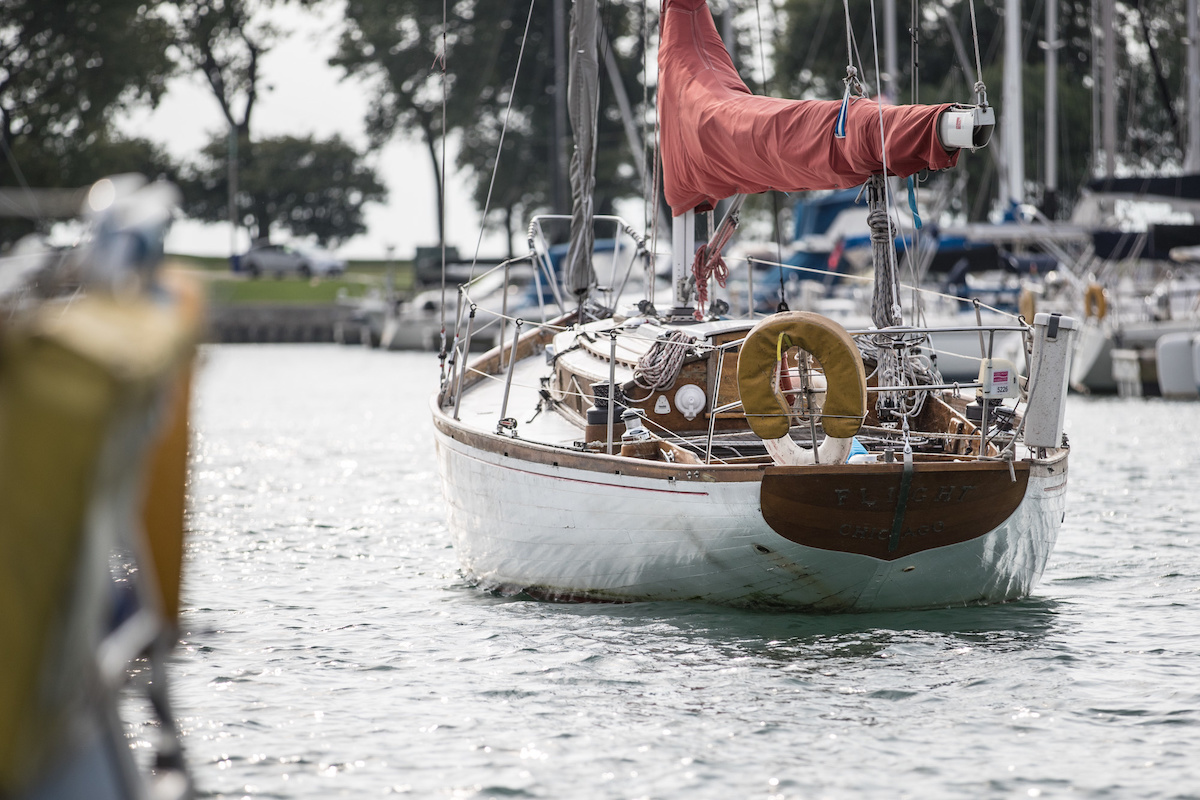
It’s easy to romanticize the idea of living on a boat full-time; however, it's an alternative lifestyle like that takes preparation, organization and an ability to roll with changes. When you commit to moving aboard, make checklists of necessities and talk to your partner about deal-breakers. Prepare the boat for life aboard well before you make the move.
Factors to Consider Before Living Aboard
Before moving onboard your boat, you should ask yourself some questions:
- Is this just for a period of time before you go cruising or is this a lifestyle choice?
- Are you comfortable with repeatedly defending your choice to your friends and family?
- Are you living in a climate that is boat-friendly year-round?
- Are you handy and a good problem solver?
- Who will accept your Amazon deliveries and are you ready to grocery shop frequently since there won’t be room to stow much?
- Are you ready to become your own maid?
- Will you feel comfortable with your kids being in this new environment?
- What’s Plan B if it doesn’t work?
After moving aboard, you may be hauling the laundry to the laundromat or groceries from the parking lot with no dock cart nearby. You’ll need to go to the pump-out station regularly as well as to the post office for your mail. Small doesn’t translate to easy so mentally run through a typical week and write down solutions to the issues.
Essentials: Stowage, Comfort & Connectivity
When you move from a 2,000-square foot house to a 40-foot boat, all the closets are smaller, the cupboards are fewer and there’s no two-car garage. In preparation, you’ll need to de-clutter kitchen gadgets, tools, mementos and clothing. Keep winter clothes in off-boat storage and your business attire at the office if possible.
Make sure the boat is warm and dry with plenty of ventilation. Mildew and condensation will become a part of life and you’ll need a whole new set of cleaners and tools.
Plan your connectivity needs. Whether a dish for TV or high-speed internet access via the marina WiFi, you’ll need a connectivity solution so you’re not cut off from work, friends, family and entertainment.
Beneficial Skills to Have for Living Onboard
Maintenance on a boat may be worse than in a house in terms of frequency and specificity. Basic plumbing, electrical and mechanical skills will be needed because boat systems are generally less reliable than their household counterparts. The alternative is calling a contractor for every issue.
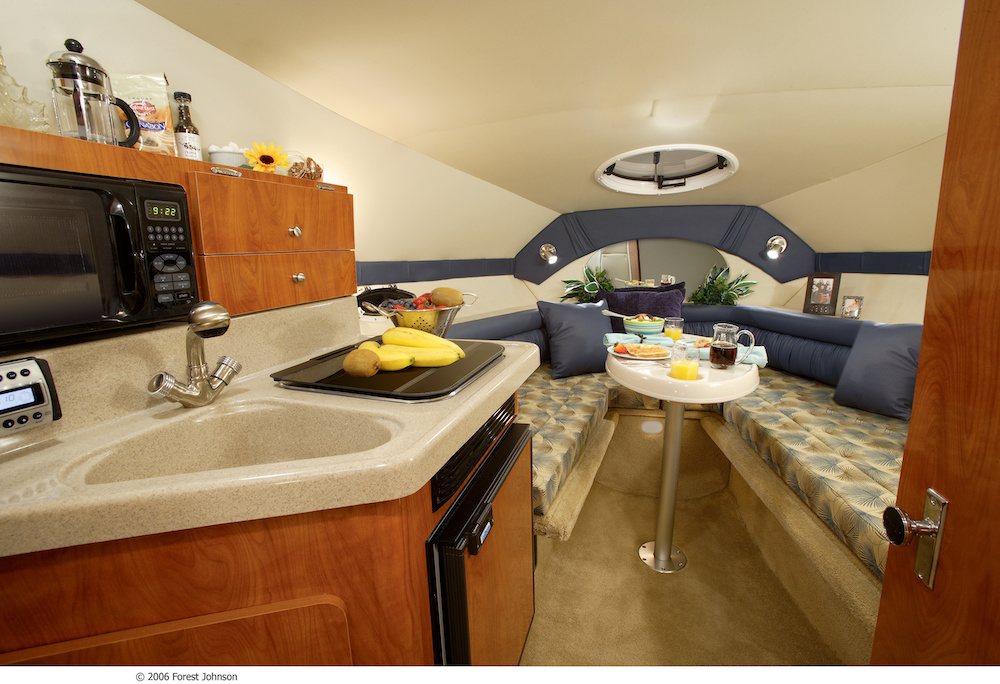
Cost of Living on a Boat
Don’t assume that you’ll save money by moving aboard. Here's some expenses you may incur by living on your boat:
- Boat mortgage payment
- Boat insurance
- Waste management
- Food and water
The best way to manage expenses is by making a budget and sticking to it. Depending on the size and value of the vessel, boat insurance may be just as expensive as house insurance. Property taxes will usually be less as will electricity since you’ll not be heating/cooling/lighting as big a space. You’ll probably save money on waste management, gas and water as well.
Where costs rise dramatically is maintenance . Marine parts and labor are usually more expensive—sometimes 20% more, than typical household counterparts. If you take on the tasks yourself and you’re self-employed, every hour you spend working on your boat is an hour you don’t make money.
Learn More in our Boat Insurance Guide
Safety & Security
You’ll need to decide whether to invite strangers inside, and if kids and pets will be safe around the docks. Install CO2 and smoke alarms and a propane sniffer, check the fire extinguishers periodically, and keep an eye on the basics like bilge and battery levels. You may also want to consider the following:
- Will you be safe walking from the parking lot to the slip at night?
- Will your nice car be okay outside the garage 24/7?
- Who will call you if your boat starts to list when you’re on vacation?
There aren’t really more or fewer safety issues, just different kinds.
Daily Life & Socialization
Socializing is easier in a marina than in a neighborhood. Neighbors help neighbors in marinas but it’s a two-way street so be ready to lend a hand when needed. If you’d rather live anonymously, consider an end tie in the forgotten corner of the marina. Although there are challenges to living on a boat, if you’re prepared, you may find it a perfect fit.
I already have a boat in a slip in a marina, so can I just move aboard?
Most marinas require an application for you to move aboard permanently. In some areas, liveaboards aren’t permitted or there are long waiting lists. Liveaboard slip fees are usually higher and your insurance rates may increase if your boat becomes your primary residence.
How do I live aboard a boat with a pet?
Dogs, cats and other pets need to acclimate to their new environments. They need exercise, private space and easy access to food and a potty. Make sure stairs and docks are safe for them and that they know how to get on the boat or dock if they fall in the water. Be careful of small spaces where they can get trapped and wires they can chew. Teach them about their new environment and be patient.
Learn more in Boating with Pets and Tips for Taking Your Dog Boating .
Read Next: Boat Owner's Guide
Looking for more information on boat ownership? Read...
- Boat Owner's Guide
- Costs of Boat Ownership
- Boat Maintenance Guide
- Insuring Your Boat
- Boat Safety Guide

Join Our Newsletter!
Get community news, buying bargains, and how-to guides at your fingertips.

Boating Basics Online is reader-supported. When you buy via our links, we may earn a commission at no cost to you. Learn more
How to Live on a Sail Boat Full Time: All You Need to Know
Written by J. Harvey / Fact checked by S. Numbers
Table of Contents
1. Choosing the Location
2. what people you live have to say, 1. the essentials, 2. cost of living, 3. safety and security, 4. socialization and daily life, 5. living life sideways, final words and ready to sail.
Don’t just romanticize when settling in a sailboat because there are some things that you have to weigh in. It’s an unconventional lifestyle that necessitates the ability to adapt to changes, make preparation, and commit to organization.
Before getting on board for good, you need to gather information on how to live on a sail boat full time. You have to think of the essentials, comfort, daily life, connectivity, safety, and security.
You also have to adjust to a new home as you learn your balance and do stuff inside a sailboat. The following part discusses important things regarding this topic.
Are You Ready For A Full-Pledged Life In A Sailboat
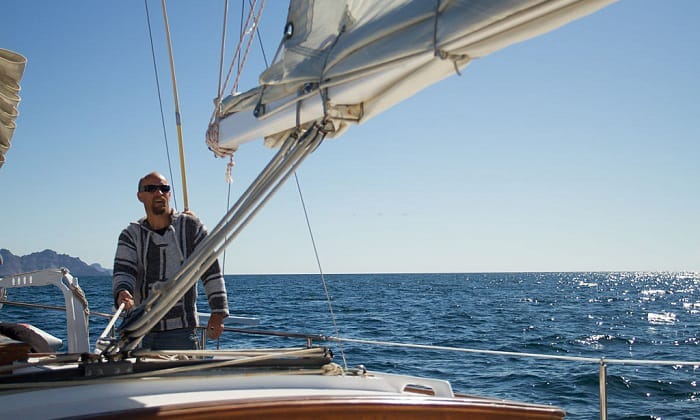
Living in a sailboat full time is not for everyone. Thus, you have to ask yourself if you’re ready for a frugal lifestyle and carrying out daily maintenance. If you’re someone who truly loves water and natural elements, there’s no doubt you’ll be joyful about it.
Sailboats are the best choice if you wish to travel and not just stay in the same location. But first, some things should be a part of your decision, and they are as follow:
Your job can interfere with your decision. But you can always find the right choice to give way to it. You’ll find areas with reasonable proximity to water. As an example, the city canal barge is popular in the UK as sailors can take advantage of boat living options. Don’t forget to check on the availability as well as the cost of the docking stations.
Your partner or family has something to say about living in a sailboat. Those people will choose to live with you, so they have to agree with it. They should also be willing to limit things that are taken on board.
It’s tricky to bring small kids and even the bigger ones in a sailboat. They may struggle to live in it.
Important Things To Deliberate When Living On A Sailboat Full Time
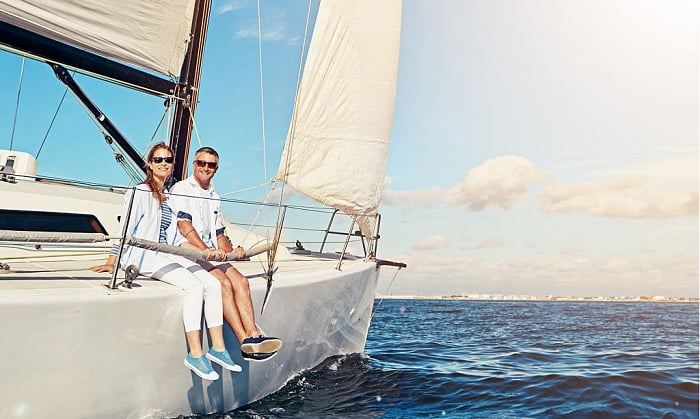
You may leave your 2,000 square foot house for a 40-foot boat. When it happens, expect that cupboards are fewer, closets are smaller, and you won’t have as much space as before. To make the most of the available space, devote some time to de-clutter.
You can begin decluttering kitchen tools, clothing, and mementos. You may keep your business attire in your office and winter clothes in off-boat storage. Also, make sure that the boat’s interior is dry and warm with plenty of ventilation to avoid condensation and mildew, which will require you of a new set of tools and cleaners.
Another thing that you have to look at is connectivity. You may need marina Wi-Fi for TV and high-speed internet. This connection will keep you posted with work, family, friends, and entertainment.
Some skills are needed to keep your boat spic and span. You must know that sailboat maintenance can be more demanding than a house when it comes to frequency and distinction.
Basic electrical, plumbing, and mechanical skills are essential because systems inside a boat are less reliable than a house. Some opt for a contractor to fix issues as they can’t manage it by themselves.
Don’t assume that you can save from living on a boat. You can estimate and make a budget with these expenses:
- Boat insurance
- Boat mortgage payment
- Food and water
- Waste management
Just like with everything, expenses can be managed well when you stick with the budget. Insurance to live aboard boats can be as expensive as home insurance. It depends on the vessel’s size and value.
You can pay less on property taxes and electricity as you don’t need to heat, light, or cool an ample space. Moreover, you can save some bucks on waste management, water, and gas.
What you would likely spend more money on is the maintenance. Labor and marine parts cost 20% higher than the household equivalent. When you work on something in your boat and you have a job at the same time, you don’t get paid for the hours that you spend on the task.
In regards to this matter, it includes the decision of whether to let dogs, kids, and strangers in your sailboat. Be wise with your judgment; will it be okay to have them around? Installation of CO2 and smoke alarms, as well as propane sniffers, is important for onboard safety and security. You can also get an alarm that can detect CO2 and smoke at the same time.
Fire extinguishers should also be on board in case of fire hazards, and you have to regularly check them. You need to keep an eye on battery levels and bilge. For the sake of safety, you must find out the answers to the following queries as well.
- Is it safe to walk from the parking area to the slip even at night?
- Is my care secured being stored in a 24/7 garage?
- Who will give you a ring when your boat is on the list while you take a vacation?
Don’t be surprised but socialization at a marina is way better than in a neighborhood. It’s because everyone helps each other so it’s like a two-way street. If you wish to be by yourself, you’ll end up unseen in the corner of the marina.
Life on a sailboat will train you on how to tilt at least 20 degrees. You’ll do it when you walk, sleep, cook, and pee. This practice is a constant act of balance. The world inside a boat seems to be sideways most of the time.
At some point, you feel like you’re in a black and white movie with a room that rotates while there are people that dance on the wall and the ceiling. You may be in discomfort and frustration for the first few days.
With the help of muscle memory, adjustments will be made by your mind and body. The time will come that walking sideways is just the normal way of walking to you. You must be able to adapt to the boat’s tight layout and unexpected movements.
To deal with the motion, calculated movements should be observed. Moving around the boat is sometimes similar to how astronauts behave when they walk on the moon. In this case, the rule of the sea can help you and it’s by having your one hand on the ship while the other is for yourself.
This rule can be applied in every task that you make onboard. For example, I can’t take two plates at a time. I needed to dedicate two rounds for it instead. You may experience being tossed in the cabin too. You may get some scrapes and bruises but they will heal later as you’ve learned how to walk sideways.
The way on how to live on a sail boat full time is akin to a rollercoaster ride. It can sometimes be scary but it’s worth it after you put things in order. Since you know the important things you have to set before going on board, you’re good to go. Your expectations are also set in what may happen when living on a sailboat.
It won’t be hard for you to manage things in your sailboat with the right knowledge that this article has imparted to you. So, bon voyage and enjoy life at the sea!
Read more other topics about sailboat:
- Steps to paint a sailboat.
- What is the average speed of a sailboat?

“My intention from the first day establishing Boating Basics Online is to provide as much help as possible for boaters who want to experience a first safe and convenient trip. So feel free to join us and share your beautiful journeys to the sea!”

Things to Consider When Living on a Boat Full-Time | Live on a sailboat | Sailboat Life | Liveaboard
Alex Morgan

1. Your Household: Who’s Living on the Boat?
Living on a boat full-time is a unique and adventurous lifestyle choice that can be incredibly rewarding. Whether you are a digital nomad or thinking of living, considering living on a boat. It’s crucial to carefully consider who will be sharing this maritime adventure with you. The dynamics of your household play a significant role in sailing lifestyle.
Singles: Solo Adventurers of the Sea
For singles, living on a boat full-time can offer unparalleled freedom and self-discovery. You have the entire boat to yourself, and decisions are yours alone to make. It’s an opportunity to embrace solitude, self-sufficiency, and the thrill of self-reliance.
Couples: Navigating Together
Couples embarking on the boat living journey must consider the challenges and joys of sharing a confined space. While romantic sunsets and cozy evenings afloat can be truly magical, there will also be moments when you’re in each other’s personal space 24/7.
Families: Raising Sailors
For families with children, boat living offers a unique opportunity for bonding and education. Kids growing up on a boat learn valuable life skills early, from navigating to problem-solving. The rewards of watching your children grow up with an appreciation for nature and self-reliance can be immeasurable.
Pets: Companions Afloat
Don’t forget about your furry or feathered friends. Many boat owners bring pets aboard. While pets can be excellent companions, it’s essential to consider their safety and comfort on the boat.
Multi-Generational Crews: The Extended Boat Family
Some adventurous souls choose to share their boat with extended family members or friends. This can be a delightful way to create lasting memories and strengthen relationships.
Tailoring Your Boat for Your Household
Each household dynamic requires different boat layouts, amenities, and storage solutions. When selecting a boat, consider the number of cabins, sleeping arrangements, and common areas. For example, families might prioritize spacious living areas, while solo adventurers may focus on compact and efficient layouts. Regardless of your household composition, communication, adaptability, and a shared love for the water will be your greatest assets in making boat living a harmonious and fulfilling experience.
2. Necessary Space for Full-Time Boat Living
When you decide to embrace the full-time boat living lifestyle, you’re not just choosing a unique way to live; you’re also embracing a more minimalist and compact way of life. On a boat, space is at a premium, and every inch must be carefully considered and utilized to ensure comfort and functionality.
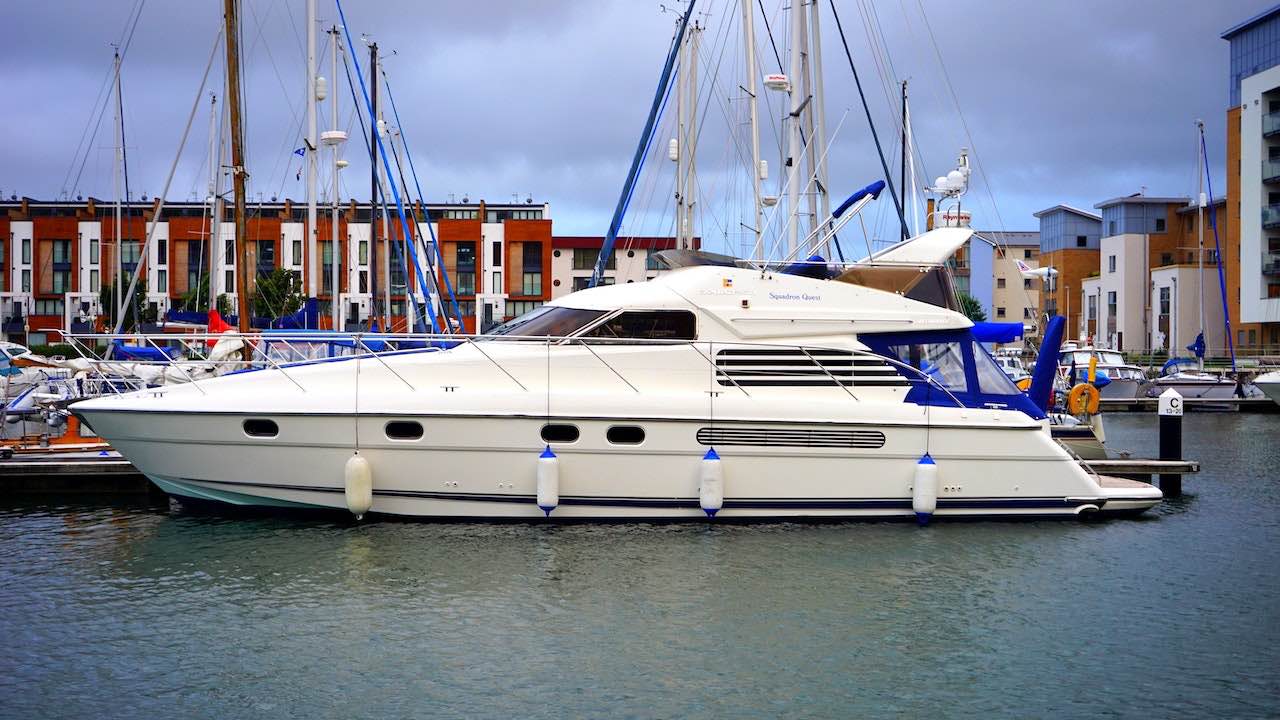
The Significance of Space Management
Effective space management is key to enjoy sailing and making boat living enjoyable and sustainable. Unlike traditional homes, where you can spread out and accumulate possessions, sailing around demands that you prioritize the essentials and make the most of your limited square footage.
Here are some important considerations for living aboard a sailboat:
- Multifunctional Furniture: Invest in furniture pieces that serve multiple purposes. For example, a dining table that can be converted into a bed or storage ottomans that double as seating. These space-saving solutions help maximize the utility of each item.
- Vertical Storage: Make use of vertical space by installing shelves, hooks, and storage compartments on walls and bulkheads. This allows you to store items like dishes, clothing, and personal belongings without cluttering valuable floor space.
- Declutter Regularly: Minimalism is a cornerstone of boat living. Regularly evaluate your possessions and remove items you no longer need or use. A clutter-free boat not only feels more spacious but also reduces the risk of accidents.
- Compact Appliances: Opt for compact, energy-efficient appliances and fixtures. Choose a smaller refrigerator, a stovetop with multiple burners, and space-saving bathroom fixtures to make the most of confined spaces.
- Outdoor Living: Boats offer the unique advantage of outdoor living spaces. Use the cockpit or deck for dining, lounging, and socializing to expand your living area without adding interior clutter.
- Stowage Solutions: Explore creative stowage solutions, such as under-bed storage, hidden compartments, and ceiling hammocks for storing items like clothing, food, and gear.
- Mindful Decorating: Choose light colors and minimalist decor to create a sense of openness and brightness. Mirrors can also give the illusion of more space.
- Reduce Redundancy: Prioritize multipurpose items and avoid redundancy. For instance, one pot that can be used for various cooking tasks is more practical than a collection of specialized cookware.
- Organizational Systems: Implement efficient organizational systems for cabinets and drawers. Use bins, dividers, and labels to keep items easily accessible and orderly.
- Personal Space: Ensure that each member of your household has a designated personal space or storage area. This helps maintain boundaries and reduce clutter.
By embracing these space management principles and adopting a minimalist mindset, you can create a comfortable and efficient living environment on your boat.
3. Other Basic Necessities for Full-Time Boat Living
Living on a boat full-time is an adventure that requires a unique approach to life’s basics. From cooking meals to maintaining hygiene, here’s a closer look at some essential aspects of daily life when your home is a floating oasis.
Cooking Aboard: Galley Essentials
The galley, or kitchen, on a boat may be smaller and less equipped compared to a conventional kitchen, but it’s where culinary creativity thrives. To make the most of your boat’s galley:
- Compact Appliances: Invest in marine-grade, compact appliances like a two-burner stove, oven, and a small refrigerator. These appliances are designed to withstand the rigors of marine life.
- Provisioning: Plan your meals carefully and stock up on non-perishable and canned goods. Limited storage space means fewer trips to the grocery store, so efficient provisioning is key.
- Seasickness-Friendly Recipes: Opt for easy-to-make meals that won’t cause seasickness, as boat movement can affect cooking. Simple recipes with minimal prep work are ideal.
- Outdoor Cooking: Utilize the grill or cook meals on the deck when weather permits. Grilling seafood you’ve caught yourself is a delightful part of boat living.
Hygiene and Sanitation: Compact Bathrooms
Boat bathrooms, known as heads, are typically smaller and require thoughtful usage:
- Marine Toilets: Marine heads are different from household toilets, so familiarize yourself with their operation and maintenance.
- Water Conservation: Freshwater is a precious resource on a boat. Be mindful of water usage, especially when showering. Many boaters opt for quick, efficient navy showers.
- Waste Management: Learn how to properly handle waste, including blackwater and greywater. Compliance with marine sanitation laws is essential.
- Laundry: Access to laundry facilities may be limited. Consider compact, portable washing machines, and get familiar with laundromats at marinas.
Adapting to Compact Living: Mindset Matters
Living on a boat full-time requires an adaptable mindset:
- Downsizing: Embrace minimalism and pare down your belongings to the essentials. Simplifying your life is liberating and makes boat living more comfortable.
- Routine Maintenance: Regularly maintain your boat to ensure it stays in good condition. Learn basic boat maintenance skills or hire a qualified marine technician. You should be equipped with lots of tools which would come in handy if you choose to move on sailboat
- Weather Awareness: Be weather-savvy. Weather conditions can impact your plans and safety. Stay informed and be prepared for changing conditions. Life at sea can be a bit of a challenge specially in long-term sailing means being aware of wind and waves at all times.
- Community and Support: Connect with other liveaboard boaters and join boating associations. Saying goodbye to friends is tough, the boating community is often welcoming and provides valuable support and advice.
- Adaptability: Flexibility is key in boat living. Living in a very small space, one has to be prepared to adjust plans and adapt to unforeseen circumstances.
3. Your Budget: Navigating the Financial Waters of Boat sailing
Embarking on a full-time boat living adventure is not just a lifestyle change; it’s a financial commitment that requires careful planning and consideration. Here, we’ll dive into the financial aspects of boat living, helping you chart a course for a budget that keeps your dreams afloat.

Understanding the Costs of Boat Living
Before setting sail, it’s essential to have a clear understanding of the costs associated with living on a boat full-time. These costs can be broken down into several categories:
- Boat Purchase: The initial cost of acquiring a boat can vary greatly depending on the type, size, age, and condition of the vessel. Whether you buy new or used, this is often the most significant upfront expense. You should buy a boat which is capable of long-term sailing and matches your cruising lifestyle.
- Maintenance and Repairs: Boats require ongoing maintenance and occasional repairs. Budget for routine maintenance, haul-outs, engine servicing, and unexpected repairs.
- Marina Fees: If you plan to dock your boat in a marina, you’ll need to budget for slip fees. Marina fees vary widely depending on location, amenities, and boat size.
- Insurance: Boat insurance is essential to protect your investment. Factors like the type of boat, coverage, and your boating experience can influence insurance costs.
- Fuel and Utilities: Factor in the cost of fuel for propulsion and onboard generators. You’ll also have utility costs, including electricity, water, and sewage pump-out fees.
- Provisions: Budget for groceries, cleaning supplies, and other essentials. Living on a boat often means less storage space, so provisioning efficiently is crucial.
- Safety Equipment: Invest in safety gear like life jackets, fire extinguishers, and emergency signaling devices. These are non-negotiable expenses for responsible boat owners.
- Personal Expenses: Don’t forget about personal expenses like health insurance, entertainment, and leisure activities. Boat living should be enjoyable, so allocate funds for fun too.
Budgeting Strategies for Boat Living
Creating a budget for full-time boat living requires a different approach than budgeting for a land-based lifestyle. Here are some strategies to help you navigate your financial waters and keep the boat in good condition.
- Detailed Expense Tracking: Keep a detailed record of all your expenses for the first few months to understand your spending patterns and identify areas where you can save.
- Emergency Fund: Build an emergency fund for unexpected boat repairs or other unforeseen expenses. Having a financial safety net is crucial.
- Frugal Living: Embrace frugality and minimalism. Reduce unnecessary expenses and focus on what truly matters to you.
- Maintenance Fund: Set aside a portion of your budget for routine boat maintenance. Regular upkeep can prevent costly repairs in the long run.
- Alternative Docking Options: Explore cost-effective docking options, such as mooring balls or anchorages, which may be more affordable than marina slips.
- Liveaboards’ Communities: Join liveaboard communities and forums to gain insights from experienced boat dwellers. They can provide tips on budgeting and cost-saving strategies.
- Periodic Assessments: Review and adjust your budget regularly as your circumstances change or as you gain more experience with boat living.
4. Do You Need Permission? Navigating Legal and Regulatory Aspects of start living sailboat life
As you prepare to embark on the full-time boat living journey, it’s vital to understand that living on the water comes with a set of legal and regulatory considerations that can vary by location. Navigating these waters is essential to ensure a smooth and lawful experience.

Understanding Marine Regulations
Marine regulations are in place to promote safety, protect the environment, and maintain order on the waterways. Here are some key aspects to consider:
- Boating Licenses: In many regions, you may need a boating license or certificate of competency to operate a vessel. These requirements can depend on the type and size of the boat.
- Navigation Rules: Familiarize yourself with the International Rules of the Road and any local navigation rules specific to your area. These rules govern the safe operation of vessels and prevent collisions.
- Environmental Regulations: Proper disposal of waste, sewage, and graywater is essential to protect the environment. Comply with local regulations for sewage pump-out and waste management.
- Anchoring Regulations: Some areas have restrictions on anchoring, including designated anchorages, time limits, and distances from shore. Be aware of these regulations when selecting anchorages.
- Permits and Licenses: Depending on your location, you may need permits or licenses for various activities, such as fishing or collecting seafood.
- Boat Safety Equipment: Ensure your boat is equipped with the necessary safety equipment, including life jackets, fire extinguishers, and emergency signaling devices, to comply with safety regulations.
Permissions for Living Aboard
Living aboard a boat full-time may require additional permissions, which can vary by location and type of waterway. Here are some considerations:
- Marina Rules: If you plan to dock in a marina, understand the marina’s rules and regulations for liveaboards. They may have specific requirements and fees.
- Anchoring Permits: In some areas, you may need anchoring permits to stay in anchorages or mooring fields. Research local anchoring regulations and obtain the necessary permits.
- Zoning and Liveaboard Regulations: Investigate whether there are zoning laws or liveaboard regulations in your chosen area. Some jurisdictions have restrictions on full-time boat living.
- Mooring Fields: If you’re considering a mooring field, find out if there are waiting lists, fees, or specific regulations governing mooring usage.
Research and Compliance
Before casting off, take the time to research the specific regulations and requirements in your intended cruising area. Here’s how to navigate these waters effectively:
- Local Authorities: Contact local maritime authorities or harbormasters to obtain information on local regulations and permits.
- Online Resources: Use online resources and boating forums to gather information from other boaters who have experience in your chosen area.
- Boating Associations: Join boating associations or clubs, as they often provide guidance and resources on compliance with regulations.
- Stay Informed: Regulations can change, so stay informed and be prepared to adjust your plans accordingly.
Remember that compliance with regulations not only ensures your legal standing but also contributes to the safety and sustainability of the marine environment. It’s an essential part of responsible boat living that allows you to enjoy the journey while respecting the waters you call home.
5. Best Boats to Live on a sailboat: Finding Your Cozy Floating Home
Choosing the right boat for full-time living is a pivotal decision on your journey to becoming a liveaboard. The type of boat you select can significantly impact your comfort, lifestyle, and overall experience. Here, we explore various boat options that make excellent floating homes for full-time living.
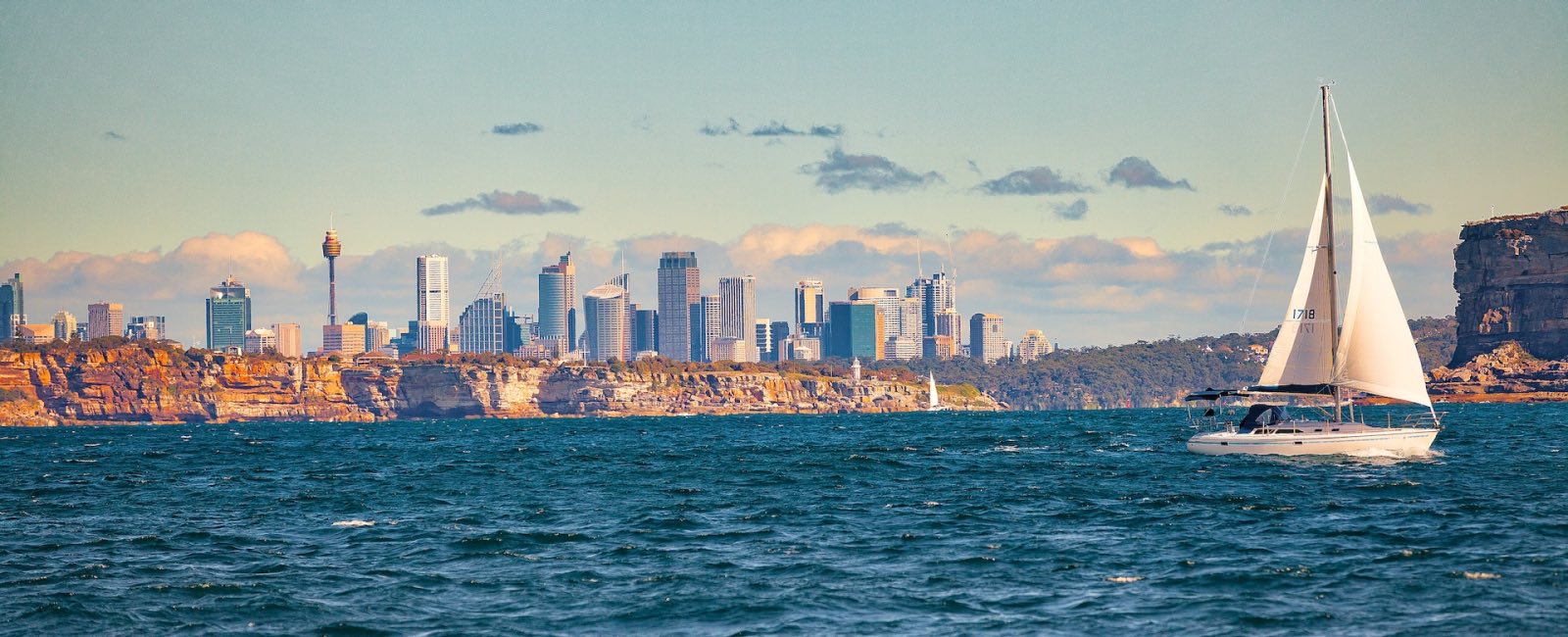
Tugboats and Trawlers: The Comfortable Cruisers
Tugboats and trawlers are well-known for their stability, spacious interiors, and long-range capabilities. These boats are often favored by liveaboards for several reasons:
- Ample Space: Tugboats and trawlers have generous living areas, making them comfortable for couples or families.
- Efficiency: They are known for fuel efficiency, which can be a major cost-saving advantage.
- Stability: Their full displacement hulls provide a smooth and stable ride, even in rough seas.
- Storage: Tugboats and trawlers often come with substantial storage space for provisions and personal belongings.
- Comfort: Many feature all the amenities of a home, including a fully-equipped galley, spacious cabins, and even a washer and dryer.
Houseboats: The Waterfront Homes
Houseboats offer a unique blend of a floating home and a cruising vessel. They’re essentially floating houses, with the following advantages:
- Spacious Living: Houseboats are known for their generous living spaces, making them ideal for families or those who crave room to spread out.
- Stability: When properly moored, houseboats provide a stable, house-like environment.
- Scenic Views: Wake up to stunning waterfront views right outside your window.
- Customization: Many houseboats can be customized to fit your preferences and needs.
- Community: Houseboat communities often have a strong sense of camaraderie, providing a unique social aspect to boat living.
Yachts: Luxury Afloat
For those seeking the utmost in luxury and comfort, yachts offer a premium full-time living experience:
- Elegance: Yachts come in various sizes, but even smaller ones often feature high-end finishes and amenities.
- State-of-the-Art Technology: Modern yachts often include advanced navigation systems, entertainment centers, and climate control.
- Crew Options: Larger yachts may have space for a crew, offering a luxurious, worry-free lifestyle.
- Sailboats: Embracing the Wind: Sailboats are a favorite among adventurers who appreciate the romanticism of wind-powered travel
- Environmental Friendliness: Sailing is an eco-friendly option, as it relies on wind rather than fuel.
- Simplicity: Sailing encourages a simpler, more mindful lifestyle, with fewer mechanical systems to maintain.
- Affordability: Smaller sailboats can be more affordable both in terms of purchase and maintenance costs.
- Connection to Nature: Living on a sailboat provides an unparalleled connection to nature, as you harness the wind’s power to move.
Floating Homes: The Unique Abodes
Floating homes are fixed, house-like structures located in marinas or on the water’s edge. They offer a unique blend of land-based living with a waterfront lifestyle:
- Stability: Floating homes are permanently moored, providing a stable living environment.
- Land-Like Amenities: They often come with all the amenities of a traditional home, including utilities and sewage connections.
- Community: Floating home communities can be tight-knit and social, akin to neighborhood living.
Choosing Your Cozy Floating Home
Ultimately, the best boat for full-time living depends on your personal preferences, budget, and lifestyle. Consider factors like size, layout, maintenance requirements, and whether you want to cruise or stay put in one location. Take your time to research, visit boat shows, and consult with experienced liveaboards to find the perfect vessel that will make your boat living dream a reality.
6. Living Aboard: Safety Considerations for liveaboard sailor
Living on a boat full-time offers a unique and adventurous lifestyle, but it also comes with specific safety considerations that are essential to ensuring a secure and enjoyable experience on the sailing boat. Here, we explore key safety aspects that every liveaboard should prioritize.
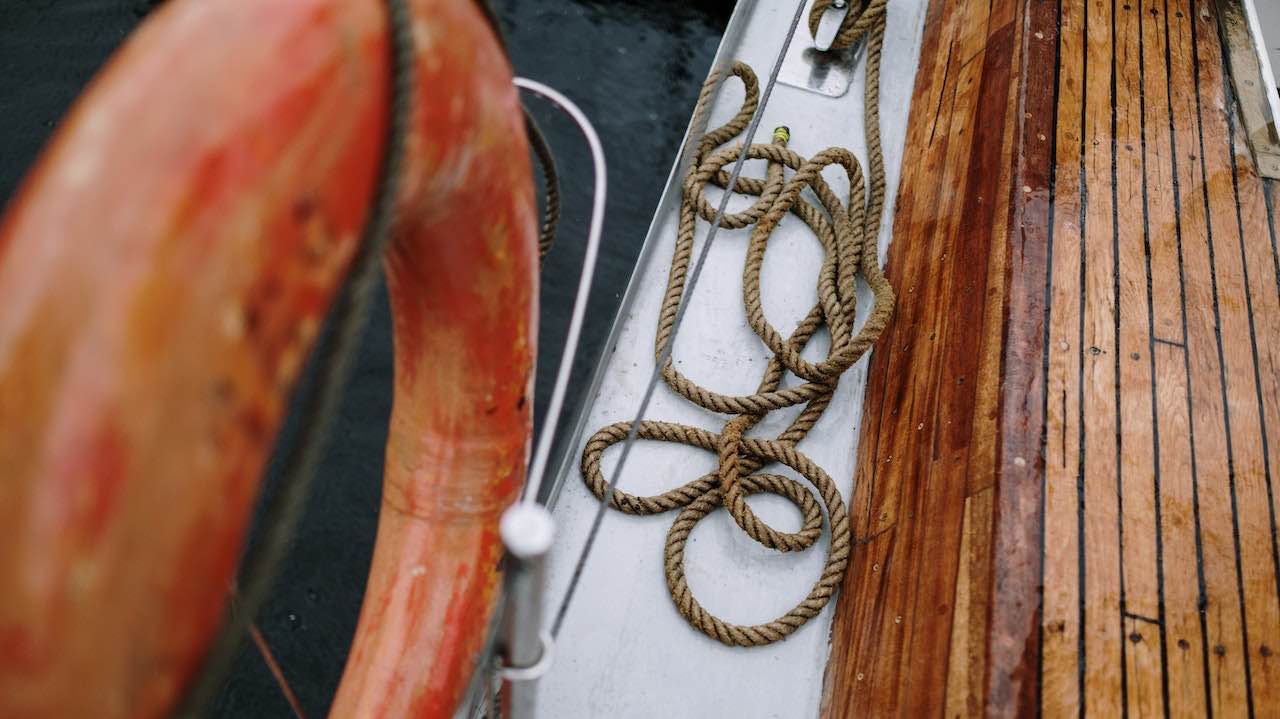
Life Jackets and Personal Flotation Devices (PFDs): Life jackets are your first line of defense in case of an emergency. Ensure that you have enough PFDs on board for every member of your household and that they are easily accessible.
Fire Safety: Fires on boats can be catastrophic due to the limited space and the proximity of flammable materials. Install smoke detectors and fire extinguishers in critical areas of your boat. Conduct regular fire drills to ensure everyone knows what to do in case of a fire.
Emergency Signaling Devices: Have emergency signaling devices such as flares, a whistle, and a VHF marine radio on hand. These tools can be crucial for summoning help in emergencies.
First Aid Kit: A well-stocked first aid kit is essential. Ensure it includes supplies for treating common injuries and ailments that can occur on a boat.
Man Overboard (MOB) Procedures: Develop and practice MOB procedures regularly. Invest in MOB recovery devices like life rings with lights and throwable flotation devices.
Weather Awareness: Stay informed about bad weather conditions in your area. Sudden storms and changing weather patterns can be challenging for boat dwellers. Access weather reports and carry a weather radio or app to receive updates while on the water.
Safe Navigation: Navigation is a critical aspect of safety. Understand the rules of navigation, maintain accurate charts, and know how to use navigation equipment like GPS, depth sounders, and radar.
Anchoring Safety: Proper anchoring is crucial for a secure night’s rest. Ensure your anchor is appropriate for your boat’s size, and regularly inspect the anchor and rode for wear.
Dinghy Safety: If you use a dinghy for transportation to and from shore, make sure it’s in good condition and equipped with safety gear. Wear PFDs when using the dinghy.
Electrical Safety: Electrical issues can pose a significant safety risk. Regularly inspect your boat’s electrical systems for frayed wires, loose connections, or other hazards.
Marina and Dock Safety: Pay attention to safety guidelines at marinas and docks. Follow rules for securing your boat, handling lines, and using power and water connections.
Emergency Plans: Life on a boat can be challenging sometimes, develop emergency plans and communicate them to everyone on board. Include procedures for medical emergencies, fire, man overboard situations, and abandon-ship scenarios.
Stay Sober: Alcohol impairs judgment and reaction time, which can be dangerous on a boat. Consume alcohol responsibly and designate a sober skipper when needed.
Continuous Learning: Keep improving your boating knowledge and safety skills. Consider taking boating safety courses and staying updated on the latest safety practices.
Insurance and Documentation: Ensure your boat is adequately insured, and keep important documentation such as registration, insurance policies, and contact information readily accessible.
Stay Calm Under Pressure: In high-stress situations, it’s essential to remain calm and collected. Practice mindfulness and stress-reduction techniques to stay level-headed in emergencies.
Community Support: Connect with the boating community and develop a support network. Fellow liveaboards can provide assistance and guidance in challenging situations.
Boat Maintenance: As a boat owner, it’s a must to clean and properly maintain your boat. Please refer to this article to learn more about boat maintenance.
Safety is paramount when living on a boat full-time. Prioritize preparation, learning to sail, and vigilance to fulfil your dream of sailing and enjoying the freedom and adventure that boat living offers while ensuring the well-being of yourself and your loved ones. For more articles, visit sailawayblog.com
About the author
Leave a Reply Cancel reply
Your email address will not be published. Required fields are marked *
Save my name, email, and website in this browser for the next time I comment.
Latest posts

The history of sailing – from ancient times to modern adventures
History of Sailing Sailing is a time-honored tradition that has evolved over millennia, from its humble beginnings as a means of transportation to a beloved modern-day recreational activity. The history of sailing is a fascinating journey that spans cultures and centuries, rich in innovation and adventure. In this article, we’ll explore the remarkable evolution of…

Sailing Solo: Adventures and Challenges of Single-Handed Sailing
Solo Sailing Sailing has always been a pursuit of freedom, adventure, and self-discovery. While sailing with a crew is a fantastic experience, there’s a unique allure to sailing solo – just you, the wind, and the open sea. Single-handed sailing, as it’s often called, is a journey of self-reliance, resilience, and the ultimate test of…

Sustainable Sailing: Eco-Friendly Practices on the boat
Eco Friendly Sailing Sailing is an exhilarating and timeless way to explore the beauty of the open water, but it’s important to remember that our oceans and environment need our protection. Sustainable sailing, which involves eco-friendly practices and mindful decision-making, allows sailors to enjoy their adventures while minimizing their impact on the environment. In this…
- Paddle Board

Liveaboard Marinas Guide: Here’s Everything You Need to Know
Do you feel like giving up apartment life in the studio for a life on the water? Living on a boat provides you alternative accommodations to that studio that’s bleeding your cash flow dry every month. Living on a boat is affordable, and it’s a change to the fast-paced city lifestyle.
If you’re thinking about the boating life, then you’ll probably be staying in a marina. Anchoring at sea or using mooring buoys is only a temporary living solution, and it’s only for those real sea dogs that are self-sustainable on the ocean.
You can think of a marina like an apartment complex. You pay a levy for amenities and services within the marina, like laundry rooms, parking, and security. Like apartment blocks, some marinas are better than others. Some offer an upmarket living experience, while others can be dilapidated and a security threat.
Please take a look at our guide to finding liveaboard marinas to tie up and stay a while.
Liveaboard Marina Amenities
As mentioned, the primary difference in marinas is the location. The marina’s quality in terms of its security amenities and services (and the people and boats) plays a role in pricing. In the best marinas, you’ll find everything you need to enjoy a comfortable lifestyle on a boat.
Some of the important features to look for in a prospective marina include the following.
- Power facilities.
- Holding tank pumps.
- Pump out services.
- Restrooms and showers.
- Clubhouses and pools.
- Restaurants and bars.
- Laundry and fitness facilities.
- Parking areas.
- Business centers.
- Grocery stores and ship stores.
- Gas and diesel tanks or filling areas.

What You Need to Consider Before Tying Up in a Liveaboard Marina
Whether you’re a student looking for affordable accommodation or a retiree thinking about downsizing your living arrangement, the boating lifestyle is a different approach to living . However, living in a marina isn’t for everyone.
If you can’t get used to smaller living spaces and lack of storage space, it’s not going to work out for you. The marina lifestyle suits minimalists that don’t carry around many possessions in their life. You’ll also have other challenges to deal with when living on the water, such as boat maintenance and the weather .
Here are some other factors you need to consider before moving to a marina.
Does the Marina Permit Liveaboard?
Some marinas may allow people to stay overnight or for a few days, but they may prohibit living in the marina full-time.
Can I Live in a Confined Space?
The boating lifestyle is a significant downgrade to your living space, and it can feel confining for some people. Make sure you’re comfortable with a snug home, and if you have a partner, make sure you are both comfortable with closer living quarters.
Does the Marina Allow Pets?
If you have pets, you’ll have to consider marinas pet policies before signing a lease. Some marinas allow pets, while others may forbid it. Most marinas won’t allow pets, especially upmarket marinas, due to problems with pet mess unattended by owners.
Proximity to Cities and Towns
How close is the marina to the local town and the grocery store? Where is the nearest gas station? These are considerations you need to account for before moving into the marina.
How Do I Get to Work?
Are you driving a car, using Uber, or public transport to get around? If you’re using a car to get to work or move around town, you’ll need to ensure the marina offers secure parking facilities.
Are there Bridges Close By?
It might seem strange to wonder why this would matter to you. However, if you own a sailboat, you’ll need to know that there are bridges that can raise the bridge to accommodate the mast length o0n your boat.
Does the Marina Have Deep Water Access?
If you plan to take your boat out into the ocean or a lake, you want to ask the marina if it has deep water access, especially if you have a larger, heavier vessel. The deep water access prevents larger boats from damaging the keel or propellors.
Climate and Weather
What is the climate like in the marina and the local area? If you choose to live in Florida, you get great weather, but there’s always the chance of a hurricane causing an evacuation – the same goes for gulf coast cities like New Orleans. Extreme weather risk is a consideration in today’s changing climate.
Along with extreme weather, you also have to be comfortable living in a humid environment. Life on the water means that those hot days can become overbearing, and you’ll be dripping with sweat onboard your boat. When the winter rolls around, living on a boat is much colder than living on land.
Hurricane Season and Boat Insurance
As mentioned, extreme weather is a real problem for the boating lifestyle. Hurricanes affect the Gulf Coast and the Eastern seaboard of the United States. Hurricanes are a risk from Houston all the way around to Miami, up to the Carolinas, and even as far as New York.
If you’re going to live anywhere on the gulf or the eastern seaboard, it’s essential that you take out hurricane insurance on your boat . If you’re renting the boat, make sure the owner has insurance to cover your possessions if you have to leave the boat in an emergency and can’t take anything with you.
It’s also important to note that hurricane policies are different from standard insurance policies, so make sure you understand the policy terms before signing your agreement with the insurer.
What are the Pros of Liveaboard Marinas?
There are plenty of reasons why moving to a marina is a great idea. From catamarans to trawlers and houseboats, there are always interesting boats in the marina and plenty of opportunities to meet new people.
Some of our top aspects of marina life include the following.
- A laid-back lifestyle.
- Friendly and relaxed people.
- Peaceful ocean or water sounds.
- More wildlife in the area.
- New travel experiences.
- Affordable living.
What are the Cons of Liveaboard Marinas?
Some of the drawbacks to marina living include the following.
- Extreme weather scenarios.
- Humidity in the summer.
- Cold in the winter.
- No onboard facilities in your boat.
- Not all marinas offer all amenities.
- Prices can vary depending on the marina.
- Close proximity to your neighbors.

Costs of Docking at a Liveaboard Marina
If marina life sounds like it’s for you, we bet you want to know how much it’s going to cost you. Several factors contribute to what you’ll pay at the marina.
- The services and amenities at the marina.
- The security of the marina.
- The prestige and reputation of the marina.
- Other secondary factors include the following.
- Does the marina charge you for the length of your boat or the slip size?
- Does the marina charge a flat rate?
- Does the marina offer discounts for long-term leases?
- Is there a fee for liveaboard?
- Do you get electricity and water included?
- Are there any other hidden costs?
- Do they offer pump-out services and maintenance or repairs?
- Do they have Wi-Fi, and is it free and stable?
Typically, you’ll find that most marinas base their fees on the length of the boat. Since most people live in boats under 40-feet, you should find that it’s an affordable lifestyle for the value you get in return.
The cost of the marina fee can vary depending on all the factors and the amenities on offer. If you’re living at a premium, top-rated marina in a city like Miami, you could expect to pay up to $1,000 per month. However, smaller marinas in smaller towns may charge you as little as $150 per month, but they may lack some amenities.
It’s about what you can afford to pay and what you want for your lifestyle. However, one thing is for sure – it’s a lot cheaper than living in an apartment or a studio. Sure, a few other costs are involved, but most of them are similar to what you’ll be paying in an apartment anyway.
Choosing Marinas in Large Cities
It’s important to note that liveaboard rates will always be more expensive in cities than in smaller towns. It might be worth your while to look for marinas just outside major cities if you have a car and can drive into work.
If you work remotely, choose a marina away from the city’s fast-paced life and enjoy a peaceful and serene living environment out on the water. However, if you are working from home, make sure you have a good Wi-Fi connection at the marina.
Where Do I Find Liveaboard Marinas?
You can find liveaboard marinas along the east and west coast, the Gulf Coast, and inland waterways across the United States.
However, many of the marinas don’t provide liveaboard for boaters, and you’ll need to do a bit of research to find the ones that permit it and then separate the good from the bad locations.
When assessing a marina for your living accommodations, make sure you look at what people say about it on social media and forums. Make sure you’re moving into a place with good reviews, or you could end up in a nightmarish living environment.
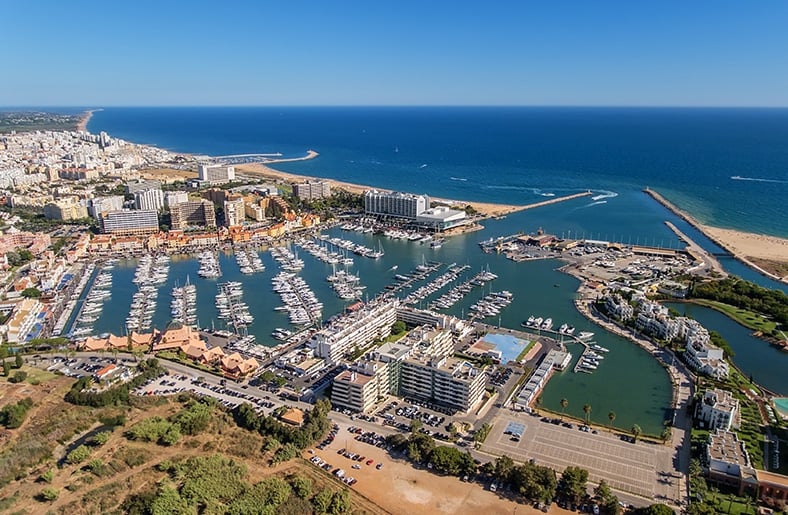
What Do I Do If I’m On a Waiting List for a Marina?
The problem with finding a marina is that the good ones are in short supply, especially those offering liveaboard facilities around cities. If you find that the marina is full, you can always apply to get onto the waiting list and move somewhere else while you’re waiting for a slip to become available.
Most marinas around cities cap the number of liveaboards available, and it’s not uncommon to find multi-year waiting lists for liveaboards at some sought-after marinas. If you have no luck getting a liveaboard in any marina, here are a few strategies to help you work around the situation.
The first option if you’re on a waiting list is to sublet for someone else. Some people with yachts cruise the world for years at a time, enquire with the marina manager about any subletting opportunities.
You can also go the old-school route of posting a request or a poster asking for subletting opportunities on the marinas message board. In some cases, you might not even need a boat to sublet, and you get fully furnished living accommodation.
It’s worth it to enquire around town if you have your heart set on the marina and there’s a long waiting list.
Buy Boats that Include a Liveaboard Slip
Some dealers or owners might sell you a boat with a slip included with your purchase. You can negotiate the slip into the purchase of the boat with the owner and get a great deal on your new living arrangement.
However, make sure you pay attention to the pricing; some boat owners may inflate the price of the boat by as much as $50,000 because a liveaboard slip is so sought-after in the market.
Sneak-Aboards
If you’re absolutely desperate and have nowhere else to turn, you can always consider the sneak-aboard option. This one isn’t for the faint-hearted, and it’s a risky, temporary strategy that could get you in trouble.
Some marinas will let you live aboard and turn a blind eye or accept a bribe to you living aboard your boat at the marina. However, this option often involves a lot of sneaking around, and if people see you living there and complain, the management may kick you out of the marina.
Wrapping Up
The economy has seen prices increase across the board for a variety of consumer staples, including rent. Renting a small apartment in cities like San Francisco and New York cost a fortune. As a result, many people are resorting to living in vans in parking lots.
Liveaboards at marinas offer you a different lifestyle to the van life, and it’s much more comfortable, snug, and relaxing.

John is an experienced journalist and veteran boater. He heads up the content team at BoatingBeast and aims to share his many years experience of the marine world with our readers.
What to Do If Your Boat Engine Won’t Start? Common Problems & How to Fix Them
How to launch a boat by yourself: complete beginner’s guide, how to surf: complete beginner’s guide to get you started.
Comments are closed.
Type above and press Enter to search. Press Esc to cancel.
We’re on the road right now – join in on the fun and follow @thebrokebackpacker on IG!
- Meet the Team
- Work with Us
- Czech Republic
- Netherlands
- Switzerland
- Scandinavia
- Philippines
- South Korea
- New Zealand
- South Africa
- Budget Travel
- Work & Travel
- The Broke Backpacker Manifesto
- Travel Resources
- How to Travel on $10/day
Home » Budget Travel » Boat Life 101: How to Live on a Boat and Travel the World! (2024)
Boat Life 101: How to Live on a Boat and Travel the World! (2024)
Waves lap at the hull of the boat. Your feet are in the glassy water, a glass of rum in your hand, and a glorious sunset in front of you. Of course, the weather is perrrfect .
Just another day in the life of living on a boat.
Surely that’s not all what living on a boat is like though, right? What about the sea monsters ? What about getting shipwrecked and floating for days on end at sea awaiting rescue?
And as if a broke bum can really live on a sailboat. Come on!
Rest assured, greenhorn – I’ve got you.
I went from a baby sailor who almost blew up the boat, to hand steering my way across the Pacific Ocean using the Southern Cross as my bearing. And I did it all with very little cash to my name.
Now I’m here to pass on to you what it’s really like to live on a boat AND how to do it . It’s the how-to-poop, how-to-cook, how-to-sail – and the best places in the world to do it all in. PLUS how exactly you can put a budget on a dream.
Avast! I give you, how to live on a boat and travel the world.

Living on a Boat: What’s it Really Like?
How to live on a boat full time, best places in the world to live on a boat (and when to go) , the cost of living on a sailboat (and how to minimise it) , can you live on a sailboat for free, last tips for living the boat life.
“Indigo, where’s the F**CKING coffee?”
Yeah, you want to buy a boat. And then you’re going to sail off into the sunset – travelling the world without spending a dime – with twelve babes on one arm and the world’s greatest rum in the other. Oh, it’s going to be so lovely, isn’t it?
Welllllll , I’m not here to burst your bubble, but I am here to give you a wee reality check.
Living on a boat is not for suckers; it’s not for the impatient; it’s not for the stupid. I realise that many people who suck and are stupid, can and do sail. They give the rest of us a headache – don’t be them.
If you forget the coffee, the rest of the boat may very well feed you to the sharks. The only shop for the next 200 nautical miles is now a distant speck on the goddamn horizon, after all.
However, provided there is ample coffee, rum, and good conversation, there is nothing better than living on a boat. No, that is not a cliche.
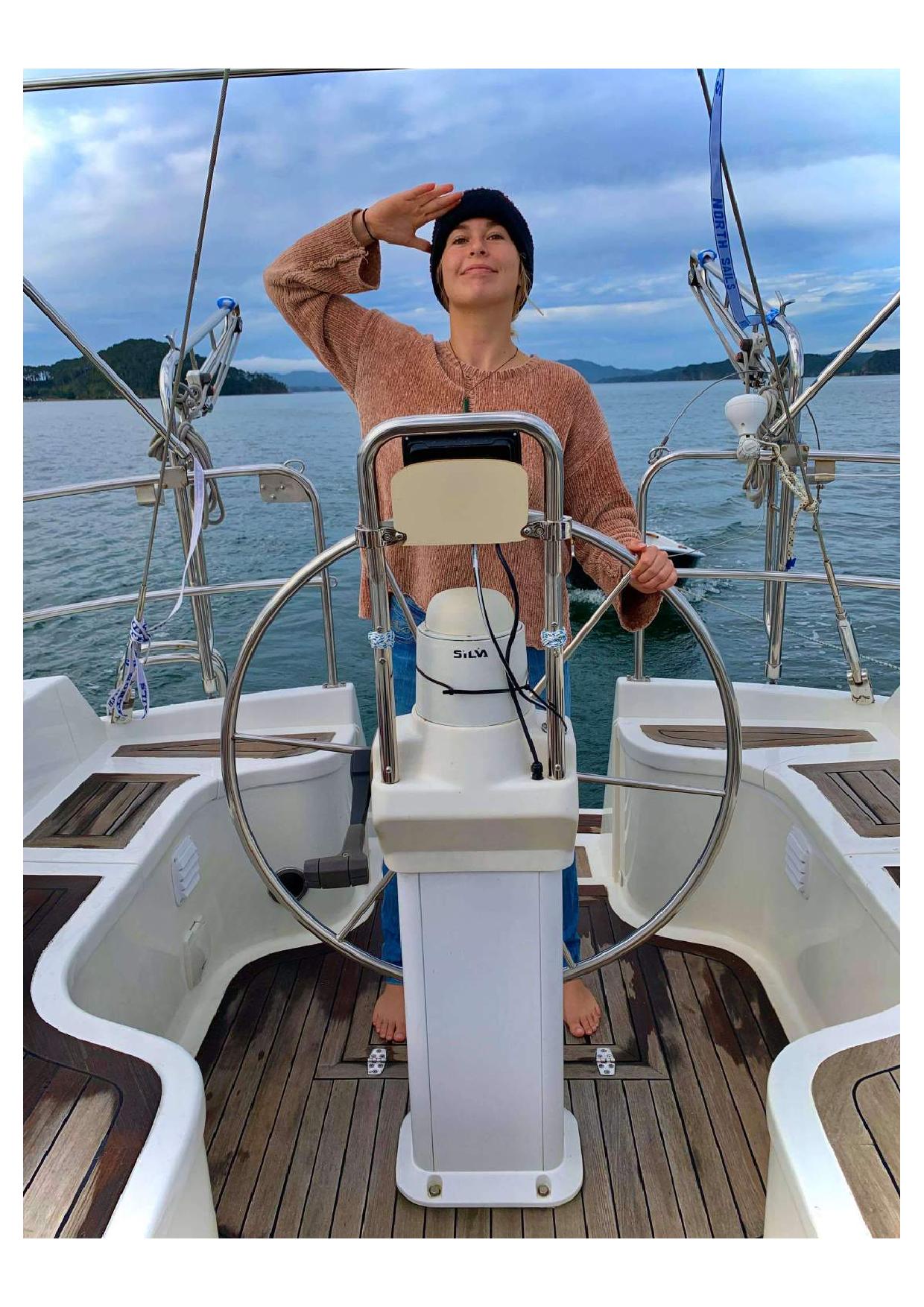
Life on a sailboat is life at its most .
- The duality of boredom and near-death experiences.
- Harnessing the wind and moving soundlessly across the great blue spectacular.
- Fresh sashimi.
- Deep introspection.
- The oscillating moods of the crew that spread like the flu.
- Long stretches of time with no goddamn Instagram.
A boat becomes a very miniature village, and in this, you can touch on a very primal way of living; one that has been passed down to us from many millions of years of evolution.
The simplicity is not always poetic. But it will make you appreciate every damn cup of coffee – and isn’t that what life is all about?

Do You Want to Travel FOREVER??
Pop your email in below to get a FREE copy of ‘How to Travel the World on $10 a Day!’.
So here it is folks! The basic and hyperbole-filled how-to of living on a boat.
It’s just three simple things. (Sort of.) And then, the ocean is your oyster.
Hoist those sails and may the wind be ever in your favour.
Boat Life 101: Pooping

Don’t laugh! Pooping on a boat is your first lesson in how different living on a sailboat is to land life.
You have to think about the consequences of your every action: sustainable travel MATTERS . If it’s a small sailboat, it will likely have a manual pump instead of a flush. You do your business, and then pump, pump, pump.
And that’s not where it ends. You need to think about where exactly your poop is going.
It becomes very clear that all drains lead to the ocean.
Usually, your poops will be going into the boat’s holding tank, but they only hold so much. You need to know the regulations in the national waters of wherever the boat is because you can’t empty the holding tank until you’re far enough away from shore, certain mooring fields, and protected areas… for obvious reasons.
Now, I would argue you haven’t lived until you’ve dealt with a malfunctioning head (marine toilet). Nothing makes you appreciate modern sewerage systems like the sweet smell of shit.
Boat Life 101: Cooking + Provisioning
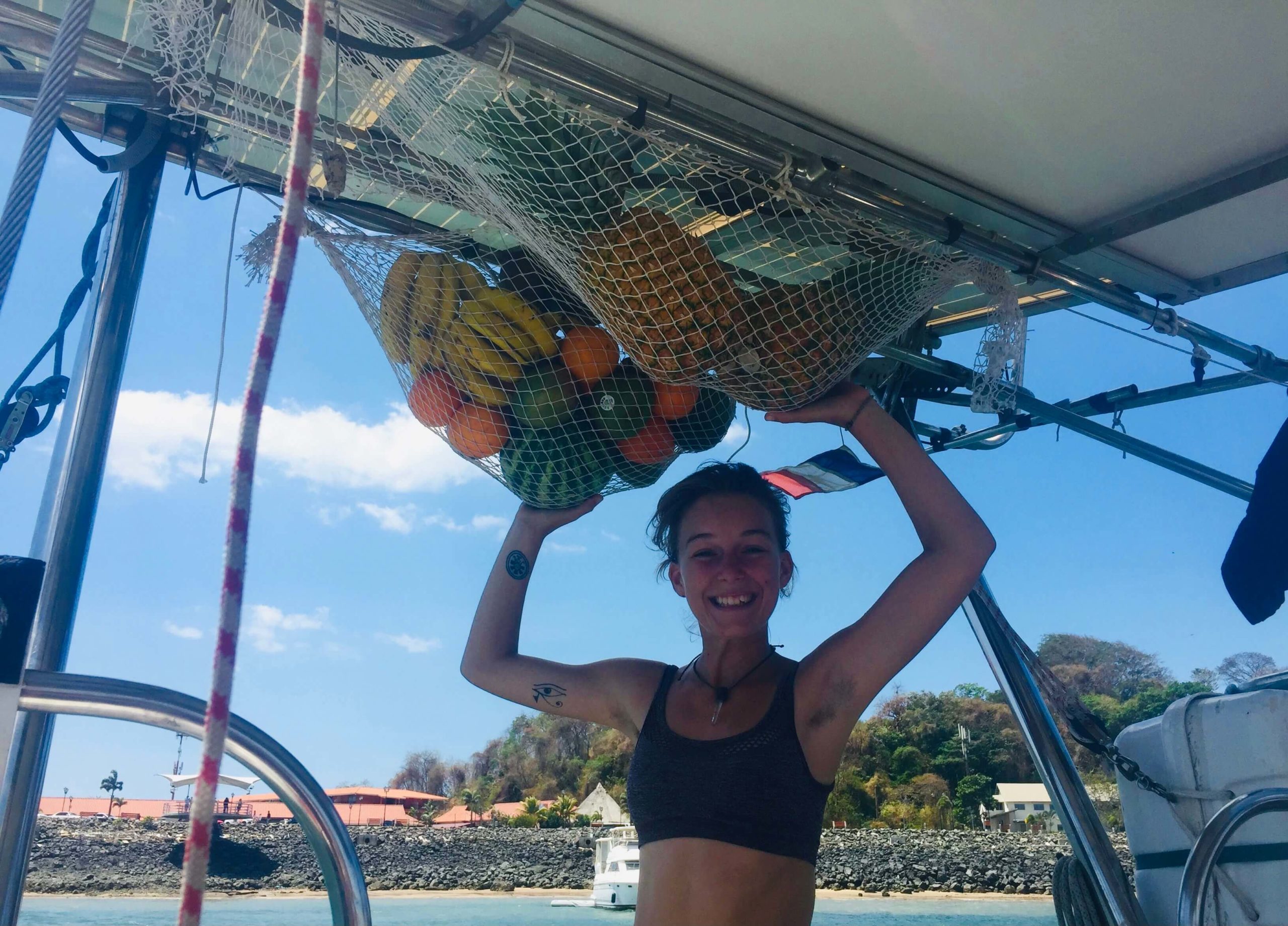
The consequences of your actions continue here. Even if you are sailing in proximity to shops or markets, the basic fact remains that the shops are on land and your boat is on the water.
That means there is no nipping to the servo for some extra milk that you forgot. You have what you have on the boat, and you make do.
So yeah, not bringing enough coffee for the passage? A dumb mistake you only make once.
Living on a sailboat has made me an organised (one might say obsessive, but one would be wrong) motherfucker. I am a HARDCORE list-writer, but you need lists when you live on a sailboat.
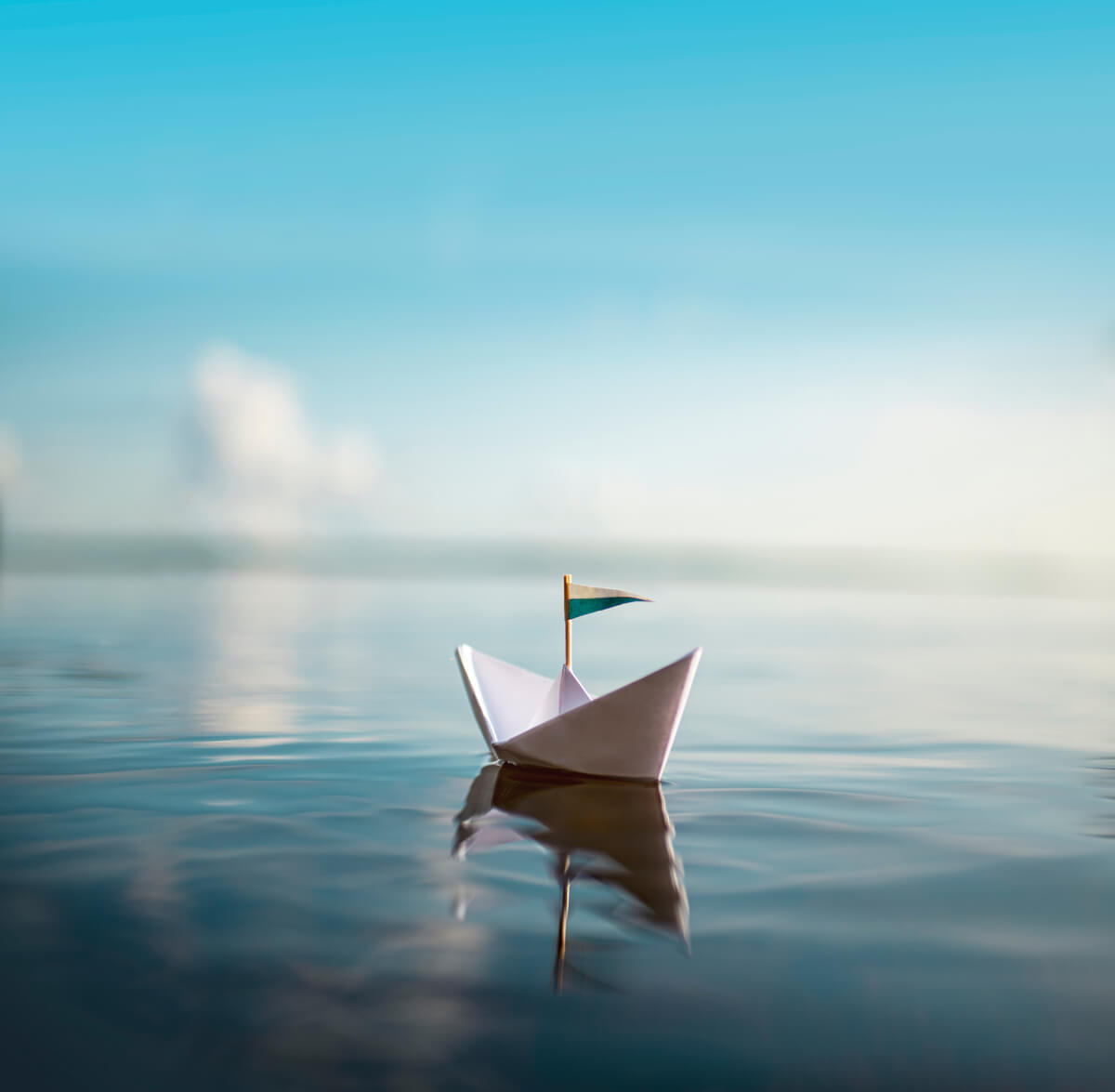
WRITE LISTS. And keep them going all the time.
- The food and supplies list.
- The fix-it list for maintenance.
- The visa requirements and beaurcracy list.
- The all-important books to read list .
If you go on an overnight sail and you know there’s food at the next anchorage, then you can get away with forgetting the coffee just this once. If you’re crossing the biggest ocean on Earth, that’s not gonna fly. You need to write a bloody list.
Also, food sometimes needs to be refrigerated. Refrigerators come with limited space and the frustrating tendency to gain sentience halfway through a passage. With sentience comes a severe attitude and willingness to ruin your food.
All I’m saying is, you gotta plan your meals, know how you’re going to store them, and write lists.
Oh, and it sounds obvious, but while sailing, the boat moves.
Yes, the stove on a boat is on a gimbal which means it swings with the motion of the boat and compensates for the movement. But when King Neptune feels the sailors on board have grown too comfortable, the soup says hello to the floor.
Boat Life 101: How do I sail this thing?

If you can take a shit and cook a meal while on a sailboat, you’re 90% done.
Collectively, we humans have been chucking some cloth on a bit of wood to capture the wind since the original discovery of Australia and the Solomon Islands (50 000 – 25 000 years ago).
Over the millennia, the process has become more refined. Now we can sail upwind and tack and all this fancy stuff. But ultimately, with a little patience and a lot of practice, anyone can learn to sail.
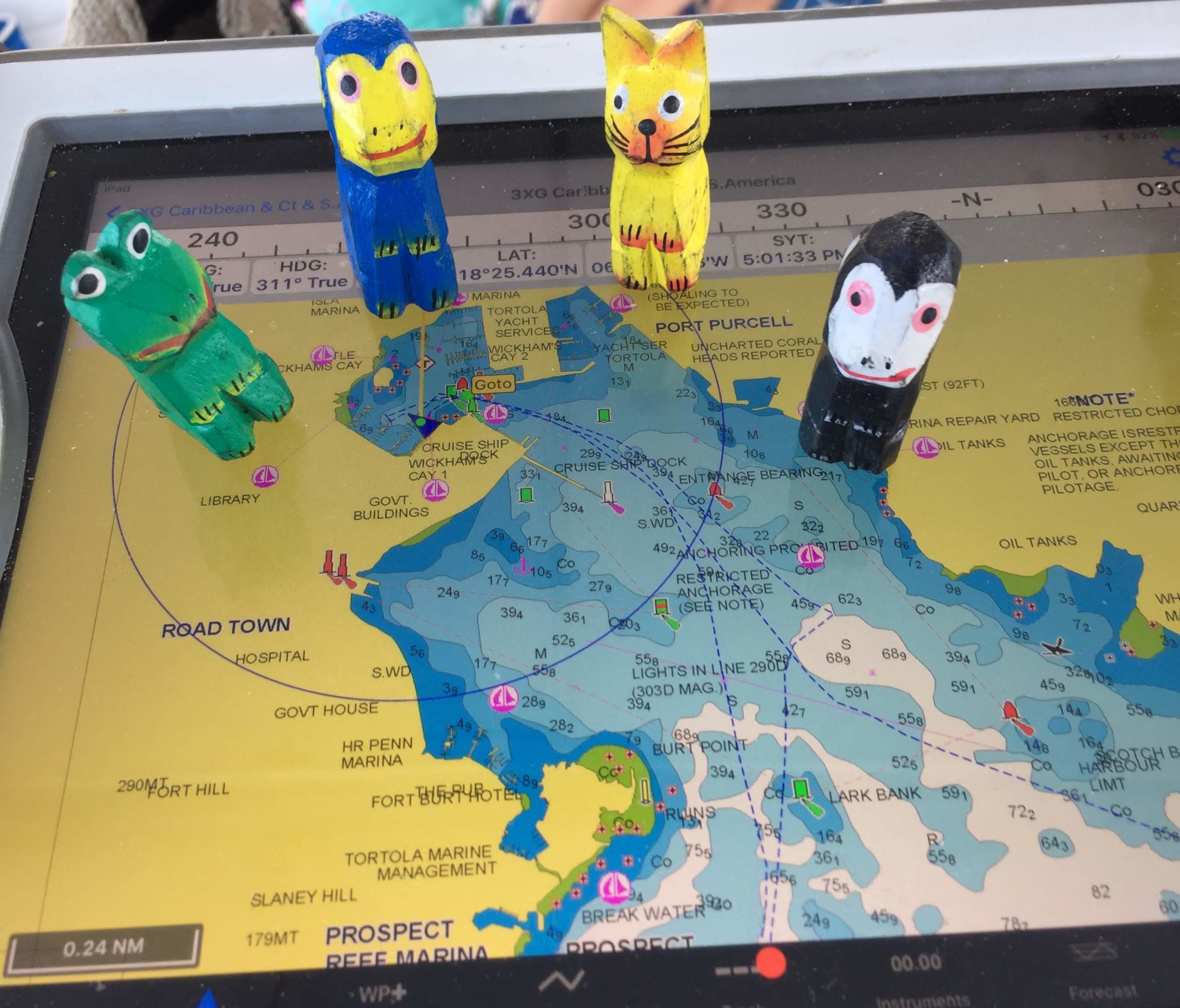
There is a multitude of electronic tools – chart plotters, AIS, GPS, Iridium GO – that help you keep a track of where the hell you are and give you detailed charts about where you want to go.
You can even get the weather sent in a tiny little electronic file via a device like the Iridium GO, even when you’re sailing across the Pacific Ocean . Very handy for avoiding boat-sinking storms!
Putting some sail on a mast and heading off has never sounded so sweet! But if you learn a thing or two about the trade winds , you can make your journey even sweeter.
The trades are these delicious winds that blow reliably from east to west, meaning you can access a reliable source of energy to propel you forward (provided you want to head west).
Trade wind sailing is famous for being fucking chill, with few gnarly storms and not too many becalmed days of boredom. The merchants of the tall ship days and the modern boat bum circumnavigating the globe both love the trade winds. Yes, for the easy sailing, and also for the good rum found at many of the ports along the way.
But when all else fails – say if your mast is struck by lightning and all your electronics are fried – there are still ways to orientate yourself on the big blue. These are methods that have evolved over our collective sailing history:
- Celestial (star) navigation : Using the constellations and a sextant, plus some maths, to figure out the boats latitude and longitude.
- Cloud navigation : Recognising the flat bottomed clouds associated with land to keep you on track back to terra firma.
- Reading the swell : This is just fascinating. This means understanding the persistent swell that move across world oceans and their relation to the star quadrants to estimate where your boat is and where it is going.
Test the Waters BEFORE You Sail – The Liveaboard Experience!
Another way you can get a taste of the boat life before you commit to a lifelong project is to charter a boat! Sailo does just that: Sailo lets you rent the boat life.
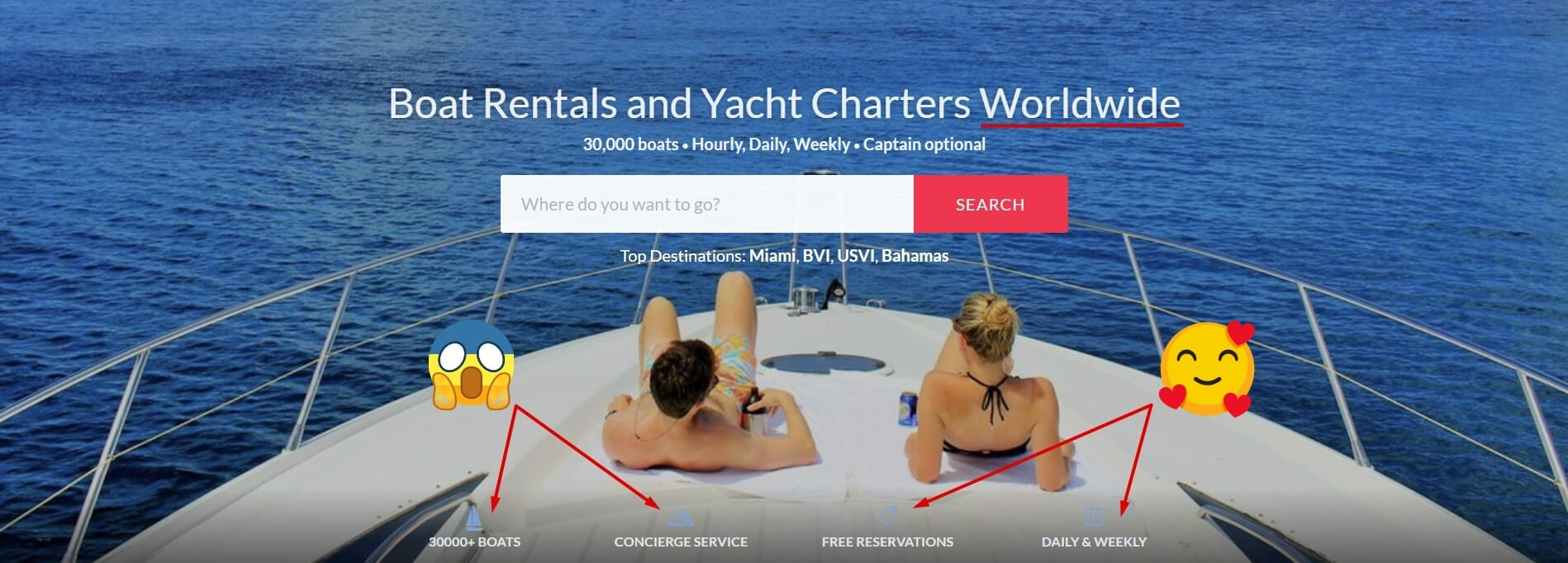
You get a boat, a sampler of the experience of living on a sailboat, and people on deck that actually know what the bloody hell they’re doing! With over 30,000(!) boats to charter from and a fabulous selection of the BEST places to live on a boat around, you’re guaranteed to find something that… floats your boat.
Sure, it’s not the no-frills boatbum style, but ultimately, you can choose to do it bareboat – with no captain and you bring all your own provisions. Or you can choose to have the boat crewed so you can sit back, relax and, learn a thing or two about boat life. (And drink champagne.)
Living on a boat comes with a host of challenges (and juicy rewards) that are made that much easier by picking a good place to do it in.
Access to quality boatyards, provisioning, internet connection – these are all big plusses for those living on a sailboat!
But also, all the stuff that made you want to partake in this mad boat lifestyle in the first place rate highly too. A plethora of remote beaches, magic sunsets, and a friendly cruising community of cool travel buddies (soon to become treasured friends) can make or break a dream destination.
I’ve also considered how easy it is to top up the cruising kitty with funds by rating how easy it is to find work in each place.
Australia + New Zealand

- When to go: November – May (NZ & southern Australia) April – September (northern Australia)
- Best suited liquor: EMU BITTER MAAAATE Whatever the Australians aren’t drinking.
I don’t care that the citizens of both these fine nations will be after me with pitchforks for lumping them in the same pile. Honestly, mate, bro, whatever, come at me. They’re both equally dope places to liveaboard your sailboat.
Yup, gonna say it right now, both these places can be expensive for the boat bum. But they also provide good-paying work opportunities if you can play the visa game right. So they are great places to slow down, pick up a travel job , and stack some cash for future ocean adventures.
You can also take a break from the boat life, and go on an epic backpacking adventure around New Zealand . You won’t know how much you miss the ocean until you take a break from her, trust me.
Also, the sheer diversity that I’ve so callously dumped in one heading is incredible.
Honestly, you can sail down to Stewart Island in the subantarctic waters and then back up to the Eden on Earth in the equatorial Torres Strait .
You could spend a whole, wonderful lifetime sailing between these two continents and still die regretting not having seen everything.
The long and the short of it:
- You can make bank here $$$!
- You can get your boat fixed properly here. Island nations like Australia and New Zealand have a wealth of boat building and fixing experience.
- There are well stocked supermarkets here, so you can stock up on bulk items that prove tricky to find in more remote locations.
- People are cool, remote beaches are cooler. And there is a metric shitton of incredible beaches here.
- There’s also an opportunity for non-boat adventures (like backpacking around Australia ) that will make you appreciate the ocean nomad life even more.
- Diversity! Of landscape and cultures.
- Dude, the first nations of Australia managed to cross over from Papua New Guinea (probably) 60 000 years ago. SIXTY THOUSAND (louder for those in the back). The knowledge on this ancient continent will humble you if you pause to listen.
- And the seafarers that made it to Aotearoa? The Maori are some of the most badass, friendly, wise, creative, HILARIOUS people you will ever have the privilege of meeting.
- $7 bottles of wine. Sorry. But like, yes please.
- There’s epic diving in New Zealand and all over Australia with endless (and scrumptious!) spearfishing opportunities.
- Living on your boat here is easy . Not without its struggles of course, but it’s always easier to struggle close to wifi connection.
The Caribbean

- When to go: The conventional advice says December – May, but you can sail here year-round if you know how to dodge hurricanes.
- Best suited liquor: Rum. Obviously rum. Maybe with a squeeze of lemon and a splash of cola.
If you can dodge the hangouts of the rich and the famous (or work out how to make money off them) sailing the Caribbean and living on a sailboat is very rewarding.
Salsa lessons in the streets of Puerto Rico , rum-soaked nights in the Virgin Islands , goat hunting, spearfishing , azure waters, and white sand beaches all the way down to Bonaire .
Getting into the charter boat game provides a great way to make dat money. During the high season, this is one of the most popular places in the world to charter a boat.
If you are happy to do your own boat repairs, a lot of fishing, and get clever with your travel budget , the cost of living in the Caribbean is not super expensive either. You just gotta know where to go for what.
Cheap coffee and rum can be brought in bulk in the Dominican Republic . There’s a Costco not far away in Puerto Rico , so you can get some bulk toilet paper. Then it’s onwards to a deserted island, a reef, and some endless fun in the sun.
- Cheap boat repairs are available in places like Rio Dulce, Guatemala. So, for those big projects you can save quite a bit of money by getting them done here.
- The rum. I mean, it has truly been perfected here.
- There are oodles of work opportunities in the charter business or in the superyacht world.
- Cheap flights back to the USA means you can feasibly travel between the USA and El Caribe guaranteeing you an endless summer.
- The glorious azure waters and their 27-degree celsius temperatures. Helllloo, nude night diving.
- Warm, deliciously WARM, diving.
- More people at the anchorages = a very social and welcoming community of cruisers. There is a great liveaboard culture that’s hard to replicate elsewhere.
- Easy trade wind sailing.
- Did I mention the rum?
The South Pacific
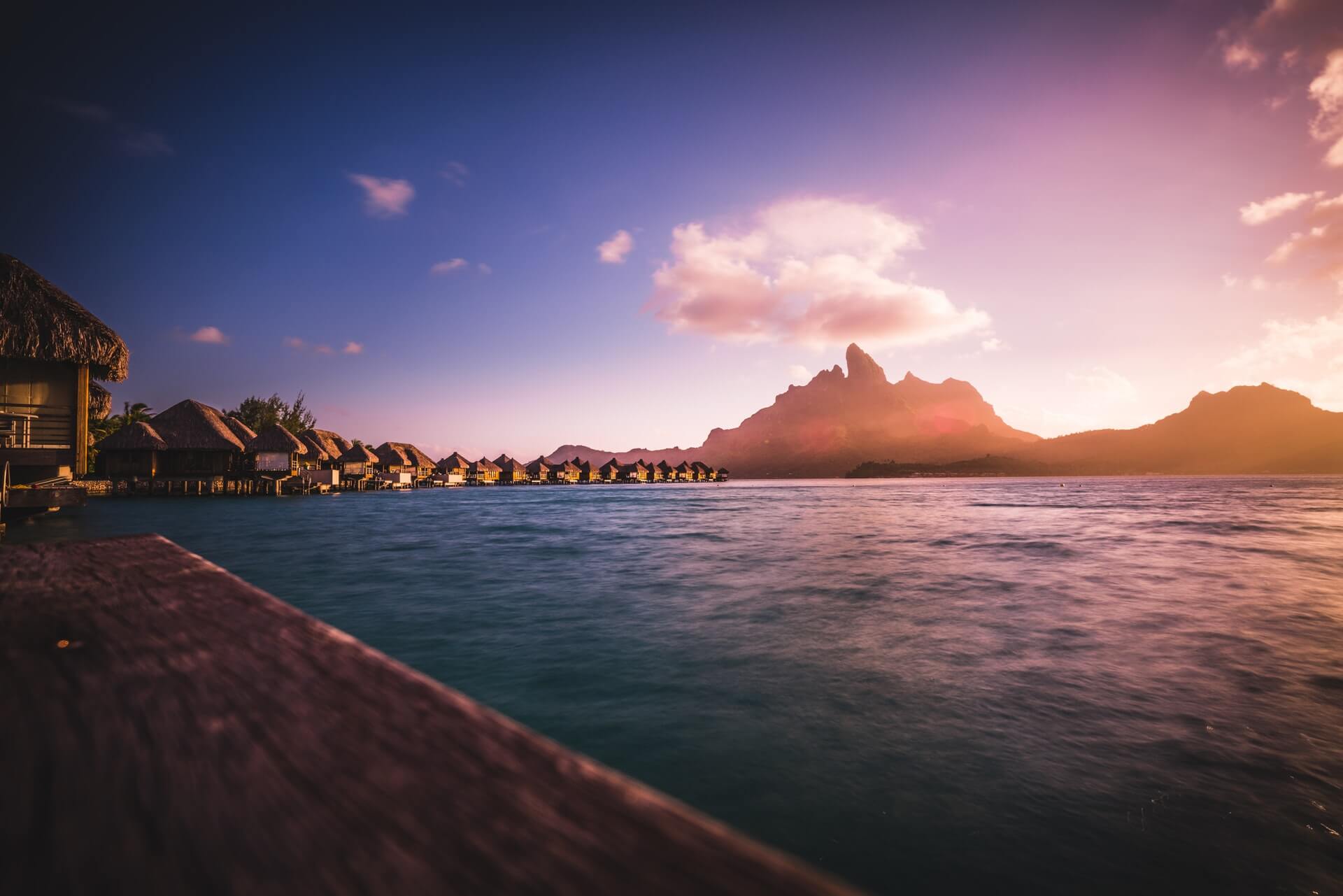
- When to go: May – October (You can arrive in the Marquesas in April with no problems.)
- Best suited liquor: A little vodka, a lotta soda, a squeeze of lime.
I won’t even try to hide my bias. I LOVE the Pacific.
Is it the best place to live on a sailboat for most people? Probably not. Because the distances between your boat and a grocery store are usually mind-boggling. It can be expensive. It can be lonely.
There’s just no way quite like travelling to places like French Polynesia the way you can on a boat. Out in the middle of the ocean life is not always easy, even if it is full of palm trees.
But fuck it, I love the Pacific, so we’re including it.
No, honestly, if you can mitigate the challenge of distance, you are rewarded with the best planet Earth has to offer. Incredible diving, a slow pace of life, some world-class hiking trails (and world-class peaks), lazy sunshiney afternoons. Perfect postcard sunsets. Mmmmm.
A full one-third of the globe is consumed by the Pacific Ocean, and scattered throughout this utter vastness are innumerable tiny little islands. Luckily for the bum of the seas, the trade winds can carry you from the Americas to these little flecks with few problems.
In fact, all the technical sailing here is relatively easy. As long as you don’t get becalmed at the equator thanks to the weirdness of the ITCZ band, it is easy sailing.
But you’re going to need a water maker and have a solid solar panel set up for power. Because between Panama and the Marquesas , there are approximately 3800 nautical miles – more if you go stop in at the Galapagos.
That’s a long way between places to buy coffee. And there’s not much in the way of supermarkets until you get to Tahiti , another 800 nautical miles away.
If you leave IndigoRadio on for long enough, inevitably Kiribati will come up. You can hide from hurricanes here. The South Pacific is defined by island life at an island tempo:
- You can get delicious fish on the end of your gidji real fast here.
- People-less anchorages.
- Dreamy atolls.
- And not a damn supermarket in sight.
Ok, not everyone’s idea of easy sailing, but certainly my idea of the best that living on a boat has to offer.
There is a multitude of lifetimes that could be spent escaping the rat race and kicking back in the Pacific. There is an awesome amount of diversity of landscapes and cultures here too, not to mention a proud seafaring tradition that we aspiring boat bums should shut up and learn from.
A Tip From One Pirate to Another
Okiedokie, you wild little circumnavigator-to-be! There are multiple ways to criss cross the globe. Resources like noonsite.com and Jimmy Cornell’s cruising guides will be invaluable to you in the planning and execution stages of your journey.
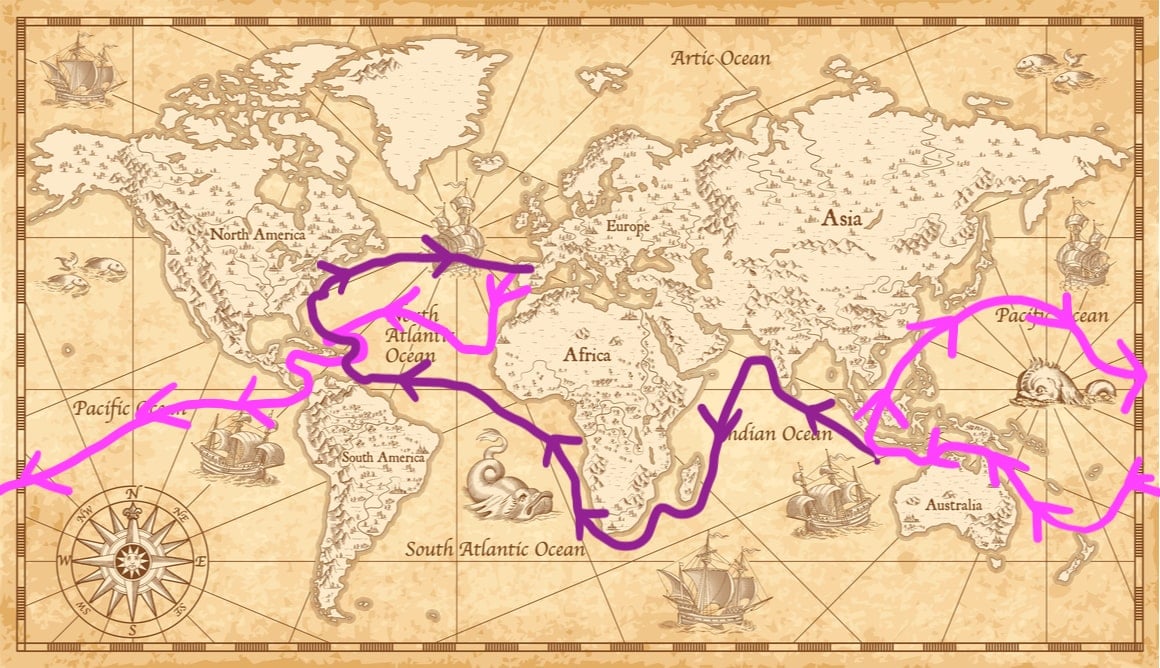
But at a glance : I would suggest starting in Europe and the mediterranean and picking up the trade winds west across the Atlantic in this order:
- Through the Caribbean and through the Panama Canal.
- Onwards across the South Pacific, kissing New Zealand and Australia before either…
- Circling through South East Asia and back across the Northern Pacific…
- OR continuing up past Sri Lanka then…
- Around the Cape of Good Hope before…
- Going back across the Atlantic and the northern coast of the USA and back home!
Use the trade winds to your advantage! Go west until you can go west no longer.

Things go wrong on the road ALL THE TIME. Be prepared for what life throws at you.
Buy an AMK Travel Medical Kit before you head out on your next adventure – don’t be daft!
No sugar coating here. Buying and maintaining a sailboat, no matter how much it resembles a tin can, adds up real fast.
But when the eternal sunshine and the lessons of the great blue spectacular call you – when King Neptune drafts you into his eternal service – it’s time to find a will and a way.
Here are a few tips to help you plan a trip that I’ve picked up from my short time making various vessels my temporary abodes:
- Don’t buy a project boat unless you want a project. It will cost you more to fix everything on a broken boat than it will to buy a boat that’s good to go.
- But, when you do need to repair, DIY. Endless learning, yay! Or, plan your sailing route to include time in places like the Rio Dulce where repairs are cheaper.
- Anchor more often than you stay in marinas. Marinas are devilishly expensive; anchoring is deliciously free.
- Volunteer on someone else’s boat before you get your own. 😉 If done right, this is win-win. You can take share in the labour of running a boat (for example by standing night watch) while learning the finer points of sailing from a master.
- Get seasonal work. There are so many options when it comes to this, from ‘backpacker’ staples like agriculture and hospitality to working on superyachts or as dive instructors.
- Or have residual or passive income if you’re real cool. If you’re on that elusive property ladder or earning money online , why don’t you have a boat? Just head off now and live off your automatic wealth. Be a cool kid.
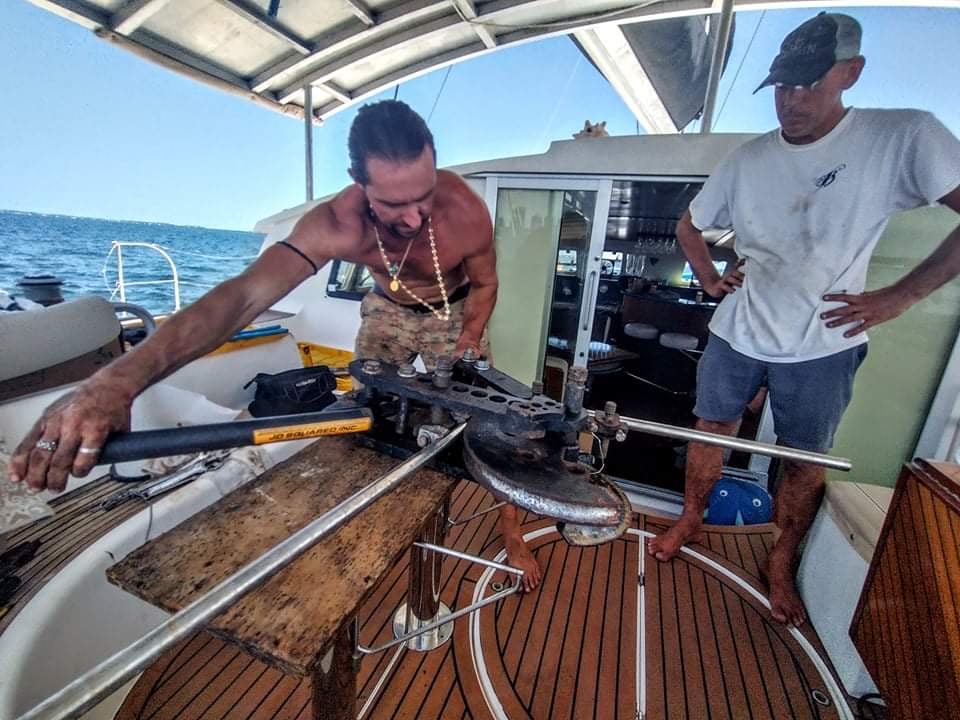
Of course, when a backpacker asks about the cost of living on a sailboat, they really want to know if you can live on a sailboat for free. When a family looking to take a sabbatical asks about the cost of living, they just want to know hard numbers and a budget breakdown.
At the end of the day, you can hoist a heavily patched sail on a jerry-rigged mast and work on the boat yourself, and eat only what you catch or grow. At the other end, you can set sail on a superyacht replete with full-time staff and jetskis.
We anchor in the same sand and watch the same sunset though, so you choose what you need to spend.
I would suggest being honest about your lifestyle. Consider being a little obsessive organised about your annual costs. Because costs are going to vary greatly from boat to boat.
How Much Does it Cost to Live on a Boat? (Pricing Breakdown!)
Obviously, the variables that go into the cost of running a liveaboard boat are vastly dependent on your style of living and where in the world you are sailing.
Generally speaking, it is cheaper to spend more time at anchor and in countries with a lower cost of living. However, insurance will still be 1% – 2% of the cost of your boat and port fees are port fees. Still gotta pay ’em, whether you’re a broke bum or a gazillionaire.
Sailing and Diving Go Together Like… Sailing and Diving!
A way to combine two of the best things on Earth is to indulge in a liveaboard experience .
This is exactly what it sounds like – you live aboard a boat, usually in some fantastic and tropical destination. You can indulge in some wonderous diving, and pick the brains of the crew about their tips on living aboard a vessel!
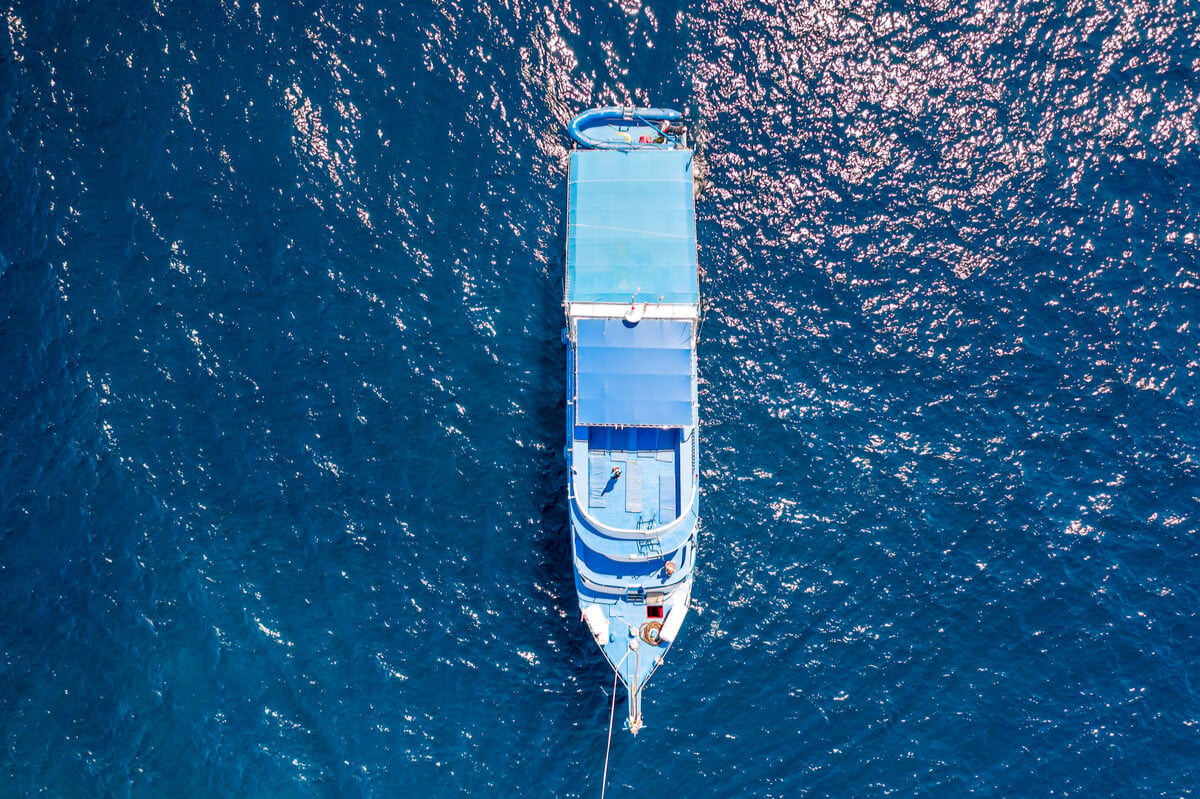
The focus of the liveaboards is the epic diving experiences in destinations that just aren’t as accessible when travelling in other ways. Also, it’s a great inspiration for you to hustle your way onto your own boat so that diving amongst reef sharks becomes as normal as your morning coffee.
Now the controversial stuff.
I’ve had someone say, a little tongue in cheek: damn yachties get the wind for free and now they want everything else for free!

While I think being resourceful and a bargain hunter is the best way to live your life, boat or no boat, it’s just as important to have a bitta respect. So when you hit the seas or the road, I don’t see the point in haggling hard over what amounts to 50 cents.
When it comes to boat stuff, in particular, break it down into your shelter, food, and fuel, and don’t aim to get everything for free .
Aim to sustain your lifestyle for as long as possible in a way that doesn’t compromise it for everyone else. In other words, be ethical about your damn budget travel. The most rewarding consequence of trying to keep costs down is creating a more or less self-sustaining yacht. Better for you and your personal growth; better for this pale blue dot we call home.
Sailboat Cost Cutter #1: Shelter
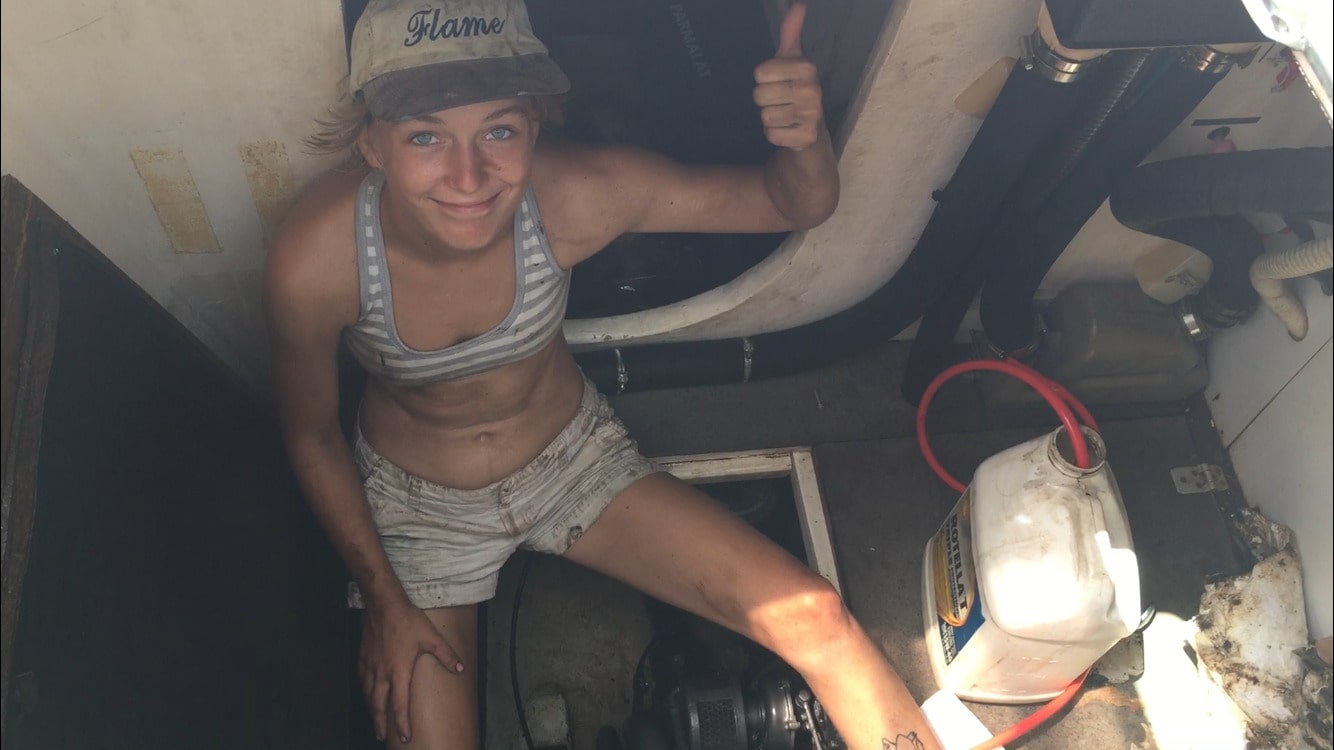
Maintaining your shelter (i.e. your boat) is not going to be a ‘free’ exercise. You will pay with money, or your own labour and time, to maintain it.
It will be an exercise in learning all kinds of systems – both mechanical and electrical – and time management. Do you want to pay for that task with money or your labour? Whatever you land on for each maintenance task that inevitably comes up, you will learn that to sustain this boat bum lifestyle you just gotta take care of your wee home and she will take care of you.
It is always free to sleep on your boat while underway. Well, it doesn’t cost any money anyway. You are investing a lot of time and energy into the passage, but you’re not paying to sleep on your boat!
Once you arrive, you can choose to stay in a marina, on a mooring, or at anchor. Anchoring will always be the cheapest (usually free) and so you don’t have to spend a lot to live in paradise. But don’t be a dick.
- Have the right visa.
- Be respectful of others in the anchorage.
- Don’t dump shit (literal or otherwise) overboard unless you are sure you’re allowed to.
- Be friendly and offer your neighbours a hand if they need one.
This lifestyle can bring out the best in us provided we’re responsible travellers , so lean into that.
Sailboat Cost Cutter #2: Fuel
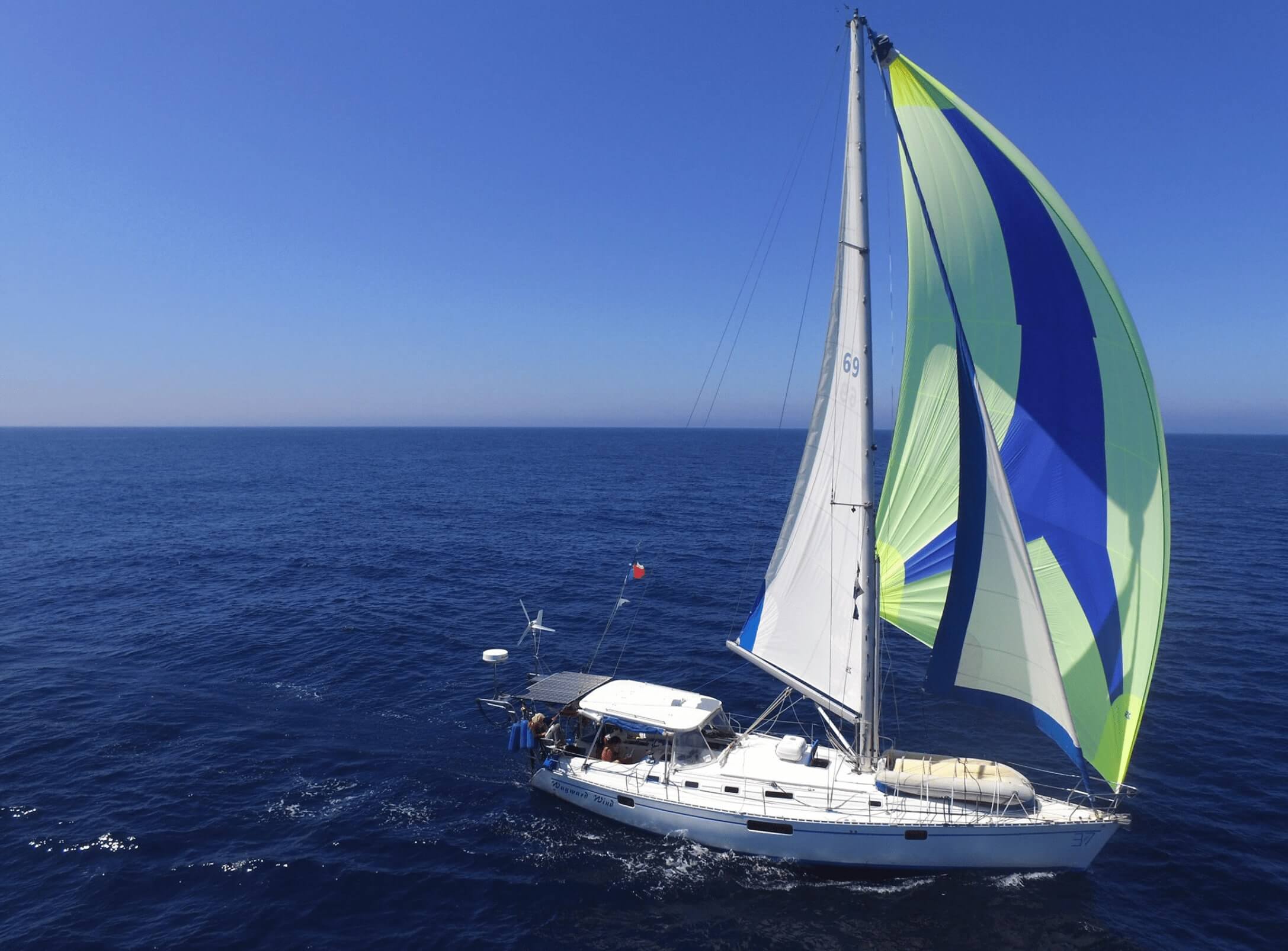
As my friend said, damn yachties get the wind for free! Much of the energy needed to go from A to B is yours for the taking, provided you can harness it efficiently with your sails. But as with DIY vs paying for repairs, sometimes you pay just as dearly with your time as you would have with your money.
If you are becalmed, the engine may be just the thing to help you out. When coming into a marina, you’re not going to want to be under sail. Likewise, in a storm, it is time to put the sail away and turn on the engine for stability. So having a little diesel onboard is necessary.
Compared to land life, people living on a boat can minimise their carbon footprint and live very simply. But it’s difficult to ask the Earth for none of its resources. Just be mindful about the way you live, be eco-friendly , and try your best to not waste resources.
You can recharge your boat batteries for electronics with the sun though – provided you can harness it with solar panels. And a lot of liveaboards will have a wind turbine for extra power on the less sunny days. This stops you from needing to use the engine so much. Yay for money, yay for the environment.
It’s never going to be completely free. You either pay with time or money. But you can certainly save a lot of money on fuel while living on a boat. This is a rewarding way to sustain your lifestyle and be kinder to the planet.
Sailboat Cost Cutter #3: Food
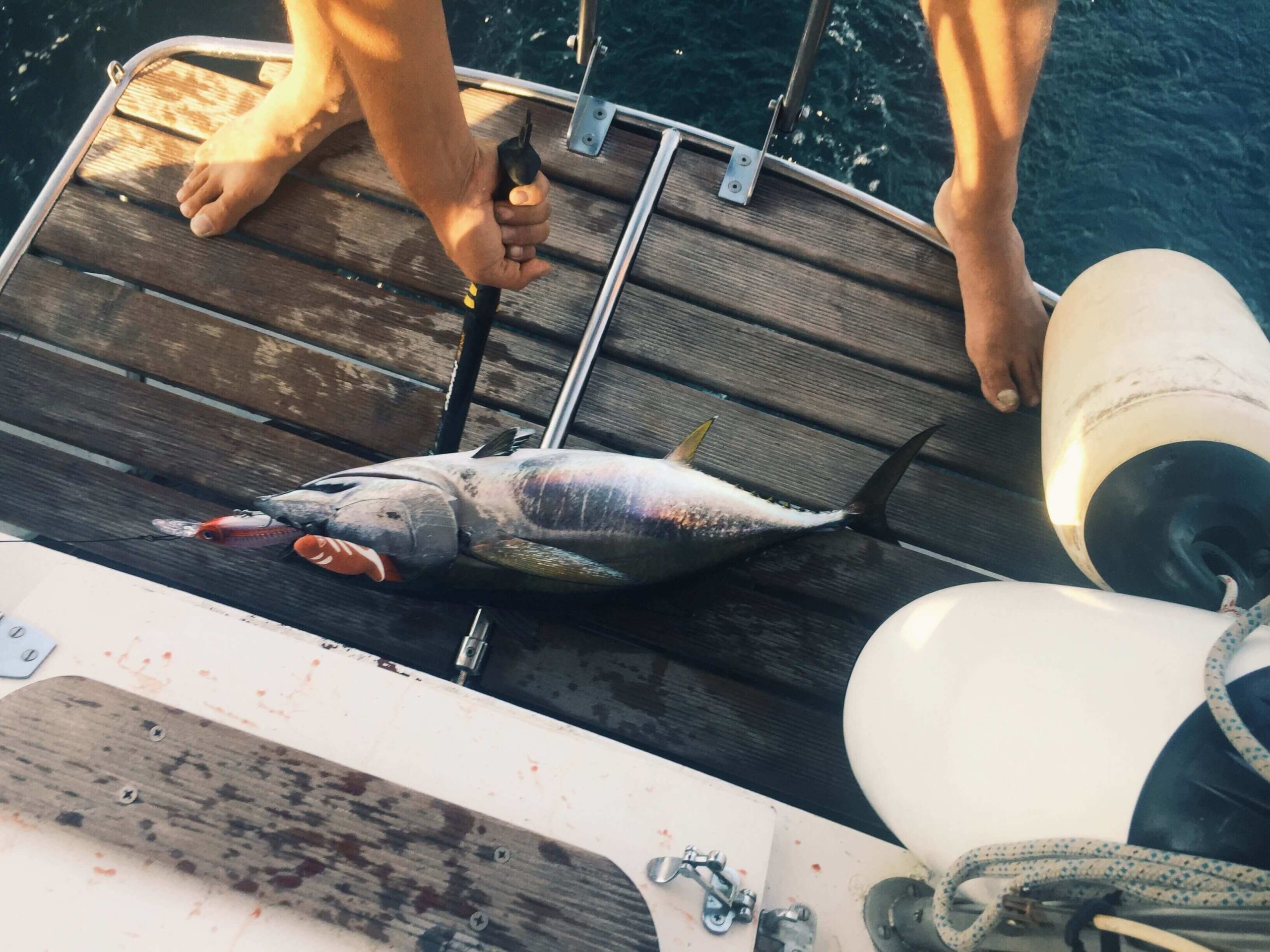
I apply the same principles to food as I do to food and shelter: you pay with money or you pay with time and labour. Also, don’t be a dick, and be good to the environment. What comes around goes around.
This means, when it’s available, I will spearfish and I will hunt. This is me paying for my food with my time and labour rather than money. But I would also argue that it’s fulfilling my other principles of:
- Not being a dick and…
- Being good to the planet.
Hear me out: I think vegans and hunters alike would agree that factory farming and the industrial scale of meat production are fucked up. It’s a waste of our water, arable land, and produces poorer quality meat. Furthermore, the animals suffer tremendously.
But if I’m kicking it in Kiribati, there is no way I’m going to be a vegetarian and still believe I’m doing a solid for the planet. The carbon footprint required to get my strictly vegetarian tofu to the remote islands is greater than the carbon footprint of me harvesting a fish every few days.

That fish has swum about its whole life having a good time doing cool fish stuff. And then, like all of us will, it died. I have immense gratitude toward this being for providing me with sustenance. I feel like I am part of a cycle of life that predates my puny existence.
In the same vein, to bring tofu to the Caribbean has required a process that is on the whole less ethical than going for a shoot and getting a feral goat for dinner.
The land cleared to grow the soybeans + the production of soybeans into tofu + the carbon cost of flying the tofu product into the island = YIKES.
The feral goats that destabilize delicate island ecosystems? They had a good goat-y life and then they became a good goat-y curry that fed 12 people.
Ok, I’m done. Eat meat or don’t; ethical animal tourism and all that jazz, however, morality is complicated. There are ways to reduce the money you spend on food and your carbon footprint without being a dick.
I’d also say that in the process of harvesting your own food, you gain a greater appreciation for life on this planet. And get a sense of urgency around stepping up to protect it. Give it a try; you might be surprised.
Epic Tips for Broke Boatpackers
- Know your knots. Apart from knots being fascinating in their own right (knots were probably invented alongside stone tools?! ), they are the foundation of boat life. Knowing a couple of basics , like a bowline, will give you a good leg up when joining a boat.
- Be able to cook at least two decent meals, also be clean. You aren’t only working, but living on this boat with someone. Take care of your space and bring some good food to the table and you will go a long way as a crew member.
- Go to docks and ask around. This is a good way to meet people – even if you just end up crew for a day sail. Be friendly, make yourself known, and find you’ll find yourself on a boat in no time.
- Facebook can be your friend. When walking the docks fails, there is a multitude of Facebook and other social media groups dedicated to connecting wannabe crew with boats!
- Know how to write about yourself on your Facebook adverts. But you’ve got to know how to sell yourself! If you can cook a bomb-ass puttanesca and can tie a reef knot – mention it! Don’t sell yourself short! That being said, don’t exaggerate and tell fibs about the sailing experience you (don’t) have. The truth will come out painfully during the first bit of real sailing you do, so be honest. There’s usually captains willing to teach the basics for a bit of company and a good meal.
- Knowing how to fillet a fish is handy. Sailors know how to sail. They don’t necessarily know how to fish. So if you can bring this skill to the table, you’re going to be a beloved crew member in no time!

Drink water from ANYWHERE. The Grayl Geopress is the worlds leading filtered water bottle protecting you from all manner of waterborne nasties.
Single-use plastic bottles are a MASSIVE threat to marine life. Be a part of the solution and travel with a filter water bottle. Save money and the environment!
We’ve tested the Geopress rigorously from the icy heights of Pakistan to the tropical jungles of Bali, and can confirm: it’s the best water bottle you’ll ever buy!
Sweet, glorious tips from a pro-pirate to a soon-to-be, the seas are calling, so go sail them!
Stay Safe, Boat Bums!
One thing that many intrepid little sailors are not good at? Estimating danger and the likelihood of death.
Maybe this is a good thing because you do have to be the right sort of mad to get into a sailboat and cross an ocean.
Maybe, just maybe, you should consider purchasing travel insurance before shit hits the fan though. But enough from me, hear it from a fellow adventurer.
ALWAYS sort out your backpacker insurance before your trip. There’s plenty to choose from in that department, but a good place to start is Safety Wing .
They offer month-to-month payments, no lock-in contracts, and require absolutely no itineraries: that’s the exact kind of insurance long-term travellers and digital nomads need.

SafetyWing is cheap, easy, and admin-free: just sign up lickety-split so you can get back to it!
Click the button below to learn more about SafetyWing’s setup or read our insider review for the full tasty scoop.
FAQs About Life on a Boat
Here’s what I know you want to know about living on a boat!
What is the cheapest place in the world to live on a boat?
This will depend on your spending habits, of course. If you give yourself a budget of $3000 per month, you will spend $3000 per month. That being said, travelling around Southeast Asia and South America is an exquisite choice. They have superb cruising and a low cost of living. The Philippines stands out as a paradise to explore while on a budget.
Can you live on a boat in a marina?
You absolutely can! Now, call me biased, but the point of living on a boat is to go adventuring so I’d keep marina stays strategic . Only stay as long as it takes to get repaired, or get provisions, and then take off into the sunset!
Can I sail around the world?
It doesn’t take much to put the sails out and follow a bearing. It also doesn’t take much to lose your mast in a surprise squall. Of course, you can sail a boat around the world, but you need to be organised. Provisions, finances, weather. The trip of a lifetime is not for the faint-hearted. Not that that should stop the intrepid adventurer!
SOMETHING REALLY IMPORTANT NOT TO FORGET
Follow instructions and ACTUALLY LISTEN. Put that ego aside, mate. The Captain ALWAYS has the final say, and if they say duck, you DUCK. The boat life can be real unforgiving. Oh, and learn how to handle your rum! It’s a pirate’s life and, well, nobody wants to be at sea with that guy…
Do sea monsters really exist?
Oh yes. Without a doubt. You just won’t meet the monster until you’ve been at sea for more than 25 days straight. The crew are tired of each other. The boat keeps breaking. There’s a storm on the horizon. It’s night watch again and the clouds are hiding the stars. You wonder if your mother is worried for you and when you might be able to call her again. Briefly, you lean over the side of the boat and wonder what it would be like to just walk off. Would you sink or swim? The sea monsters don’t live in the sea.
Fair Winds, Sailor!
Living on a boat will challenge you.
There is no other lifestyle that forces you to be attuned to weather patterns, engine maintenance, personal dynamics, ethical dilemmas at every mealtime; to consider watermakers and wind turbines; to completely surrender while also stepping up and getting shit done.
The nitty-gritty of how to live on a sailboat will not be fully revealed to you until you step onto one and do it. But, if you can poop and provision you’re halfway there!
You gotta lick your finger and hold it up to the wind. Ah yes, the trades blow west. Rum and a seriously sexy sunset await.

And for transparency’s sake, please know that some of the links in our content are affiliate links . That means that if you book your accommodation, buy your gear, or sort your insurance through our link, we earn a small commission (at no extra cost to you). That said, we only link to the gear we trust and never recommend services we don’t believe are up to scratch. Again, thank you!
Indigo Blue

Share or save this post

I truly enjoyed this read. I am under a government contract for the next while, but have a plan to retire and become a full timer somewhere warmer than Canada. I have been making my own notes and your writing gave me plenty more tips. Please feel free to email and keep me in the loop. Thanks so much and happy sailing!
Amazing read, thank you so much! I’m planning to get on with my own boat living dream and was curious if you (and fellow readers ) could share your thoughts on some of the big issues of boat living you have experienced? Much obliged 🙂 Keep up the good work!
First of all, welcome to the boat life! Biggest issues: Realistically the biggest issue is usually finances. The ocean is constantly wearing away at your boat and trying to sink it. Buying and maintaining a boat is expensive. That’s why so many boat lifers end up in the charter or delivery business – either as crew or as owner/operators – because it pays well.
Once you have your cruising kitty sorted, the next biggest issue is crew dynamics. Sailing alone is demanding, lonely, enthralling, and incredible all at once. Having crew on board and stepping up as captain is a trip in itself. Managing a team is always challenging – let alone when your team lives on a tiny sailboat and is constantly fighting the elements and can never take a break from each other.
The actual sailing and reading of the weather – that stuff becomes easy! This is why you should make yourself stop every so often and remind yourself how wild and wonderful it is that you’re getting around using the freaking wind! Also, the stars, man. If there’s one reason I’d cross the Pacific again for, it’s the stars.
Good luck and fair winds!
That is a f*cking great 101 boat guide! ahah Thank you Indigo for it and welcome to the writer’s team 🙂
Leave a Reply Cancel reply
Your email address will not be published. Required fields are marked *
Save my name, email, and website in this browser for the next time I comment.
Notify me of followup comments via e-mail.
Save 40% off! Join our newsletter and get 40% off right away!
Sailboat Life
Sailboat Cruising and Lifestyle Magazine.

How to Live on a Sailboat for Beginners

This is a guide for how to live on a sailboat – but be warned, if you have any desire for the liveaboard lifestyle, you might quickly become on of us! Living aboard a sailboat requires an enjoyment of water, being okay with small living, and a sense of adventure. It’s not hard to begin living on a sailboat, but a few tips can help.
Let’s consider a few basic liveaboard questions first:
Is it living on a sailboat a good idea?
Living aboard a sailboat give you freedom that you won’t find in any other lifestyle. A suburban house can not be moved from place to place. But living on a sailboat gives you the options to live anywhere – literally in any country in the world! Living aboard a sailboat offers such a unique feeling of freedom to explore that you won’t find anywhere else.
Is living on a sailboat hard?
It is tough to live on a sailboat in a place like San Francisco where everyone is trying to escape super-high rent. In resort areas, many marinas have years-long waitlists for a liveaboard slip, and these slips cost double than a regular slip. However, not all places, in fact most places are easy to liveaboard.
Are you thinking about living aboard? Well, it takes time, planning, and preparation to being living on a sailboat. Here are a few videos to help you make a few calculations.
Adjusting to Liveaboard Life
Today, Emily sits down with 3 other female friends in the harbor to chat about how they transitioned from being landlubbers to liveaboard sailors in recent years. We’ll let you in on the conversation, and 4 different perspectives (though there are MANY others in the world).
- Emily, 34, aboard Temptress – liveaboard for 5 years
- Kris, 57, aboard Sixth Girl – liveaboard for 1 year
- Meredith, 44, aboard Tla Hla – liveaboard for 3 years
- Hannah, 26, aboard Sojourner – liveaboard for 2 years
How to Afford and Start Living Aboard
Your dream is to become a liveaboard? You want to know more about sailboat life, and what it means to live on a sailboat? You want to know how to afford living on a sailboat and how to afford staying liveaboards? How it feels to daily hoist the sail and follow the wind?
Start Small, Start Now
One philosophy in getting started living aboard a sailboat is to start small, start now. That doesn’t mean you have to buy a major refit project of a sailboat. You can get started in a small 24 foot single cabin boat for less than $10,000 or a mid-size 36 foot sailboat (see video below) for less than $60,000. Or grab a 1980s fixer upper that’s 42 feet in length that costs $25,000 – but beware, a fixer upper is a major expense even when you do it yourself.
Is Living Aboard for You?
No one can answer this question except you. However, if you enjoy freedom, have a sense of adventure, and love the water, then you might enjoy living aboard a sailboat.
We hope you enjoyed this how to guide for life on a sailboat for beginners. Leave us a comment or question a below.
Share this post!
Throw in your two cents, start a discussion cancel reply, related articles.

The Voyage of the Sea Star – 35ft Sloop to Bermuda

Living Aboard a 30-36ft Sailboat: A Guide for the Curious and Adventurous

Summer Sailboat Video, Bikinis, Sails, and Fun

Saved Up For This Dream

Living On A Sailboat In A Marina; Things To Consider
Have you ever wondered what it is like living on a sailboat in a marina? Maybe you’re thinking about buying a sailboat and becoming a liveaboard. Maybe you want to lessen your rent. Maybe you want to become a minimalist and lesson your carbon foot print. All of these are good reasons to want to buy a sailboat and live in a marina, but there are many things you will want to consider before taking that leap.
I bought a sailboat in January of 2017 and moved aboard her that following April. I have been living aboard ever since. I bought the boat to start on the path of living my dream, to sail around the world. After over 2 years living on a sailboat in a marina, I can tell you a thing or two about what is good and what is not so good.
As I sat and thought about all the pros and cons of living on a sailboat in a marina, I also found that some of the items on the list were both, and neither. So rather than just putting out a list what is good and what is not so good, have formatted this blog into highlighted areas to consider and have left it to you to decide if it goes in the pro or con list.
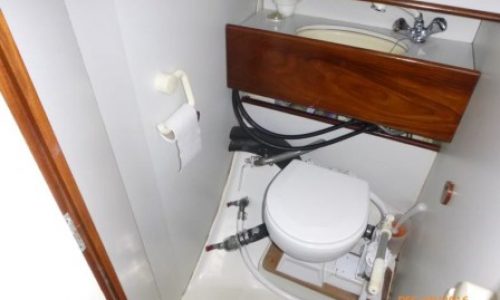
The Head (a.k.a. the bathroom)
This is probably one of the biggest, not in size, yet least thought about things that changes when it comes to moving onto a boat. That is why I am leading off with it. Even being a single guy, this is definitely on the con list for me.
Alright, let’s talk about size. Ask any girl, size matters, especially when it comes to bathrooms. I’m going to warn you, this is not a bathroom, it’s a head. Being a head means it is all things a bathroom is, but in the size of a shower stall. Yes, I said it correctly, a head is generally no larger than a shower stall, if you’re lucky, it will be the size of a full size shower.
There are two types of heads, a wet head and a dry head. I have one of each on my boat. The deference is a wet head has the shower in it, a dry head has the shower area separate. When it comes to living aboard in a marina, I opt for the dry head.
When you use a wet head, you have to basically take everything that can get wet out, even if it isn’t going to get wet, it will with the amount of humidity trapped in such a small area. Trust me, I lost a lot of toilet paper that absorbed a lot of moisture when I had to use the wet head after my shower pump died. To answer the next question, it was tucked away from where the water could get to it.
Speaking of pumps, keep in mind everything has to get pumped out of the boat; water and sewage. Yes, you get to become your own septic guy. Whatever gets pumped down the toilet, goes into a holding tank. From there you have to take the boat to a pump out and, well, pump it out.

You can always alleviate this issue by using the marina bathrooms. When I was living on my sailboat in the marina in Seattle, Washington, using the marina bathrooms was actually nice. It was clean, warm, and well kept. Here in Sitka, Alaska, it is a little different. The harbor bathrooms are public restrooms and are not well kept at all. Worse is the majority of the homeless population use them to both relieve themselves and as a warm place to sleep or sleep it off. Luckily for me, the harbor is just down the road from where I work and I have access to that 24/7.
This is one of the biggest considerations to make, whatever you do, don’t be one of those who just pump their poo straight into the harbor. Not only is it illegal, it is just disgusting. Nothing will ruin your get together with friends quicker than watching a turd float by your boat while you’re eating.

Related to, and often in the head, is the shower. When you move on to a boat, you will experience a change in how you shower. Again if you live in a marina that has clean and tighty bathrooms, use those, but I still suggest wearing flip-flops.
If you are showering on the boat, the first issue you need to overcome is the limitation of hot water. Most boats have relatively small hot water tanks, I am blessed with a very large 12 gallon tank. That said, the day of taking long hot showers if over.
The best way to shower on a boat is the military way. In basic training there were three shower heads and two spaces in between. Just like on a boat, you get wet, lather up, rinse off, wash hair, and rinse again. I have it down to get wet, lather up including hair, and rinse off. I average about 2 gallons of water per shower.
I know I have 12 gallons of hot water, but I also only have 90 gallons total of water. The more you use, the more you have to fill the tanks. In the summer it isn’t an issue, but in the winter, when the dock water is frozen, it can get interesting.
Also keep in mind, the more hot water you use, the more moisture is in the boat. The more moisture that is in the boat means there is more chance of mold and mildew starting to pop up. So you learn quick, short showers, with as little steam as possible.
The Galley (a.k.a. The Kitchen)
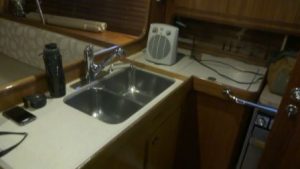
The galley is another big difference when living on a sailboat. It’s not so different from a normal kitchen, it is just condensed. Everything about a galley is smaller. Depending on the boat, you may also lose some things.
We’ll start with the stove. I have a good three burner stove with oven. Some boats don’t have an oven and some only have two burners. I rarely need more than two burners, but it is nice to have the option. Also the oven is very small comparatively. For Thanksgiving I have to be very careful about measuring my turkey to make sure it fits. Good thing I’m not cooking for the masses, I’d have to come up with another plan.
Another issue with the oven is most boat ovens are regulated by the size of the flame. They don’t have a set it and forget it temperature selection gauge. It really just takes some playing around to figure out what works best, but once you figure it out, it isn’t an issue any more. Until you figure it out though, keep a close eye on the temp or you will burn or under cook everything; I’ve done both.

Another difference you will find is in the refrigerator. The fridge in a galley is going to come in one of three configurations. You will have an icebox, a fridge, or a fridge/freezer combo. The majority of boats do not have front load fridges, this prevents accidental door opening during sailing and as some items shift in the swell, your food won’t end up on the sole of the boat.
Most fridge set-ups are going to be top load, which isn’t usually an issue, except, you will find that whatever you are after has sifted it’s way to the bottom. Maybe it’s just me, but it even happens when I’m tied to a dock.
I have seen a turn to more modern fridges in newer boats, but you will be hard pressed to find a boat that hold near what your home fridge does. I have been on some mega yachts with full size fridges, but beyond that, almost all the sailboats I have been on are top loading and small.
I am blessed and cursed to have both a fridge and freezer set up. The reason I say both, I love the freezer when I’m on the dock, but it eats power like mad when I sail away and anchor out.
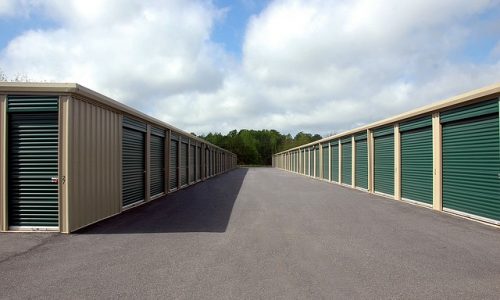
A good follow on for the galley is talking about overall storage. In the galley, and everywhere else on the boat, you are going to find you have limited storage. Overall each boat is designed differently and some have more storage then others. My sailboat is 38 feet long and has a moderate amount of storage for a boat its size, but I have also been on 36 foot boats with far more usable storage.
The reality of living on a sailboat in a marina is you will have to downsize. Downsizing isn’t really a bad thing. The whole idea of living the life of a liveaboard is to live a simpler life. That said you will have to do without some of your worldly goods.
In general the cabins (a.k.a. bedrooms) will have some storage for clothing and hanging cloths. The boat will have a hanging locker, much like a hall closet, but smaller. Most manufactures are good about utilizing the majority of free space to increase storage, but it also comes with some issues.
One of the issue is you will need to store things in sometimes not so easy places to get to. You will find with a little planning it isn’t a big deal. You put the stuff you use the least in the least accessible areas and the most used items in the most accessible area. The hardest part, for me at least, is remembering where you put what. The more storage areas you have, the harder it will be to remember where you put that last can of pasta sauce you know you have.
The next issue is what I call “Boat Tetris”. When you need to get to something, you have to unpack a whole compartment to get there and repack it when you get to what you needed. The fun part, just like when you take something out of the package it came in, it never seems to go back right.
There is also a lot you can do to expand on your storage space. I recently wrote a blog about 12 items that can dramatically increase what you can store in small areas . Check it out by clicking on the link.
Living Area

Right after storage, you will also note there is a lack of space in the living area. A prime example is my current boat. She has 2 cabins, 2 heads, a hanging locker, separate shower, galley, and the saloon (a.k.a. livingroom) all crammed into about 350 square feet.
This lack of space really isn’t a big deal when you think about it. I used to be a rent a 3 bedroom house kind of guy, even though I live alone. When you break it down, you spend about 90% of your time in about 30% of your homes square footage. You spend the other 10% of your time walking through the areas you don’t use to get to the other areas you do use.
You will have to make some concessions when living on a boat. Your 80 inch TV will become a thing of the past. Having a library of books, equipment for every hobby, and room to for all your tools; none of that exists, you’ll have to choose wisely what to hold on to. Sorry girls, if you have 37 pairs of shoes, you’ll have to lose those too.
You’ll have to narrow what you own down to a bare minimum. If you want more, you will need more boat. More boat will cost more, more to moor, more to maintain, and more to deal with. I am assuming the majority of people who read this will be looking for the opposite.
There are a lot of workarounds for the lack of space though. I have a cloth screen with a projector. I get to watch movies between 60 and 120 inches, depending on where I put the projector. I also have learned what I need, and what I can do without. I replace the majority of my books with a Kindle. My stereo is now my phone and 2 Bose speakers. I have a laptop instead of a desktop computer. Mostly I live within the confines of what I can have.

The last big change is the amenities. When you’re living on a sailboat in a marina, you will not have some of the amenities you are used to. The high speed internet provider will not run a line down the dock to your boat. That means no cable either.
It is possible to put a dish on your boat and hotspots for mobile are less expensive than before. Additionally you can get satellite data now, but the price is still rather high.
It seems like such a small thing, but these days people are so attached to the web, it can be a major hurdle to overcome. The thought that you can’t watch the Super Bowl at home is enough for some to say “hell no, I won’t go.” For others it would be the inability to endlessly stream YouTube or Netflix. It seems like a small thing, but it really changes your way of life, though I think in a good way.
Wrapping it up
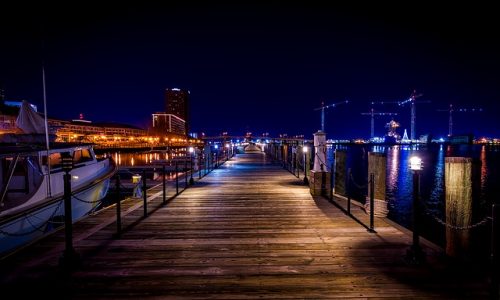
As you can see, there are a lot of changes when it comes to going from life on land to living on a sailboat in a marina. Some of those changes are minor and just take some getting used to. Others are major and will have you reorganizing your whole way of life.
In my opinion, it’s a good change though. You have less, but you also learn you don’t need so much. As I stated, you spend 90% of your time in 30% of your house.
So if you don’t use 70% of your house, why pay for it? I have also noticed with myself and every person I know, the bigger the house, the more stuff people store in it to fill the 70% they don’t use. Of all the things stored in those big houses, you guessed it, 70% or more of it is never used, touched, and in some cases, isn’t even known to exist.
When I moved aboard, I sold about 75% of my stuff. I am happier for it. I am living for less and feel I have so much more. I would only trade living on a sailboat in a marina for two things. One is a life at anchor, sailing around the world. The other is another story entirely, and one best left untold.
If you want to know more about living year round on a sailboat, check out my blog on living on a sailboat during the winter .
Don’t forget to follow me on social media so you don’t miss future posts!
Happy Sails!!
Follow Me on Social Media
You might also like.
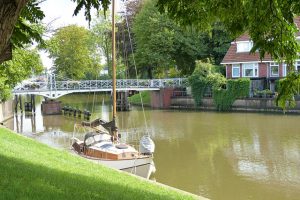
Renting Your Home To Fund Your Sailing Dreams – Is It A Good Option?

12 Space Saving Items You Need For Your Liveaboard (Or Small Space)

Is Sailing Safe?

Sailboat Living: 10 Things To Know Before Moving On Board
Sailboat living can sound like the dream life, and in many ways it is.
Beautiful sunsets, the freedom to travel with your home, dolphins and crystal clear seas are all a huge part of the sailboat lifestyle , but anyone who tells you it’s an easy life has obviously never really lived on a sailboat!

There are times when sailboat living can feel more like a nightmare than a dream, and no matter how much you prepare there will always be a few troublesome scenarios that you just can’t predict.
However, with a little forethought and a lot of planning, there is a lot you can do to make the transition of moving from a house to a sailboat a relatively easy one.
If you’re prepared to put in the hard work now then we promise you will reap the rewards in the future. As we learnt the hard way, we’ve put together the top 10 things that everyone should know before they move onto a sailboat so that sailboat living for you can be 98% dream and only 2% nightmare!
As an Amazon Associate, we earn from qualifying purchases. We also earn from other affiliate programs. This means we may receive a small commission on products purchased through our links at no extra cost to you.
#1 A Sailboat Is Never Complete
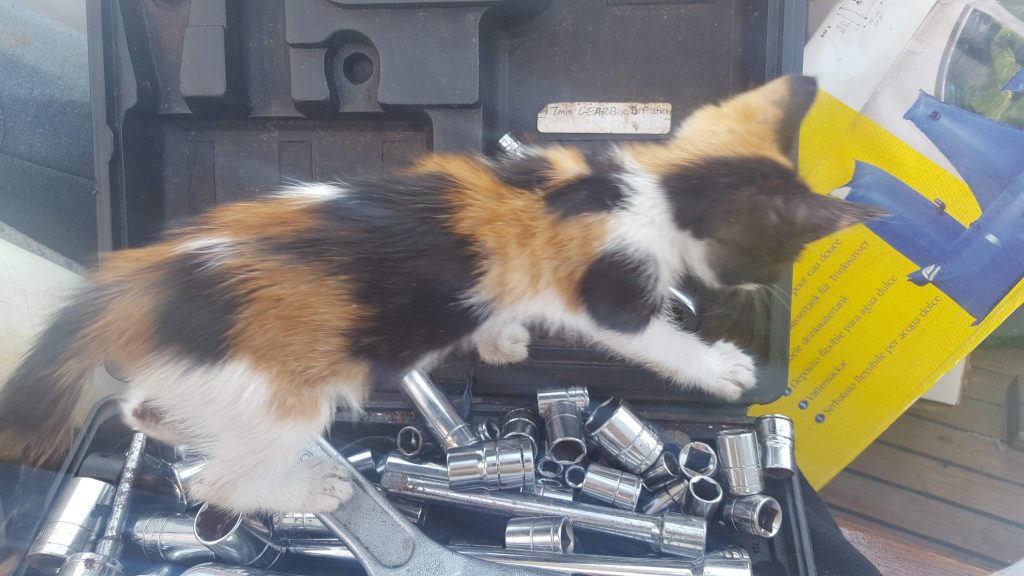
Learn this lesson fast!
Don’t expect to finish boatyard work and stop working. A sailboat breaks. Constantly. Some days it will feel as though your to-do list is endless because unfortunately, it is.
This was one of the things Adam and I were prepared for before we moved onboard our sailboat. After living on a boat in the UK we understood the crazy amount of work that has to go into maintaining something that’s constantly working.
I think a good way of looking at it would be to think of it as a house and a car combined. It has all the working parts of a house – the pipework, the electricity, the leaky windows etc.
It also has all the working parts of a car like an engine, the tires could be the sails, the lines, and all that goes along with them.
Add to that the fact that you’re putting it under huge amounts of stress at all times, in some extreme weather conditions, and you can see why things constantly fail!
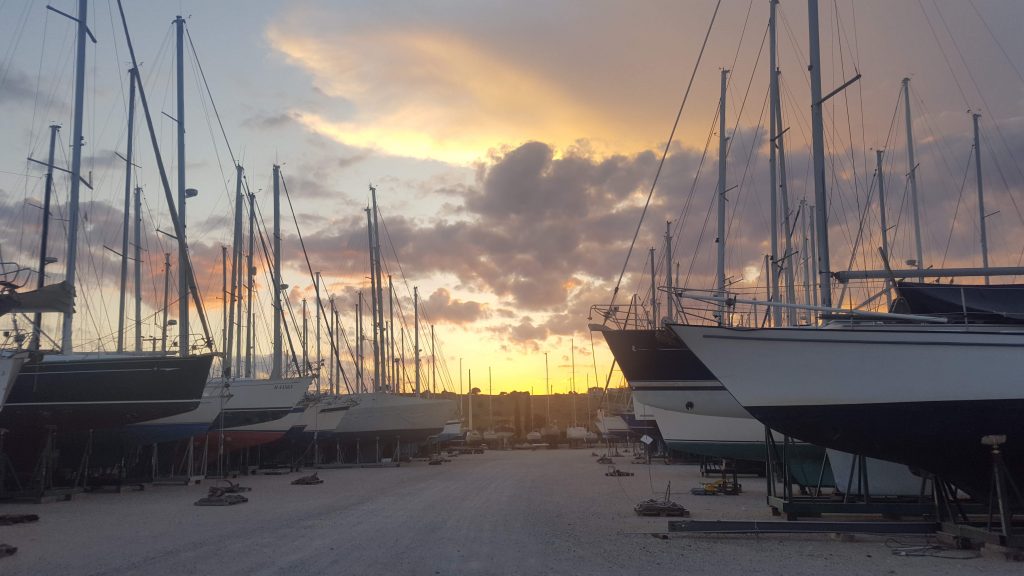
Adam and I spent the first few months of living aboard feeling as though we were just sailing from anchorage to anchorage to find chandlers so we could fix things. We made friends with some full-time cruisers who quickly put a stop to that!
They explained how if we actually wanted to enjoy time on board then we had to give ourselves time off the boat work. The broken things we could live with could wait a few days while we enjoyed a new destination.
Find out how much new sails cost
We now try to only do one or two days of boat work a week, which leaves us with a weekend ‘off’ when we’re working our jobs for three days. This suits us perfectly, but you’ll need to find a pattern that works for you to make sailboat living more enjoyable!
A bonus of living onboard is that you do have the extra time to dedicate to keeping the sailboat in tip-top condition.
Many weekend sailors find themselves with a long list of jobs at the end of the season, but (depending on how cheap/how lucky you get when you buy your boat!) if you get some jobs done every now and again through the season you’ll keep the long stints to a minimum.
#2 Sailboat Living = Tiny Space Living

Think of sailboat living as living in a glorified tent and you’ll be (partly) prepared! There is nothing glamorous about sailboat living!
You’ll be getting changed in tiny spaces where you may or may not be able to stand. You’ll be squeezing into the toilet or squeezing past people to use the kettle. It’s a juggling act, even when all your belongings are stashed away neatly.
Add to that the fact you’ll probably be ripping open cupboards every other day to find that essential item that was placed under all the other essential items and it becomes pretty hard to manage!
Our top tips for managing space onboard your sailboat are to downsize before you move in and to prioritise sailboat storage. It might be a hard thing to do to start with, but you’ll be so thankful you gave up all nonessential items before you even moved aboard.
It’s amazing how quickly you can fill a boat when you live on it! We have loads of handy tips on how to maximise limited space in our post on sailboat storage ideas – check it out before you start sailboat living!
#3 Water, Water, Everywhere But Not A Drop To Wash In

Get used to living frugally. We don’t necessarily mean your finances (though it is possible to live on a budget on a sailboat, check out what we spend monthly here).
Things like water and electricity are limited on a sailboat, especially if you’re spending the majority of your time at anchor.
Unless you have a sailboat watermaker (which we highly recommend splashing out on!) you need to get used to using as little water as possible . It’s not always easy to find when you live on the sea.
Get used to taking sea showers and washing dishes in saltwater. You can always rinse in freshwater, and washing in the sea really isn’t too hard once you’re used to it!
Set your sailboat up with a good way of making electricity as soon as you move aboard. You’ll want decent amounts of solar power and possibly a wind generator too, especially if you’re planning on spending time in countries that don’t see very much sunshine or spending winters at anchor.
You’ll also want to make sure you have a good battery bank for storing it over night, and you may even want to consider getting a small generator if you rely on power for things like charging laptops to work from.
#4 The People You Meet Will Be A True Highlight
The sailing community is what makes sailboat living. They are the most giving and generous community of people we have ever met and the best memories we have are the ones we spent with other cruisers.
It’s not always easy to meet other sailors while you’re living at anchor, so our advice is to make the effort and say hi where ever possible. People are always happy to share a drink or dinner, and a salty tale or two!
Meeting other sailors is also the very best way to learn more about sailing life. No matter how long people have cruised for they always have an experience worth sharing and learning from.
#5 The Weather Controls Your Life In Sailboat Living

We check the weather twice a day, every day. It may seem obvious that the weather is important on a sailboat, but until we moved aboard we didn’t realise quite how much it would affect our lives.
You might be desperate to move the boat and explore somewhere new but find you have no wind to sail. Or you might fall in love with an anchorage and want to stay but be forced to move because of a change in the direction of the wind.
We’ve had to leave beautiful anchorages in the middle of the night because an unpredicted storm had blown through, or been stuck in places we don’t like because the wind has meant it’s the only safe place to be.
The positives of being governed by the weather is that you’re so much more in tune with it. You get up when the sun rises, you notice subtle changes in the temperature and you learn to read the wind and clouds.

Before you move on board you should start checking the weather and anchorages around where you plan on sailing. It makes life easier if you’ve scouted out the best places to be in different weather conditions.
Check things like whether there are safe anchorages for different wind directions or whether you’ll need to use marinas (and how much they’ll be!), and check if there are any ‘bolt holes’ you can use as safe havens in the event of unexpected storms.
You’ll feel more confident and comfortable if you have all this information to hand when you start sailboat living.
#6 Sailboat Living Means Leaving Your Privacy On The Dockside
You’ll be sharing a tiny space with your crew and they will quickly learn literally everything there is to learn about you. And you them.
Before you move onto a sailboat make sure that you’re happy with sharing everything with the people you’re sailing with. I don’t mean you have to tell them about your childhood (though night passages can be pretty dull!) but be prepared to share what you eat, when you toilet, potentially what you throw up.
Expect to be walked in on while you’re changing or showering. Understand that boat toilets break – a lot – so no matter how careful you are you might well end up elbow deep in someone else’s last nights dinner!
#7 Learn To Work As A Team – Quickly

Sailboat living requires a huge amount of team work (unless you’re planning on living alone of course). You need get into a very different mindset when you live and work with the same person or people day in, day out, and when you depend on them (quite literally) to survive.
One of the biggest reasons that people quit at sailboat living is because they fall out with their partners, or call it a day before they do. Sailboat living is hard on relationships, but it can also make your relationship better and stronger if you’re prepared to work at it.
There are lots of things you can do to prepare for this change and I’ve put together a whole range of tips to help you with spending too much time with your partner .
Ultimately, one of the best things you can do is know that this isn’t going to be easy, no matter how strong your relationship is on land. Be prepared for this as a couple, and be prepared to work hard on your relationship when the tough patches come!

#8 Nature Is Incredible

I know, I know, we all know nature is incredible. But sailboat living brings you so much closer to it in so many different ways.
You see things you’d never get a chance to see on land. Every time you jump in the sea you find new sea creatures, either from snorkeling or finding them clinging on to your hull, or washed up on deck.
You see turtles, whales and rays. Birds come to find rest on your boat while you’re on long passages and dolphins swim beside you as you make waves for them to play in.

Then there’s the sunrises and sunsets, and the endless starlit skies. The thunderstorms that you’re suddenly a part of, when before you could hide inside brick walls. The constantly changing sea and sky, and the sun and wind. You become part of it, and you depend on it, and you’re terrified of it.
Sailboat living makes you feel like you’re part of the nature around you rather than just a lucky spectator. It’s certainly changed the way I see the ocean and the weather for the better and I have a new found respect and healthy fear of it’s power and awe.
#9 Prepare For Sleepless Nights

Before we set off cruising full time I had no idea how little sleep I would get. There are so many different things trying their hardest to ruin a good nights sleep on a sailboat.
Firstly, the weather. If it’s windy, you’ll be half awake all night just watching the anchor and wondering if this will be the night it pulls out and you drag into some rocks.
You’ll be waiting for the wind to shift slightly so that you’re no longer protected from the sea. And even if you’re super happy with your anchoring set up, the wind through the halyards makes a very disconcerting noise!
If the weather is calm that doesn’t mean the sea will be. You can never predict whether the anchorage you arrive in will be the rollyest place on the island, so you’ll spend a good few nights just rolling around all over the place trying your hardest to stay in your berth.

Then there’s the heat (or the cold, depending on where you sail). It can be unbearably hot inside a sailboat, so consider buying a decent hammock and sleep under the stars instead.
But if you decide to sleep outside you’re going to want a mosquito net, because those things are FIERCE. Never have I ever experienced so many sleepless nights due to a buzzing in my ears and painful bites all over my legs.
If you can find a comfortable set up with your hammock and mozzie net then sleeping outside on a sailboat is one of the most magical things ever. The stars are brighter than you could ever imagine, and there are shooting stars a plenty. The stillness of a calm night at anchor is one of the very best things about sailboat living.
If you’re sailing with a baby you can expect even less sleep – make sure you’re prepared for that!
#10 Sailboat Living Is More Difficult Than You Could Imagine (But Totally Worth It)

Difficult sounds bad, but that would be inaccurate when describing sailboat living. It’s the hardest thing I’ve ever done and the best. And part of what makes it the best is that it’s the hardest. Does that make sense?!
Sailboat living can feel like a constant battle at times. You have to trek for an hour to find the gas to light your oven to make a cup of tea in the morning. You then have to go back again because you forgot the tea bags. Things break and need fixing. You can’t sleep because of a storm. You can’t leave the boat for days because the winds up and you’re scared the anchor might pull out.
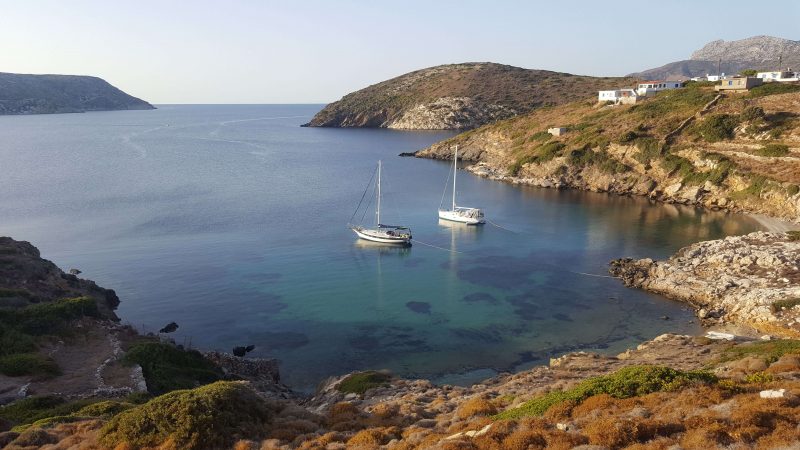
I think people run away to sea to find freedom, but like everything freedom can be defined in so many different ways.
Sailboat living takes away your freedom of easy access to food and water. It takes away your freedom to step out of your front door into relative safety. At times it even takes away your freedom to run and walk.
What it does give you is freedom from monotony. Freedom from daily routine. It gives you the freedom to travel where you want (if not when you want) and the freedom from material possessions.
It doesn’t matter what you wear on a boat, it doesn’t matter how flashy your boat is or how much you smell! At the end of the day, out on the sea, it’s just you surviving. And in a way, that’s the most free I’ve ever felt.

Similar Posts

Lateen Sails – What Are They And Why Are They Important?
Catching (and killing) a fish for the first time.

Essex Sailing: Cruising Along The River Blackwater

Top Sailing Gear Essentials 2024: The Ultimate Guide

Sailboat Provisioning: How To Provision For A Sailing Trip
The next chapter, 15 comments.
I’ll be moving on a sailboat with my girlfriend this (still very new) year and I discovered your blog via Pinterest. We’re also writing weekly blog posts about our journey. Your writing is excellent, and I’d like to follow you on your mailing list. But it seems your form does not work. Fix it maybe? 🙂
Ah that’s strange! I can see people are still signing up, will have a look into that! Thanks for letting me know. Thanks so much for reading along. Where’s your boat? I’m so excited for you – those first few weeks aboard are the best!
I can’t seem to sign up for more. The web page has an error on my Android. Bummer.
Can you please add my email address to your email distribution list?
Thanks, Steve
So glad to come across you guys, finding out as much as we can before we take that leap. We are a couple coming to the end of a army career. The last 2 years will be in Kenya Nanyuki. Posted in June. Then we plan to get the dream sailing boat and travel. I am doing all my home work trying to find out as much as I can before we do this. Looking forward to reading about you both and tasking in everything any thing that we will I’m sure be incredible useful. Thank you Sandy
Sorry for the late reply, I’ve only just noticed your lovely comment. I hope you’re getting further along with your dream – would love to hear about it! If you need more help we’ve put together a huge guidebook detailing everything we’ve learnt, from the very beginning of the journey through to buying the boat and eventually living aboard and making it all work. https://twogetlost.com/guidebook
That’s really nice post. I appreciate your skills. Thanks for sharing.
Thanks for reading!
Thanks for the honest truth in this article. Doing all the research possible before following our dreams and in your footsteps 🙌💕⛵⚓
Thanks so much for your kind comment and really pleased we could help! Keep us updated on your journey, you won’t look back!
Wow! I am on a boat reading this while my partner is away for the first time in months, and it made me feel less insane and like there are tools to help us live our dream of minimalist sailboat life.. Thank you so much for your wise words and good tools..
I’m so pleased it helped and excited for you starting this journey! You won’t regret it, and we’d love to hear more when you find the perfect boat and move aboard! If you need more help we’ve put together a huge guidebook detailing everything we’ve learnt, from the very beginning of the journey through to buying the boat and eventually living aboard and making it all work. https://twogetlost.com/guidebook
- Pingback: How To Downsize Your Wardrobe For Boatlife | Two Get Lost
Any suggested reading on preparing your land life (home, insurance, anythin really) for departure. Sell the home or rwnt, thinks like that. Want to start preparjng a year ahead and struggling to make a plan..any blogs ir reading suggestions would be appreciated!
Hello, thanks for reaching out. First off – congratulations! You’re obviously set on your plan to move aboard and it will be amazing (and lots of other things too!!) We actually cover all this in part one of our guidebook. We go through everything we had to consider before moving aboard, things like whether to sell or not to sell, what to do with all your things, even little considerations like what to tell family and friends. We’ve included tick lists for planning the change in lifestyle. You can find it here. https://twogetlost.com/guidebook Part 2 is for after you’ve bought the boat – getting the boat ready for living aboard and all the other things that come along with living at sea. I hope it helps and please do let us know how you get on – perhaps we’ll see you out here soon!
It’s helpful to understand that when living in a sailboat, the weather controls every aspect of our lives. Not long ago, my wife and I decided to invest in a sailboat because we love the sea and nature. We’d like to buy one this year, and maybe in the future, we’ll need to read carefully your advice about living in a vessel.
Leave a Reply Cancel reply
Your email address will not be published. Required fields are marked *
Cost of Living On A Sailboat (Monthly Breakdown)
The cost of living on a sailboat full-time is approximately $1,880 per month or $22,560 per year.
Please keep in mind that the cost of living on a sailboat can vary depending on your specific location, the condition of the vessel, the size of the boat and your boating experience.
The cost of living on a sailboat can be broken down into 9 monthly expenses including:
- Boat Marina Fees
- Boat Insurance Cost
- Boat Maintenance Fees
- Fuel Expenses
- Grocery Costs
- Boat Gear Costs
- Entertainment Costs
- Internet Costs
- Miscellaneous Costs
Below is a cost of living on a sailboat table summary.
1. Boat Marina Fees
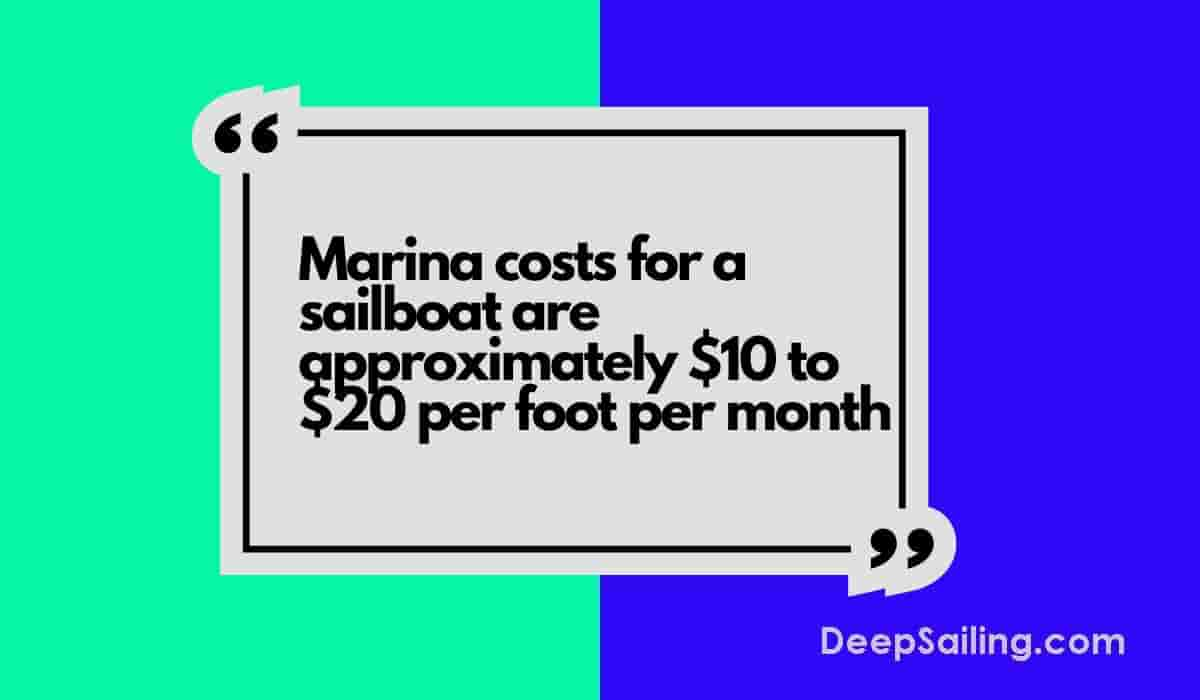
The first cost to consider when living on a sailboat is the marina fees/slip fees.
The marina costs for a sailboat are approximately $10 to $20 per foot per month.
For example, a sailboat owner with a boat size of 30 feet will typically pay between $300 and $600 per month in slip fees to stay at a marina.
A marina will charge a boat owner on a per-foot basis based on the length of the vessel.
The size of the boat and the location of the marina will have a large influence on the price charged to boat owners with marinas in Florida typically being the most expensive in America compared to other locations.
Paying marina fees gives boat owners access to boat cleaning services, electricity, internet access, pump-out services and facilities, waste removal services and a marine store.
Some boat owners prefer anchoring which is free of charge. Anchoring can be the best option during warmer months from April until November when marina facilities are needed less.
Boat marina costs can be reduced by mooring in cheaper marina locations, only using the marina when necessary or anchoring the boat off the coast away from the marina.
2. Boat Insurance Cost
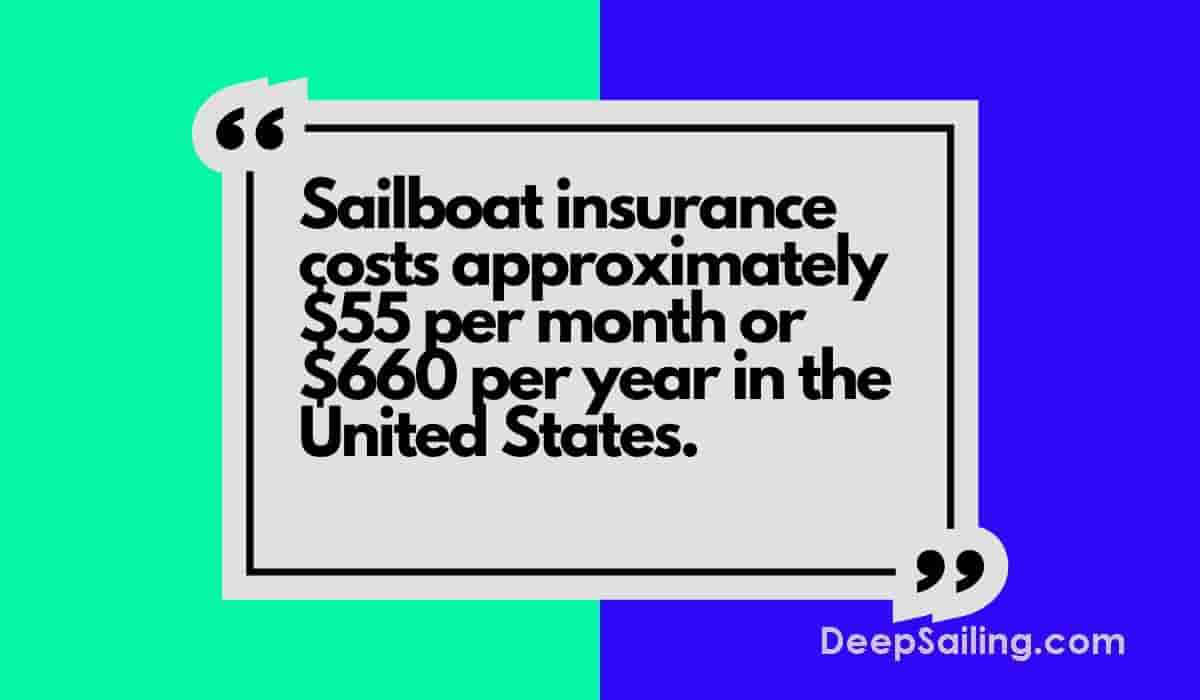
The second cost to consider when living on a sailboat is the boat insurance fee.
The cost of sailboat insurance is approximately $55 per month or $660 per year.
This is an approximate cost for the average sailboat owner living onboard their vessel in America.
According to Progressive , the annual Progressive boat insurance policy cost for the insurance policies they issued to boat owners in America ranged from $250 to $700 per year.
To get an accurate boat insurance cost for your specific sailboat, contact marine insurance providers for quotes.
The cost of boat insurance will vary based on the size, location and condition of the sailboat as well as a boat owner's experience and claims history.
Typically, the boat insurance cost will be 1% to 4% of the total retail value of your sailboat.
Boat insurance is the most expensive in locations that suffer from hurricanes like Florida and Texas.
Boat insurance costs can be reduced by browsing insurance providers, using cheaper sailboats, using the boat in lower-risk areas and increasing your boat experience.
3. Boat Maintenance Costs
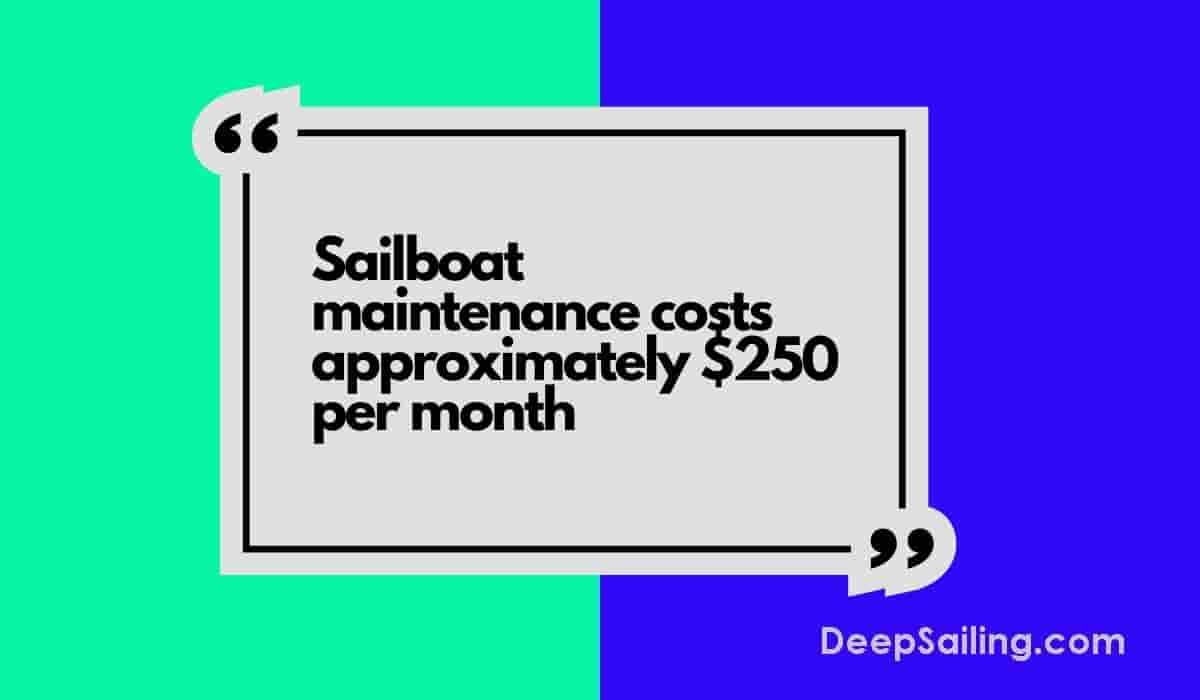
The third cost to consider when living on a sailboat is the maintenance cost.
The average cost of sailboat maintenance is $250 per month or $3,000 per year.
A sailboat's maintenance cost can vary based on the condition, size, age and location of the sailboat as well as the boat owner's experience with repairing and maintaining the boat.
Boat maintenance cost includes paying for spare parts, cleaning supplies, boat paint, engine services, repairing fridges, electronics, lines, cookers, windows, seats, toilets, deck materials etc.
Boat maintenance costs can be reduced by using second-hand parts, manually repairing the sailboat yourself and treating the boat with care.
4. Fuel Expenses
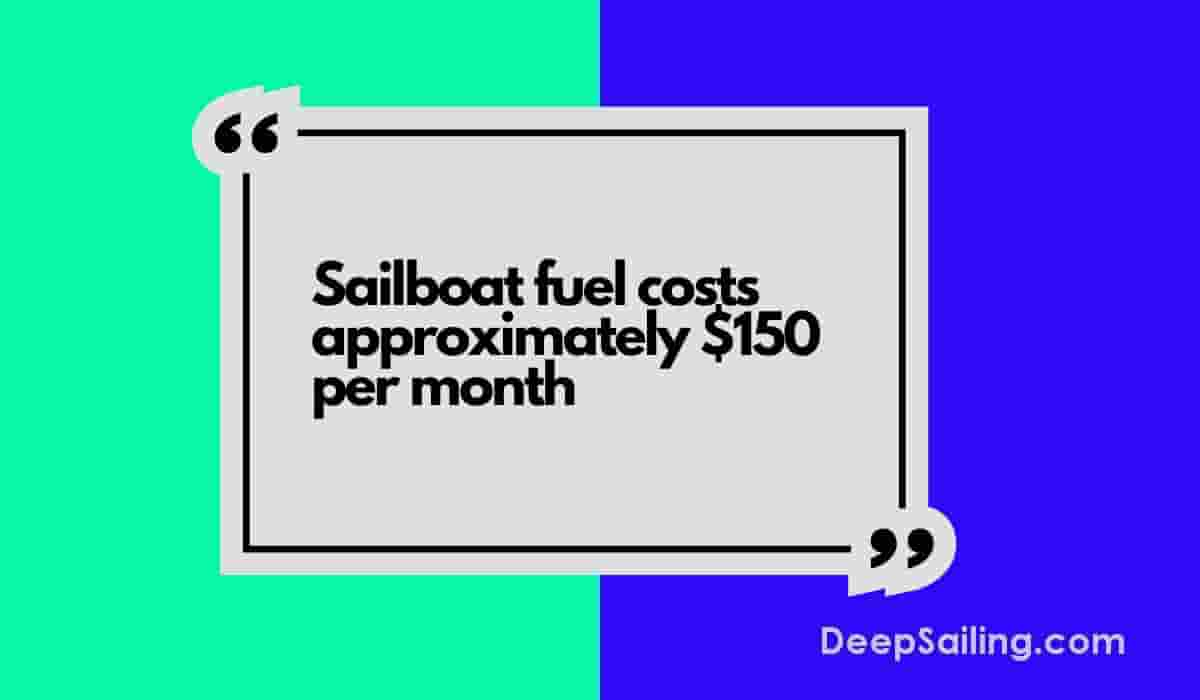
The fourth cost to consider when living on a sailboat is the fuel cost.
Sailboat fuel costs approximately $150 per month or $1,800 per year.
Sailboat fuel costs include paying for diesel or gas for the boat engine and buying propane fuel for sailboat heating and cooking while living onboard.
The factors that affect the sailboat fuel costs are the location, weather, size and condition of the boat as well as the frequency of use.
In the winter, sailboat fuel costs tend to rise whereas they are cheaper in the months from April until September.
To reduce the fuel costs of a sailboat, use the sails more often rather than the boat motor. Sailboat fuel costs can also be reduced by only traveling when it is the optimal time for the current which can make a large difference in fuel efficiency.
5. Grocery Costs
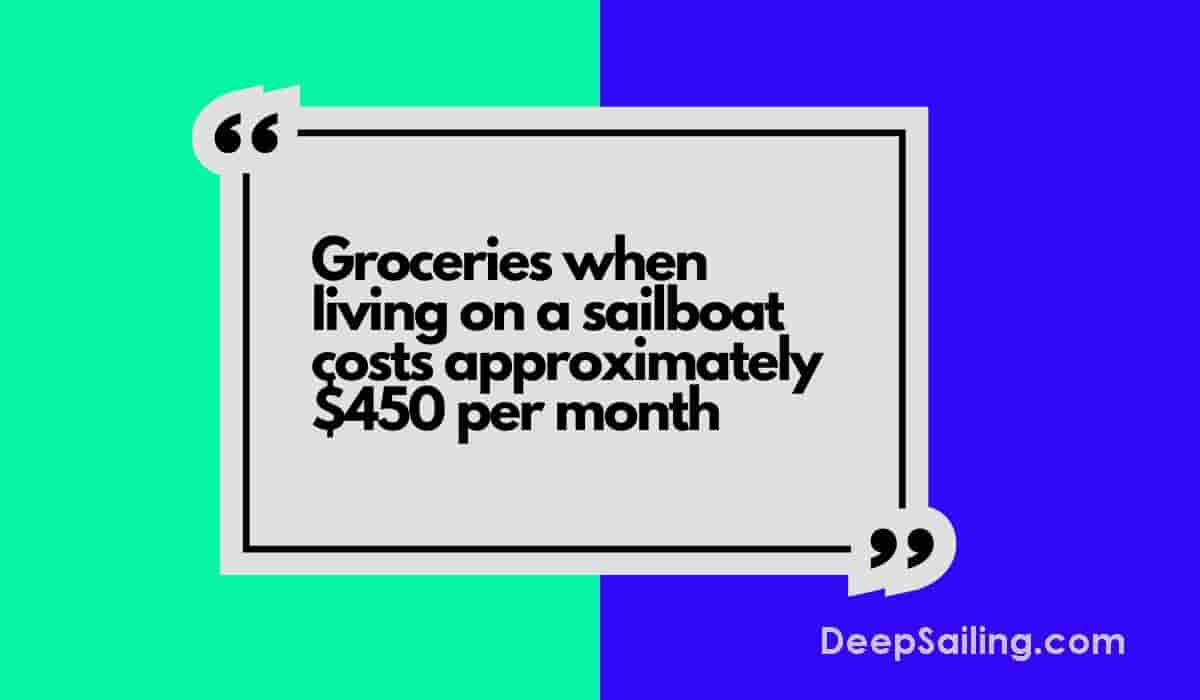
The fifth cost to consider when living on a sailboat is the groceries cost.
The cost of groceries when living on a sailboat is approximately $450 per month or $5,400 per year.
Grocery costs include paying for food, drinks, bathing supplies and kitchen cleaning supplies.
The grocery costs remain the same year-round. To reduce the grocery costs when living onboard a sailboat, boat owners can choose to catch fish by fishing from their boat. However, this will only cause a small reduction.
A saltwater-to-freshwater converter can be used to get a fresh supply of drinkable water without having to spend money on buying drinks. This will only cause a small reduction in costs too.
6. Boating Gear Costs
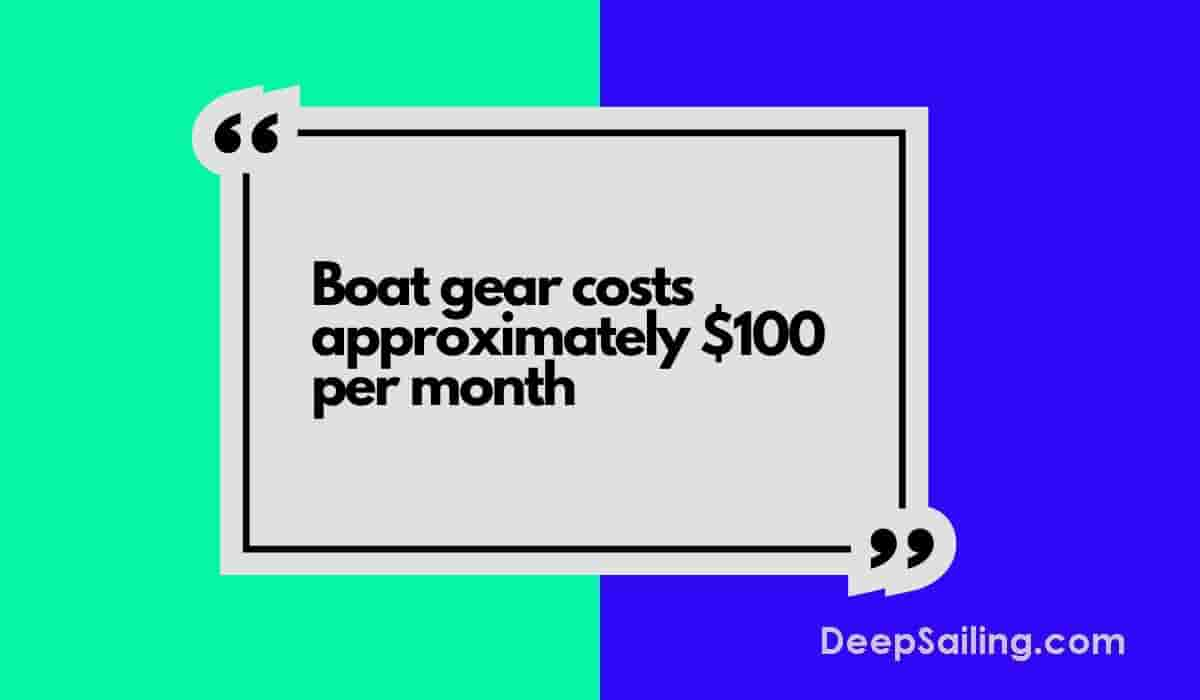
The sixth cost to consider when living onboard a sailboat is boating gear costs.
The approximate cost of boating gear when living on a sailboat is $100 per month or $1,200 per year.
Boating gear costs include paying for gear like sailing sunglasses, sailing jackets, swim gear, fishing gear, sunscreen, wetsuits, sailing hats, fire blankets, and general boating accessories.
The boating gear cost is the most expensive in the winter months when extra sailing clothing is needed to keep warm.
To reduce the cost of boating gear, take good care of your current boat gear to ensure it lasts longer and purchase high-quality boating accessories that will last for a long time.
7. Entertainment Cost
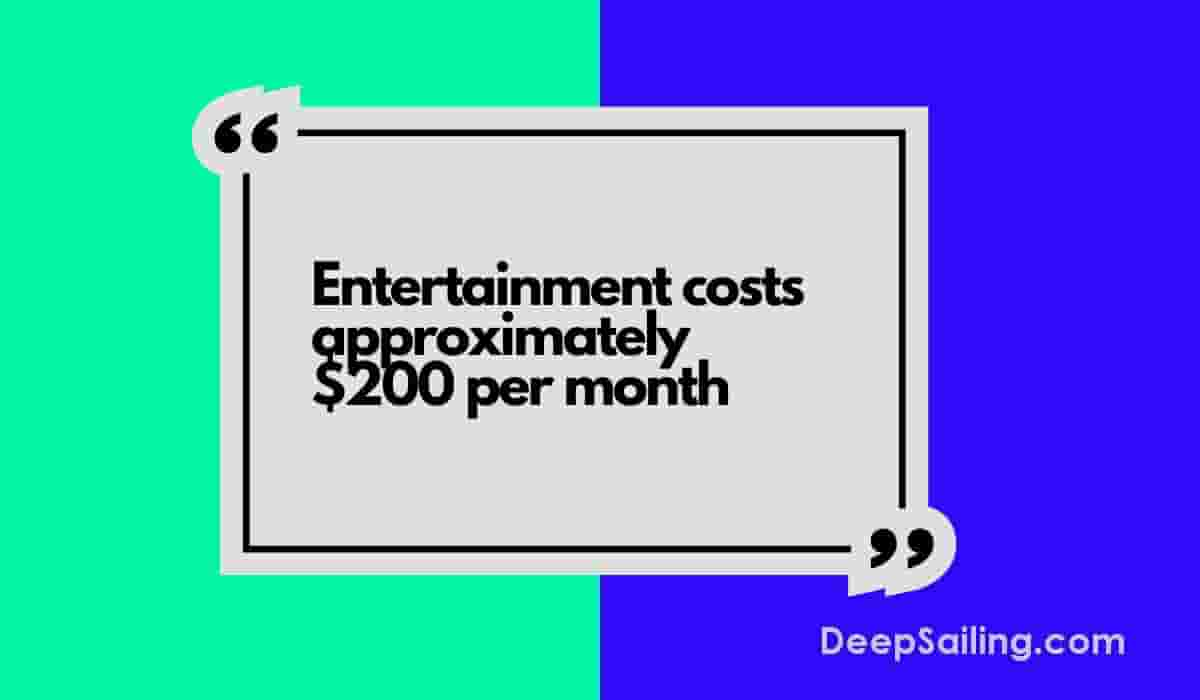
The seventh cost to consider when living onboard a sailboat is the entertainment cost.
The cost of entertainment when living on a sailboat is approximately $200 per month or $2,400 per year.
Entertainment costs include paying for tv subscriptions, board games, dining out, trips to the cinema, etc.
The entertainment costs will not change throughout the year.
To reduce entertainment costs, find free entertaining activities to do rather than spend money for entertainment.
8. Internet Costs

The eighth cost to consider when living on a sailboat is internet costs.
The cost of the internet when living on a sailboat is approximately $100 per month or $1,200 per year.
Internet costs include paying for a 4G/5G connection or satellite internet connection. It includes paying for a wi-fi router to connect to the sailboat too.
To reduce the internet cost on a sailboat, anchor the boat at marinas with a Wi-Fi connection included in the slip fees.
9. Miscellaneous Costs
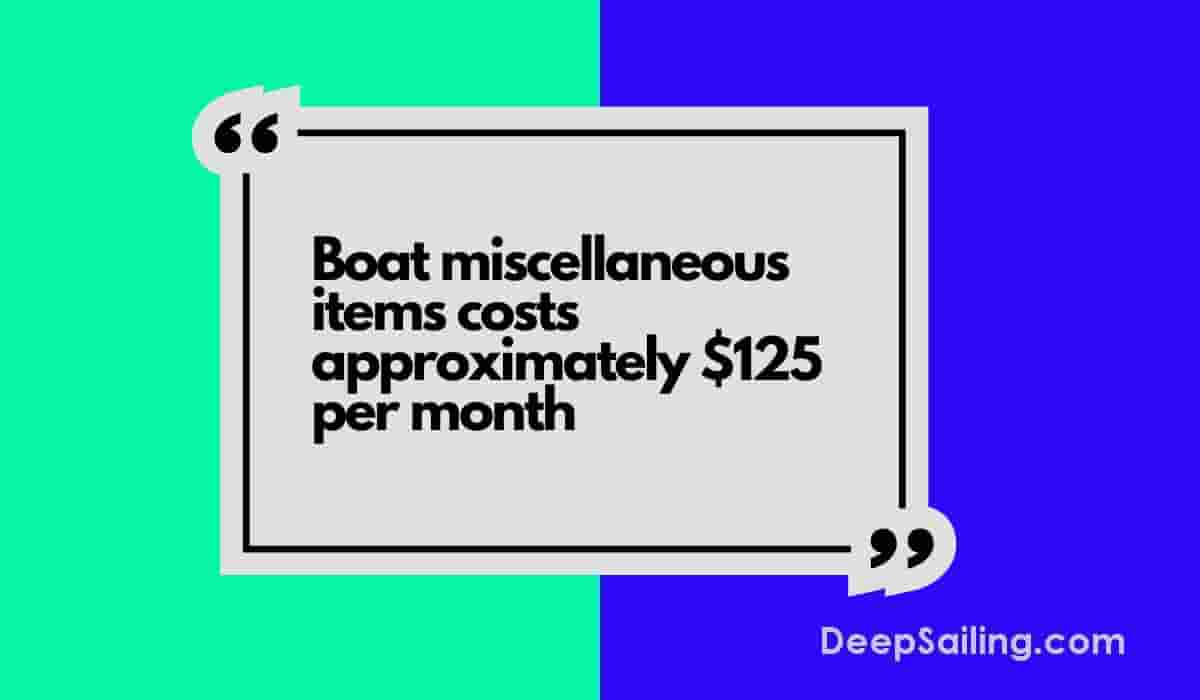
The ninth cost to consider when living on a sailboat is the miscellaneous costs.
The miscellaneous costs when living on a sailboat are approximately $125 per month or $1,500 per year.
Miscellaneous costs will typically remain the same throughout the year without much change.
Miscellaneous costs include costs associated with buying items like boat rugs, personal care items, boat care basics, coolers, boating decor, cooking utensils etc.
To reduce the miscellaneous costs, reduce the number of general boating items purchased and ensure the items that are purchased are of good quality so they last longer.
Frequently Asked Questions About The Cost Of Living On A Sailboat
Below are the most commonly asked questions about the cost of living on a sailboat.
How Much Does A Large Sailboat (Over 50ft) Cost To Live On?
The approximate cost to live on a large sailboat (over 50ft.) full-time is $3,200 per month or $38,400 per year.
What Is The Most Expensive Cost Associated With Living On A Sailboat?
The most expensive cost associated with living on a sailboat is the marina slip fees which are a monthly cost of $10 to $20 per foot of boat size.
How Can The Cost Of Living On A Sailboat Be Reduced?
The cost of living on a sailboat can be reduced by using the sails instead of boat fuel to power the boat when traveling, mooring the sailing vessel in a cheaper marina or anchoring outside a marina, browsing for cheaper marine insurance policies, ensuring care when using the vessel to keep repair costs low, downsizing to a smaller sailboat and keeping entertainment costs to a minimum by finding cheaper or free entertainment alternatives.

My Cruiser Life Magazine
Living on a Sailboat – Cruiserlife Reality, Pros & Cons Of Boat Life In 2023
What could be more romantic or inspiring than living on a sailboat? Maybe you dream of traveling and “sailing off into the sunset.” Or maybe you dig the sailing lifestyle and are looking to join a community of like-minded people. For some, it has been a lifelong dream. Or perhaps you’ve landed here because you’re out of options, and life on a sailboat sounds cheaper than land-based obligations and a good way to save money.
Table of Contents
The dream of sailboat life, can you live aboard any boat, sail or power.
- Price Range
Monohull or Catamaran
Dock life or off the grid, living spaces, five reasons boat life is awesome, five reasons why a liveaboard boat can be a bummer, before you do, try life on a sailboat first, sailboat life faqs.

The truth is, many reasons bring people to move onto a sailboat—or any kind of boat. If you’re unfamiliar with boat life, think of boats as floating RVs or campers. They attract all sorts of people, from wealthy travelers to people making ends meet. And just like with RVs, they range from palatial yachts to cramped, dingy things you can’t get away from fast enough.
Buying a sailboat to live on has grown in popularity in recent years and has boomed during the coronavirus era. While the global pandemic certainly slowed world travel, it has pushed more people to work from where ever they like. With unlimited data cell phone plans, you can take your boat nearly anywhere and still be connected with the world.
The first question to ask is, “What sort of boat do you want to live on?” Boats come in every shape and size to suit every boater. As a result, the choices can be overwhelming when you first consider the lifestyle.
All boats represent compromises. The vessel designer made compromises to fit all the things in the boat that they could. There are compromises in performance in favor of more creature comforts, or vice versa.
Likewise, you’ll make compromises when you purchase a boat. You may find that the vessel of your dreams is out of your budget, so you compromise with a smaller boat or one lacking some features. You may opt for a stout bluewater boat built for ocean crossings. If that’s the case, you will invariably compromise on some liveaboard comforts that cheaper coastal cruisers might offer.
What the boat needs to have for you to liveaboard is entirely up to you. Is your idea of the liveaboard lifestyle all about downsizing and living simply? Or is living aboard a means to an ends—a way to slowly travel the world comfortably while taking “home” with you? Do you live for the passion of actual sailing, or is sailing just a cheap way to move from place to place?
In other words, before you go boat shopping, you must narrow down your goals for the vessel. Next, we’ll look at some of the features that will make how to live on a sailboat easier, but remember that nothing is mandatory.
Buying a Sailboat to Live On
If you’re wondering whether or not sailboat life is right for you, start by thinking about what the perfect setup would be like. Chances are you have some preconceived notions of what living on a sailboat is like. And chances are there are ways that it could be like that, but there are also ways that it could be completely different.
Before you dive too deep into the lifestyle, don’t pigeonhole yourself into looking at only sailboats. There are tons of powerboats that you can get for similar prices as used sailboats. And motorboats have a few advantages over sailboats, especially for living aboard.
The most common types of powerboats you’ll see people living on are trawlers or cabin cruisers. First, the design of these boats means that their hull shape is better able to accommodate living space. They’ve got wide sterns and bigger interiors. They also usually have large windows and a nice view out of the living area, something most sailboats lack.
The only thing that a powerboat can’t do is sail (obviously), and most people don’t cross oceans in them. But most people who buy sailboats to do those things never actually do them! So again, it all comes back to being honest with yourself about what you want to do with your boat. If you’re after comfortable living space and the ability to travel anywhere along the coast, a trawler should be high on your list.
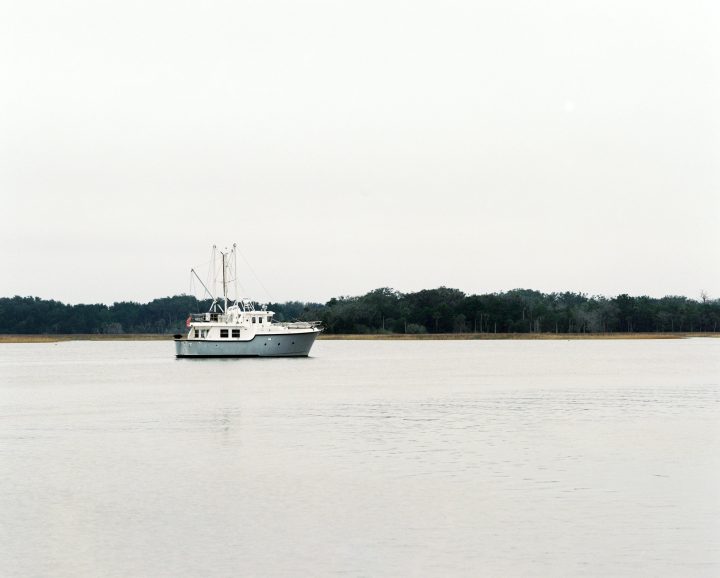
Price Range
You can’t go boat shopping (or even dreaming!) without at least some idea of your budget. You can spend anywhere from $1,000 to well over $10 million buying a sailboat. You have to narrow it down a bit!
Here are a few pointers to guide you. If you browse for a boat on Yachtworld , you can get a pretty good idea of a particular make and model’s nominal value.
These are brokered boats, so the list prices seldom equal the sale price. But it provides a good way to analyze the market. Some will be priced very high because they are newer, have newer upgraded engines, are better maintained, or are otherwise “better.” By eliminating those, you should be able to estimate the average value of a particular make and model.
You may find listings that look like bargains because they are priced lower. Chances are, these are project boats. Project boats require “elbow grease” or “DIY skills” to restore. A project boat is always a losing proposition because it will usually take many more dollars to get it ship-shape than it would cost to have just bought the kept up boat to begin with.
Here’s an example. Say you’re shopping for one of the best liveaboard sailboats , like a Catalina 30, and the average price is around $18,000. Then, one day while browsing Craigslist, you see one listed for $5,000. A bargain, right? Well, it should be no surprise that the $5,000 boat “needs a little work.” But what you might not realize is that it probably needs $20,000 or more worth of work (and even that number is if you plan on putting in your own elbow grease).
The moral of this story is pretty simple—plan on paying the average price for a sailboat. Of course, there might be some bargains out there. But generally, if you want a functional, livable boat, it will cost you some cash.
Catamarans are popular choices for liveaboard boaters, especially if you plan on anchoring or traveling a lot. These boats have expansive living spaces that feel much less crowded and claustrophobic than typical boats. Even sail cats ofter raised salons with wrap-around windows and lots of fresh air flowing through.
On the flip side, it can be challenging and expensive to find a dock or repair facility in some parts of the world when you need one. So if you plan to live at a dock on a catamaran, start your search by finding the dock first. Catamarans are too wide to fit in regular slips, so marinas must put them on the limited number of bulkhead or t-head docks they have.
Catamarans are expensive, and it’s generally not good to stretch your budget when buying a boat. If you do, you’ll have less money in the back to travel or spend on upgrades and repairs. So if the catamaran lifestyle appeals to you, double-check your numbers to ensure you can afford to do it right.
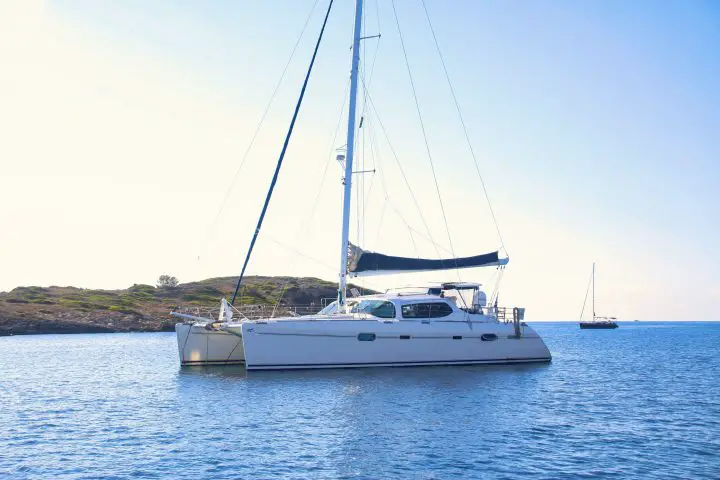
Being a liveaboard boater does not mean you must spend your life tied to a dock. You could travel regularly from your marina home base. Or you could travel and not have a home base. It all depends on how you organize your life and your obligations.
If you intend to live as off-the-grid as possible, that should be considered when you go boat shopping. Some boats are easy to set up that way, and others are not.
If you spend a lot of time away from docks, you must come up with a plan to get some necessities. Some things are easy, and others are more difficult. You’ll have to answer questions about how you will get electrical power, fresh water, pump outs, fuel, and groceries.

Electrical Power
At a dock, you can plug in with a large extension cord and enjoy unlimited power just like you would in a home. Since all the power arrives through the one big cord, there might be some inconveniences, like you cannot blow dry your hair, make microwave popcorn, and brew coffee all at once. But generally, you’ll have outlets that work and plenty of power to run air conditioners, heaters, cooking appliances, and whatever else.
Away from the dock and unplugged is another thing entirely. Some boats have generators that will run 24/7 to maintain the same comforts. But generators drink diesel fuel and are noisy and smelly. Most sailors who live off the grid prefer to use solar panels and a large bank of batteries to power what they need. In all but extreme cases, however, this means that some power-intensive conveniences like air conditioning and heaters are not viable options.
Fresh Water
Docks will supply city or well water for use onboard. In some cases, you plug in a hose for unlimited supply, but on most boats, you simply fill up the water tanks whenever you need to.
Away from the dock, you’ll have to rely on the tanks alone. When they get low, you’ll need to visit a dock to refill them. Any marina will let you fill up, but most boaters combine it with a trip for fuel or a pump out.
Some boaters catch rainwater and put it in their water tanks. Others carry jerry cans of water from shore in their dinghy. And on ocean-going boats, you can install water-making systems that desalinate seawater and make it potable.
If water goes in the boat, it must come out, right? It is illegal to dump your toilets overboard in most parts of the world unless you are far offshore. So boats are equipped with a holding tank—the boat equivalent of the RV black water tank.
To empty the tank, you visit a pump out station. This is simply a pump that takes the tank contents and puts them in the local sewage treatment system. It is far more ecologically responsible than dumping it.
The size of your holding tank is a significant limiting factor on most liveaboard vessels. On average, a 20-gallon tank will last a couple about one week of full-time living aboard. So plan on a weekly trip to the pump out dock. You can just use the marina’s facilities as often as possible if you live at a dock. That will extend your time between pump outs considerably.
Some places have pump out boats that will come to you. This is common in busy mooring fields or anchorages like those found in Florida. Some are provided by marinas, and others are done by local cities or counties. Interested in liveaboard marinas in Florida , visit our guide!
Living aboard doesn’t burn any engine fuel. And it’s usually easy to find gas or diesel fuel docks when traveling.
But you’ll also occasionally need cooking fuel, usually propane. You may also need fuel for your heaters during winter. Boat heaters work on diesel, propane, or solid fuels.
Finally, you’ll need a plan for groceries. For example, if you live at a dock at a marina, you might keep a car there and live like you would if you had an apartment.
If you don’t have a car or are traveling, you will start looking for grocery stores near marinas. Walking distance becomes important, as do marina loaners cars or Uber.
You can make a lot of upgrades and modifications to make the boat you choose, but it’s not possible to fundamentally change the boat’s characteristics. If you’re thinking about living on a boat full time, you need to consider the living spaces and whether or not you and your family can comfortably live there.
Salon, Cockpit, and Staterooms
You’ll spend most of your time in the larger spaces, like the cockpit and salon. The cockpit is like the outdoor patio, and the salon is like your living room and dining room combined. Do these areas have enough space for everyone to lounge comfortably? What about regular everyday things like reading a book or watching the tv?
Designers make boats comfortable and safe while boating, but it’s only recently that they’ve emphasized the livability aspect of their designs. As a result, many sailboats have small cockpits that are safe at sea but cramped for day-to-day life. Likewise, settees and lounges might not be engineered for comfort so much as use in rough seas.
A common complaint that people have about boat life is the shape of the beds. Staterooms on small boats usually have v-berths, vee-shaped cushions in the bow. These can be very difficult to get in and out of, especially for couples. They nearly always involve getting trapped inside and having to climb over your partner to get out. Island berths, which stand in the center of the stateroom and can be accessed on either side, are a great upgrade.
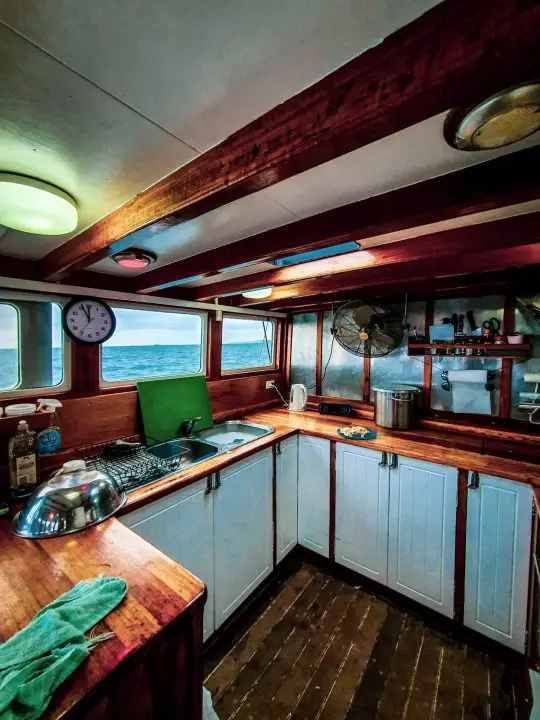
Galley and Head
And then there are the functional parts of the boat like the kitchen and bath (or the galley and head in boating terms). Kitchens will be much smaller than even efficiency apartments. Expect a simple gas range and small oven at the most. Some boats will have a microwave, but not all. Refrigerators are small, and on sailboats, they are often awkward top-loaders. The biggest problem you’ll find with most boat galleys is a lack of counter space and storage.
The head is another place to analyze what living aboard would be like. Smaller boats have “wet heads.” That means that if you want to have a shower, you’ll sit on the toilet, and everything will get wet. The opposite of a wet head is a separate shower stall, which is a great upgrade if you are living aboard full time.
Pros and Cons of Life on a Sailboat
So now you’ve got some ideas about what makes up life on a sailboat—or at least a look at the variety and sorts of boats that you can liveaboard. What would make you want to take the plunge, and what would give you pause? Here are a few pros and cons to the liveaboard lifestyle.
Living on a sailboat provides an amount of freedom that people with houses can never know. Don’t like your neighbor? Change slips or move to a new marina. Sick of this town? You and your house can be in another state in a few days.
Not being tied down means you can organize your life to travel more. For example, if you aren’t tied to a local job, you could spend summers staying cool in New England and winters in Florida or The Bahamas. Or if you’re entirely untied, head off into the sunset for the Caribbean or an around the world cruise.
2. More Time On the Water
It only follows that you must like the water if you’re looking at boat life. Many people feel a special connection to nature from being near the sea, be it at the beach or on a boat. Boats provide you with endless million-dollar waterfront views that can change as much as you want to travel. You’ll enjoy your morning coffee with a whole new crowd—pelicans, dolphins, sea turtles, and manatees may be in your backyard every morning.

3. Romantic, Slow Paced Travel
Even if you don’t cruise, there is a romantic connection to travel in every boat. Arriving in a new town by boat is unlike any other travel experience. Every town looks like the same strip malls and chain stores by car. But by boat, you can see towns like an explorer, viewing each historic waterfront and finding all the best dive bars and cruiser hangouts.
With the right sailboat, you can travel nearly anywhere in the world. Some people dream of completing a circumnavigation, while others stick to seasonal cruising. Whatever your goal, sailboats might not be the fastest way to travel, but they are certainly the most romantic.
4. Small Space Simple Living
On the one hand, boats and RVs are the mobile equivalents of the tiny house. If the idea of downsizing your possessions and valuing experiences more than material goods appeals to you, living in the small space of a liveaboard boat might be right for you.
It might seem counterintuitive because boats are pretty complex and expensive items. But downsizing is a relative thing, and no matter how fancy the boat is, chances are the people living on it downsized their lives to get there. Boats themselves are complex, but they also prevent you from being burdened by many non-essentials.
5. Sailing Community
Finally, the sailing and boating community is full of interesting and fun people. Everywhere you go, you’ll meet boaters that come from a wide range of backgrounds who have similar interests to your own. The community is supportive and known for fun get-togethers over cocktails or pot-lucks.
1. Difficult to Find Liveaboard Marinas
If your goal is to live on a boat and stay in one place, you might find it’s hard to get a marina or anchorage that suits you. Marinas are businesses, and each one is operated to suit a particular crowd. Some welcome liveaboards while others do not. Sometimes it’s the marina policy, and other times it has to do with local city or state regulations.
However, if you are traveling on your boat as a cruiser, you have little to worry about. Travelers and voyagers are always welcome, and transient slips at marinas for up to three months are usually readily available.
2. Small Spaces
Wait, wasn’t “small living” a pro of living on a boat? It was, but it can suck too. Cramped spaces, storage limits, and small living get old and frustrating after a while. No matter how hard you try, you’ll wind up collecting too much stuff that you have no room to store. Downsizing is a process, not a one-time event when you live on a boat.
And then, there are the problems that stem from sharing a small space with your partner or family. Boats offer very little in terms of private space. Even if you get off the boat everyday and travel, living together so closely for any length of time will test any relationship to the breaking point.
3. Constant Maintenance Costs and Fixing Things
Boats are constantly breaking. They float in an acidic solution 24/7, are subject to constant motion and vibration, and are full of explosive substances and toxic chemicals. Sometimes it seems like they are willfully trying to self-destruct and take you to the bottom of the ocean.
Of particular note regarding crew morale are those ever-constant maintenance issues related to the toilet plumbing. Marine heads stink—but literally (sometimes at least) and figuratively in their design and function.
Engine problems are also a big concern, primarily for their expense. A new engine can easily cost more than you paid for the entire boat!
Repairs on boats slow down after the first year of ownership once you handle everything the vessel needs. But by then, your time will be full of preventative maintenance tasks to keep it all working well. As the saying goes, an ounce of prevention is worth a pound of cure.
4. It’s Really Very Slow
If you’re buying a boat to travel, you might be shocked at how little traveling you can get done. Boats travel at the whim of the weather, which often means sitting in port and waiting for better conditions. There’s a lot more sitting and waiting than actually sailing. If you’re coming from the land-based road world, this is a stark contrast to hopping in your car and driving off whenever you feel like it.
Even when you do travel, moving between five and seven miles per hour is slow. What can be done in one day in a car now takes you three to four 24-hour days of constant travel.
5. Sometimes, It’s the Worst
Maybe that’s mellow dramatic, but experienced sailors will understand the sentiment. But sometimes, it just seems like the weather or entire ocean is trying to kill you.
Then, there’s the constant inconvenience of it. Just getting a cold beer out of the fridge might involve clearing the countertop, opening the lid, taking out two top shelves, and leaning down at the very bottom to find the last bottle. Then, there are marina wifi problems, seasickness in rolly anchorages, and boat parts lost in the mail or stuck in customs.
Like many choices you make in life, living on a sailboat is not about the boat or the place. It’s all about your attitude. Is it an adventure or a nuisance? Of course, everyone experiences inconveniences once in a while, no matter where they live. But boats make everything seem more dramatic, causing you to doubt your choices at the first signs of discomfort.

It’s hard to describe both the pleasure and the dispair that living on a boat can provide. It’s been said that for every low-low, like a back-flowing toilet, there are high-highs, like the perfect sunset with dolphins dancing just for you.
From my observations, most people who move aboard give it up after their second or third year. Unfortunately, many don’t make it past year one, which is always the hardest due to the steep learning curve.
The best advice is to try sailboat life before you buy into it. Charter a boat or take some sailing lessons. Find friends with boats who will take you out and share their stories with you. Do research, go to boat shows, and try it out in any way you can before taking the plunge. And no matter what you do, remember to enjoy and savor the adventure!
Is living on a sailboat worth it?
I think so, and many others do too. But living on a sailboat is not for everyone. Boats range from luxurious yachts to cramped, floating tents. No matter what size boat you choose to live on, there will be times when you doubt that it’s worth it.
All boats are cramped and uncomfortable at times. Life revolves around the weather, the boat, and staying safe. Sometimes it means getting out of bed at 2 am to move the boat in a storm, and sometimes it means not joining your friends at the beach party because something broke and you need to fix it.
It’s impossible to answer whether or not living on a sailboat is worth it to you—only you can make that call. This is because sailboats offer not only a way to travel but a way to completely change your life.
Can you legally live on a boat?
Yes, you absolutely can live on a boat. But depending on where you want to live, it can be challenging to find marinas or anchorages that will allow you to. There is nothing inherently illegal about living aboard a boat, but liveaboards are frowned on by many dockmasters and local governments. However, you can find liveaboard marinas, and many have lovely, welcoming communities of people who love their vessels, the water, and the sailing lifestyle.
Matt has been boating around Florida for over 25 years in everything from small powerboats to large cruising catamarans. He currently lives aboard a 38-foot Cabo Rico sailboat with his wife Lucy and adventure dog Chelsea. Together, they cruise between winters in The Bahamas and summers in the Chesapeake Bay.

15 Best Liveaboard Marinas in North Carolina

Last Updated by
Daniel Wade
June 15, 2022
Whether you're retired, downsizing, or just giving it a try, a liveaboard marina offers a unique boat living experience. There are several liveaboard marinas in North Carolina. All you have to do is choose the best and you'll have an incredible experience.
From the bountiful fishing meccas to the enthralling stops along the Atlantic Intracoastal Waterway, North Carolina offers more than 5,000 miles of waters for boaters to enjoy. This expansive area is home to some of the best liveaboard marinas that choosing the best can be a real challenge. But if you need more than an anchor line and a mooring ball, it would only be appropriate to go for one of the best liveaboard marinas in North Carolina.
Liveaboard marinas generally offer amenities that can range from the bare necessities of a normal dock such as a bathhouse to more luxurious amenities that are akin to those found in five-star resorts. For this reason, it's always advisable to figure out exactly what you want in a liveaboard marina. This means that you should know what you can't live without and, of course, what you can do without. Just like normal living arrangements, liveaboard marinas come equipped either with very few amenities or as many amenities as possible.
In this article, we'll highlight some of the best liveaboard marinas in North Carolina and what makes them the best.
Table of contents
Town Creek Marina
Located in Beaufort, Town Creek Marina is the only full-service marina in North Carolina. Featuring premier amenities and state-of-the-art floating docks, Town Creek is home to world-class fishing and offers one of the best coastal waters such as the historic Beaufort's quaint downtown area and the infamous Pirate Blackbeard.
Located east of the new Gallants Channel 65' on Beaufort's Highway 70, this amazing marina is the gateway to Beaufort both by land and sea. This marina has world-class restaurants, loads of maritime history, and first-class boutiques - all a short walking distance from the marina. This is a family-owned and operated marina that has everything to make your liveaboard days memorable. This marina employs friendly, knowledgeable, and professional staff who will readily assist you with all your boating needs.
This is, without a doubt, one of the most beautiful spots in Beaufort, especially if you want to watch anglers bring home the day's catch or catch the sunset. More importantly, Town Creek's Hurricane Storage Program will give you the peace of mind knowing that you and your boat are in a safe place even in the most adverse weather storm.
Cape Fear Marina
The Cape Fear Marina is located just a few minutes from downtown Wilmington, which is known for its numerous attractions. Its upriver location is one of the best in Southeast North Carolina. This marina is restricted to recreational and residential use, so you'll be away from the maddening noise that's some sort of a norm in marinas that allow tour boats, charter fishing boats, and scuba dive boats.
This marina may be near an amazing city but it has some rural flavor to it. The marina's salt marshes attract egrets, herons, and cormorants, which makes it a marvelous place. This marina prioritizes liveaboard boaters and gives you the chance to spend your day at Wrightsville Beach, enjoy guided river cruise, experience fine dining, explore eclectic shops and enjoy the ultimate liveaboard experience in a tranquil setting.
This is a great marina if you enjoy friendly company in a natural and uncomplicated setting. Some of the amenities to enjoy include Wi-Fi, social area, Dog Park, discounted rental cars, laundry facility, a hurricane hole for your safety, and many more.
Southport Marina
*** No longer allows liveaboard status
After extensive renovations and upgrades in 2006, the Southport Marina remains one of the biggest and amenity-laden marinas in North Carolina. This is a must-see destination if you're planning to cruise the East Coast Waterways. This marina puts you within a walking distance of downtown Southport, North Carolina, as well as within a day's travel to Myrtle Beach, South Carolina, and Wrightsville Beach, North Carolina.
This marina has over 200 in-water protected slips with deep water access, fuel dock, and a floating dock house. Its dry-storage facility is hurricane certified to withstand 140 mph winds while the marina's travel lift is capable of handling boats weighing up to 55 tons. We're talking of a Marina that was awarded the Marina of the Year award in 2013 thanks to its world-class services and amenities.
So whether you are headed south to Florida or want to sample the best of Wrightsville Beach, the Southport Marina is a first-class that can offer a safe and convenient spot to rest, enjoy local cuisine, get entertained, and refuel.
Northwest Creek Marina
Located 6 miles downriver from the historic New Bern, NC, and about 18 miles up the Neuse River from the ICW, this marina is conveniently located to offer easy access to the Neuse. This extraordinary marina is situated within the Fairfield Harbor community, which makes it a safe and secure spot to moor.
This marina is not only one of the cleanest in North Carolina but also provides a long list of amazing amenities. Its air-conditioned facility offers clean bathrooms, showers, laundry room, library/TV room, Wi-Fi, sauna, Jacuzzi, fitness center, indoor and outdoor pools, a miniature golf course, and ample parking. In essence, this marina offers a pleasant and comfortable environment for you, your friends, and your loved ones.
The Northwest Creek Marina is located in a well-protected marina basin with 274 slips and can hold boats measuring up to 60 feet.
Cypress Cove Marina
Ask any random boater and they'll tell that boaters love marinas that offer safe and easy access to inland waterways. This is exactly what Cypress Cove Marina offers. Located in Columbia, NC, this marina is world-famous for its safe and easy dockage on the Scuppernong River, as well as easy access to inland waterways such as the ICW and Albemarle Sound.
This incredible marina has 55 wet slips with a capacity of 25-ton travel lift. It also offers amazing services such as repairs to all parts of your boat, fiberglass repairs, bottom painting, and hull polishing. If you've been looking for a nice place to explore beyond the sleepy town of Columbia and its historic past, docking at the Cypress Cove Marina is the only way to go.
Mackey's Marina
Located off the south shore of the Albemarle Sound on the deep Kendrick Creek, the Mackeys Marina offers long and short term liveaboard, as well as a variety of boat services such as dockage, travel lift, and casual dining.
This is a marina that has everything to ensure that you enjoy your liveaboard escapades, as well as a great day out on the water. It's a quiet and deep water marina that can accommodate boats measuring up to 45 feet. If you've been looking for a great place to catch the world-famous Albemarle crabs, the Striped Bass, catfish, and much more, this full-service marina can be your liveaboard haven if you've been looking for a peaceful creek to call home.
River Forest Marina
For more than 7 decades, the River Forest Marina has been a superb refuge for cruisers of both large and small vessels. It's situated along the gorgeous Belhaven coastline and is more than a simple place to dock along your charted course.
Having been restored to its prime, the River Forest Marina is a fantastic liveaboard marina that you'll want to visit again and again. It provides a safe and protected harbor on the Pantego Creek, which is convenient waterway access to the greater Pamlico Sound and the Pungo River.
The main highlight of this marina is its renovated piers that offer close to 375 feet of dockage for vessels measuring up to 150 feet. Some of the world-class amenities available at this marina include 30/50/100 amp shore power, travel lift, diesel fuel, and "ValvTect" non-ethanol gasoline, mobile mechanic, electric golf carts, and spacious air-conditioned restrooms, showers, and many more.
Homer Smith's Docks and Marina
Offering dockage for vessels measuring up to 150 feet, Homer Smith's Docks and Marina is a state-of-the-art marina in Beaufort. This is a luxurious waterfront where you'll feel right at home thanks to the several amenities on offer, friendly staff, security, and great comfort away from home.
This marina offers a superb space not just to unwind but also to explore and discover the beauty of downtown Beaufort, as well as the rest of the amazing Crystal Coast. Needless to say, Beaufort is the third oldest town in North Carolina, and Homer Smith's Docks and Marina allows you to immerse in the history and action of this historic town.
You'll enjoy over 85 wet slips and boat lifts, 16 transient slips, a world-class clubhouse facility, and unfettered boat services that will make you come back again and again.
Blackwell Point Marina
Nestled along the banks of Smith Creek that branches off the Neuse River, Blackwell Point Marina is a picturesque little marina that's part of a private community in Oriental, North Carolina. This is a safe and highly-protected marina that offers several amenities onsite, as well as being near several restaurants, shops, bars, and boutiques.
To make your liveaboard experience even much better, the Blackwell Point Marina has clean showering houses, bike rentals, ample parking, a picnic area, a health and fitness club, Wi-Fi, and many more. That's not all; this marina offers an incredible dining experience in a quaint area overlooking the water edge. If you've been looking for a marina that will allow you to indulge in a perfect liveaboard and relaxing vacation, Blackwell Point Marina is what you've been looking for.
The Pelican Marina
For over 40 years, the Pelican Marina has been proudly serving boaters on the Camden Causeway. It's located in Elizabeth City on the Pasquotank River and is an amazing stop for those cruising down the Atlantic ICW.
Whether you're looking for short, long, or transient wet slips, the Pelican Marina has all the amenities that make it an excellent liveaboard marina. Additionally, this marina has a full-service marine supply store with all the boating knick-knacks that you may need for your boating escapades.
You'll have access to incredible amenities, private restrooms, shower facilities, a laundry area, a snack shop, Wi-Fi, and security for your peace of mind. This is an excellent marina if you're looking for a great place to take a quick break from your cruising adventures.
Teach's Lair Marina
Teach's Lair Marina is an idyllic liveaboard destination, especially for your angling adventures. This is a full-service marina in south Hatteras Village, which is widely known as a world-class one-stop fishing village.
This marina offers both inshore and sound fishing day and night and offers perfect dockage for a variety of boat sizes. The friendly staff at this marina will be there 24/7 to offer several services during and after your catch such as cleaning and preparing your boat. From tackle, to fishing gear, and more, Teach's Lair Marina has everything you need for your fishing and boating adventures. If you've been looking for a liveaboard marina that gives you the perfect opportunity to catch some proper fish or see everyone's catch, Teach's Lair Marina is the place to be.
Seapath Marina and Yacht Club
Located in Wrightsville Beach in southeastern North Carolina, Seapath Marina is a premier transient stop that provides world-class floating docks including 190 slips and nearly 600 feet of face dock. This marina is strategically at the ICW and the all-weather inlet of Masonboro.
Seapath Marina is a no-wake zone that provides sufficient safety and protection. Additionally, the slips are designed with water, power, and wireless internet, as well as many liveaboard amenities. This is a very beautiful marina that has friendly staff and will certainly become one of your favorite stops whenever you're cruising the East Coast waterways.
Wilmington Marine Center
Having increased the number of wet slips from 90 to 120, the Wilmington Marine Center is situated in an enclosed basin off the Cape Fear River and is a superb place for boaters looking for comfort and do not want to worry about currents throughout their stay. This marina offers the convenience of a 10-minute drive to the charming and historic downtown Wilmington.
In addition to the utmost security and privacy, this marina has one of the best storm and surge protections in North Carolina. That's not all; this marina is famous for its high-quality floating docks, friendly staff, affordable rates, and wonderful sunset. This is a great place if you're looking for minor cosmetic repairs or full boat restoration. Make sure that you don't miss out on an incredible shopping experience; you'll find some of the best souvenirs to snag before you head back to the marina.
Windward Point Marina
A small and quiet facility in Pamlico County, NC, the Windward Point Marina is a few minutes away from some of the most popular sailing grounds in North Carolina such as the Neuse River, the Pamlico Sound, Oriental, and the ICW. The entrance to this marina is on the Broad Creek on the junction of the Pamlico Sound and the Neuse River.
The best feature of this marina is its quietness. It's a perfect marina if you're tired of busy, overcrowded, and noisy marinas. Its remote and wooded location not only gives you surprisingly quick access to several sailing destinations but is also a few minutes away from nearby towns of Bayboro and Oriental. As the name suggests, Windward Point is intimate, quiet, and far removed from the normal hassles of a busy marina. Whether you're sailing solo, with friends, or family, Windward Point Marina is a quiet and beautiful marina that's unquestionably a sailor's dream.
Dowry Creek Marina
A family-owned and operated marina, the Dowry Creek Marina is an incredible place to reconnect with nature in a picturesque and peaceful surrounding just a short distance north of Belhaven. This marina is conveniently located below the transition from the Pungo River and adjacent to ICW. It offers over 70 deep water slips and can fit a wide range of boats measuring 20 to 120 feet.
It offers protected deep-water slips with 30/50/100 amps services available. The fact that Dowry Creek Marina isn't located in a typical town dock or commercial port gives boaters the chance to experience a perfect liveaboard in a quiet and secluded area of pristine marshland and away from the noise and traffic of downtown Belhaven. The main aim of this marina is to provide liveaboard boaters with the chance to enjoy a home away from home experience.
With more than 360,000 boaters using North Carolina's waterways each year, the importance of marinas in North Carolina can never be downplayed. Countless liveaboard marinas in North Carolina offer a wide range of services to boaters. However, just because these marinas allow boaters to spend the night there doesn't mean they are the best. In other words, just don't fall in love with a particular marina in North Carolina only to find that it doesn't suit your preferences.
That being said, the above-described marinas are among the best liveaboard marinas in North Carolina. They offer some of the best marina amenities, safety, and incredible opportunities to make your liveaboard adventures more memorable.
As always, safe travels and fair winds!
Related Articles
I've personally had thousands of questions about sailing and sailboats over the years. As I learn and experience sailing, and the community, I share the answers that work and make sense to me, here on Life of Sailing.
by this author
Destinations

Most Recent

What Does "Sailing By The Lee" Mean?
October 3, 2023

The Best Sailing Schools And Programs: Reviews & Ratings
September 26, 2023
Important Legal Info
Lifeofsailing.com is a participant in the Amazon Services LLC Associates Program, an affiliate advertising program designed to provide a means for sites to earn advertising fees by advertising and linking to Amazon. This site also participates in other affiliate programs and is compensated for referring traffic and business to these companies.
Similar Posts

How To Choose The Right Sailing Instructor
August 16, 2023

Best Sailing Destinations In BC
June 28, 2023

Best Sailing Charter Destinations
June 27, 2023
Popular Posts

Best Liveaboard Catamaran Sailboats
December 28, 2023

Can a Novice Sail Around the World?
Elizabeth O'Malley

4 Best Electric Outboard Motors

How Long Did It Take The Vikings To Sail To England?

10 Best Sailboat Brands (And Why)
December 20, 2023

7 Best Places To Liveaboard A Sailboat
Get the best sailing content.
Top Rated Posts
Lifeofsailing.com is a participant in the Amazon Services LLC Associates Program, an affiliate advertising program designed to provide a means for sites to earn advertising fees by advertising and linking to Amazon. This site also participates in other affiliate programs and is compensated for referring traffic and business to these companies. (866) 342-SAIL
© 2024 Life of Sailing Email: [email protected] Address: 11816 Inwood Rd #3024 Dallas, TX 75244 Disclaimer Privacy Policy
Living on a Boat Full Time: Ultimate Guide for Liveaboards

The fun, the sun, the family time, and the unmatched satisfaction of steering and operating a boat -- don’t you just wish it never had to end? Well, that wish has become an astounding reality for a lot of boat owners who tossed the lines and decided to become full time boaters. That’s right: the community of liveaboards is ever growing.
If you just can’t get enough of boating and it pains you to tether your trusty vessel to the dock at the end of the day, then maybe it’s high time you joined in on the bandwagon. Seriously contemplating living on a boat? Here’s everything you need to know.
Factors to Consider When Living on a Boat
Although you might already be romanticizing the idea of living on a boat, there are some serious considerations you have to make before you take that jump. Even some of the most experienced boaters will step away from the liveaboard life because of certain factors that just don’t work for their comfort, convenience, or preference.
Here are a few things you should consider before you make that big change:
Are You Prepared for Minimalist Living?
One of the biggest changes you’ll probably have to adjust to involves storage. Most liveaboard boats won’t have enough space onboard for lots of storage space, you’re going to have to live with bare minimum. That also entails frequent trips to the grocery store since you won’t have enough room to stock up for long periods of time.
Do You Know How to Perform Basic Repairs?
You’re going to encounter many different damages onboard especially during certain seasons. It helps to have some level of skill and knowledge when it comes to basic repairs so you won’t have to call a professional every time, especially when you’re too far away to find anyone to help.
What's the Weather Like?
Your local climate is going to play a role in how convenient (or how uncomfortable) your boat living situation is going to be. It’s usually not recommended for people who live in rainy regions, or those that experience severe winters to live permanently on a boat.
Is Your Family Prepared?
If you’ve got kids, then this is going to be a major change. Consider their daily route to school, and whether they’ll adjust to the new environment with comfort and ease. If you’ve got smaller kids that still like to run and play, there might not be enough room on deck to accommodate their rambunctious behavior.
Are You Willing to Give up Certain Appliances?
Washing machines, dryers, and elaborate home entertainment systems will not have a place on board most boats. Whether you’ve got a generator or a solar energy system, you probably won’t be able to supply enough power to sustain the entire range of household appliances you enjoy at home.
Where is Your Water Going to Come From?
Clean water for bathing and drinking can be tough to source when you’re living on a boat. Some boat owners install a system that lets them distill or purify water from the lake so they can safely use it for drinking and cleaning.
What About Waste Management?
You can’t just toss the contents of your portable toilet overboard. See to it that you know where your local waste management and disposal system is so you can access it whenever you need to safely and legally clean out your toilet. That also goes for whatever garbage you might accumulate on board.
Pros and Cons of Living on a Boat
Truth be told, liveaboard life isn’t for everyone. While it can be exciting and freeing, it also comes with its fair share of drawbacks that might be a little too inconvenient for those who are more comfortable and accustomed to living in a standard house.
- Opportunity to travel whenever you feel like it
- Usually more cost-effective than living in a standard house
- Forces you into an eco-friendly lifestyle
- Calmer lifestyle in touch with nature
- Deep sense of community
- Lots of time and money spent on maintenance
- Limited living space
- Susceptible to bad weather conditions
- Bugs and pests abound
- Compromised security and safety
Essentials for Living on a Boat
Because you might be used to living in a traditional house, converting to life on a boat can be a bit of a challenge. To make sure you’re ready for the undertaking, see to it that you have these basics taken care of:
Personal Items
You might have closets full of clothes, accessories, personal items, and just stuff you keep around but haven’t touched in years. Well, with the kind of limited storage space on a boat, you’re going to have to purge your closets of anything that isn’t essential.
Strip your closet down to just everyday wear, casual clothes, and maybe one or two formal outfits. You should try to do the same for your shoe closet. As for seasonal items like winter clothing, you can store them at a friend or relative’s house. If you have a locker at work, keep work clothes there.
Some liveaboards go as far as renting out a storage unit to keep all of the items they want to keep but might not be immediately necessary on board. Of course, you could also try to beef up your onboard storage by installing extra cabinets, but it’s probably not going to be enough.
Power Source
While your range of appliances might be particularly limited, that doesn’t mean you can’t have any onboard. Television sets, electric fans, mini refrigerators, and electric grills can find a rightful place on a boat - given there’s enough power to use them.
There are various services these days that offer to equip your vessel with solar energy for clean, easy power you can store up yourself. But of course, solar power can only take you so far when the stormy weather starts to settle in.
Shore power might be your best bet if you’re looking to fire up more energy-intensive appliances. See to it that your local marina will let you hook up to their power source while you’re docked. Of course, this also entails paying an extra fee.
Finally, you can try traditional fuel power with a generator. Keep in mind though that power generators tend to be noisy, which may disrupt your neighbors. There’s also the issue of cost and eco-friendliness which aren’t typical of a gas powered generator.
Maintenance Essentials
There’s going to be a whole lot of maintenance going on. Unlike a regular house, a boat is more exposed to the elements, which means it may be more susceptible to damage. That’s especially true if you won’t have the chance to dry dock your boat, leaving its hull soaked in water for extended periods of time.
Another thing to keep in mind are repairs. To some extent, you should know some basic electrical, plumbing, and mechanical skills to readily respond to minor damages as they occur. You’re also going to have to buy some reliable tools and cleaners that should always be within reach in case you need to fix something on your own.
Food Management
You can’t expect a boat to have a full-sized kitchen. And that also means you’re going to have to learn how to manage with a limited cooking space and amenities. For instance, you’re probably not going to be able to roast a full turkey for Thanksgiving .
Most of your liveaboard menu is probably going to consist of recipes that mainly entail the use of a grill. Fried and boiled entrees can also be a practical choice. That said, you’re also going to have to prepare sufficient surface area where you can prepare your ingredients, especially if you like coming up with elaborate dishes.
And then of course there’s the choice of food items in particular. If you’ve got a mini fridge on board, then you should be able to store a few veggies and meat for about a week max. Other than that though, most of your storage will be ice boxes that can only keep things cool for a certain period, unless you’re willing to replace ice cubes on the daily.
The Cost of Living on a Boat
Although the idea of living on a boat might be freeing, it’s anything but free. There are a ton of costs associated with the liveaboard life, which means you might spend just about as much as you would living in a traditional residence.
Here’s a breakdown of what you might expect to pay when you live on a boat:
Boat Mortgage
Roughly $500 for a $60,000 boat at 8.34% interest for 20 years.
Registration
This varies from state to state, ranging between $25 to $250 annually.
Boat Insurance
Insurance is in the range of $200 to $500 a year, depending on the extent of coverage, the kind and quality of boat, and its intended use.
Property Tax
6-10%, depending on the state you’re in.
Maintenance
According to experts, you should expect to pay 10% of your boat’s cost in maintenance fees each year. A $60,000 boat could cost you around $600 yearly to keep in shape.
Premier marinas can charge as much as $240 per foot per year. There are cheaper options though that can cost as little as $12 per foot per year, but that also means downgraded facilities.
Most boats will use 3-8 gallons per hour at cruising speeds, with gas costing between $3-4 per gallon. Also consider the cost of a power generator if you plan to use one.
Marinas and mooring points will charge for garbage removal, electricity, and water. Some also offer cable TV and WiFi connectivity that you can access for an added fee.
All of that of course, goes on top of the cost of food, clothes, and other personal essentials that you might require. It’s also worth mentioning that if you’ve got a bigger, more expensive boat, you also end up paying more than the estimates above. If you’re taking your family along with you, that becomes an added expense.
Other potential costs include storage fees if you’re planning to rent out a storage unit, winterization expenses, upgrades and accessories , and personal maintenance including laundry fees.
Safety and Security Considerations
Living on a boat isn’t any more or less safe than living in a traditional residence, it’s just that your concerns might be different. Understanding the potential dangers can help you better prepare for them and minimize the risk of accidents, injuries, and damages on board.
Sure, your boat might be parked just fine in a slip . But what about your car? Parking slots for cars in marinas aren’t usually secure, leaving your precious vehicle exposed to the elements and potential break-ins.
Consider beefing up your auto insurance to keep your car safe from these threats. You might also want to consider parking where there’s a CCTV system in place just for added safety.
Fire and Fumes
The limited space on a boat can make it extra prone to fires . You also have to think about gas leaks that could combust, or that could endanger your health with fumes.
Of course, the obvious solution would be to install smoke and CO2 sensors to tell you when there might be a potential threat. It’s also important to perform routine checks to ensure that everything is working fine.
Thefts and Burglaries
Houseboats are just as likely to experience robberies and break-ins as any traditional residence. And because the last thing you’d want is to have someone take anything from your already limited possessions, it’s important to take the necessary steps to protect your liveaboard.
Choose a marina with good security, well-lit premises, and CCTV systems installed. You can also install your own CCTV cameras as well as alarm systems to tell you of the presence of an intruder.
Emergencies and Accidents
Who are you going to call in case you run into a major accident that requires prompt mechanical service or medical care? While your family and friends might be a phone call away, it’s always better to know people at your local area who you can call for help.
See to it that you get contact information for your marina neighbors, the coast guard, and marina personnel. Have them at the ready in case you need to make a quick call during an emergency.
Social Life When Living on a Boat
The thing about the liveaboard life is that it’s way more social than the typical suburban household setting. For starters, your neighbors are going to be much closer to you than when you live in a traditional house. That’s also why people who live on their boats in marinas tend to enjoy a deep sense of community.
Living on a boat means helping those around you, and getting their help in return whether for small or significant things. If you’re not ready for that kind of social interaction and you prefer something a little more secluded, you can try tying your boat to an end corner where you’ll have fewer neighbors.
Some localities will also let you tie your boat to a mooring point where you’re not likely to have a lot of neighbors at all. Otherwise, be prepared to live closely alongside other liveaboards who might tether their boat next to yours.
What About Pets?
Of course, living on a boat doesn’t mean you can’t take old Fido with you. Although you might have to acclimate your dog or cat to the boat first, lots of boat owners have successfully transitioned to liveaboard life with their furbaby in tow.
As long as there’s a safe place for them to stay, and you give them enough time to run, play, and stay active onboard or on the shore, then it shouldn’t be a problem.
Best Places to Live on a Boat
While you might be accustomed to your locality already, there’s no reason you can’t move around once you start your liveaboard journey. That said, you might also want to consider whether you’d want to stay in a place that’s known for its liveaboard friendliness. Some of the best places to live aboard a boat include:
Chesapeake Bay, Maryland
Its warm climate and friendly boaters make it a wonderfully calm place to live. They’ve also got some of the best premier marinas in the state.
Lake of the Ozarks, Wisconsin
Beautiful, picturesque, and incredibly close to nature, the Lake of the Ozarks also has a number of prime locations and points of interest that you can access only via boat which says a lot about how boat friendly they are.
Corpus Christi, Texas
They’ve got great food and a wonderful ambiance that can be great for boaters looking for the perfect marriage between luxury and nature. Their marinas are also mostly new and polished, but since they’ve only recently been developed as a boating spot, prices aren’t too exorbitant just yet.
Is Boating for You?
It can be loads of fun to live on a boat. But again, it isn’t for everyone. There are some major adjustments that need to be made if you’re going to successfully transition to life on a boat. So how do you know if it’s not for you?
- Prefer living somewhere with lots of space
- You rely heavily on appliances, gadgets, electronic devices, and high speed internet
- Have a large family with lots of kids that all need their own personal space
- You’re not too handy and you have a hard time with doing repairs on your own
- Have a job that requires most of your daylight hours, leaving you with little time for maintenance and cleaning
- You enjoy a more private lifestyle where people won’t always be around to hear or see what you’re up to
Time for a Change
Living on a boat can be loads of fun, but it’s going to require some major changes. So are you ready to dive in head first? See to it that you’ve got all the basics down, and maybe try it yourself for a week to see how you fair. Of course, it’s going to be rocky at the start. But with proper execution, you should be able to transition to that liveaboard lifestyle in no time.
Related Posts

What is a Pontoon Boat Underpinning Kit?

How Should You Pass A Fishing Boat? [The Proper Way]

Which Class of Boats Has Priority When Using River Locks?
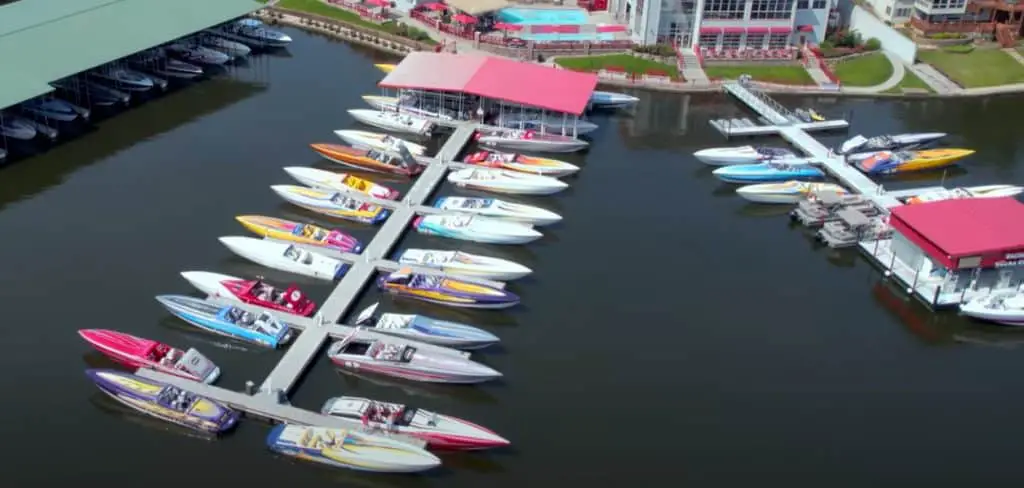
What is a Cigarette Boat? (And Why is it Called That?)

Better Sailing
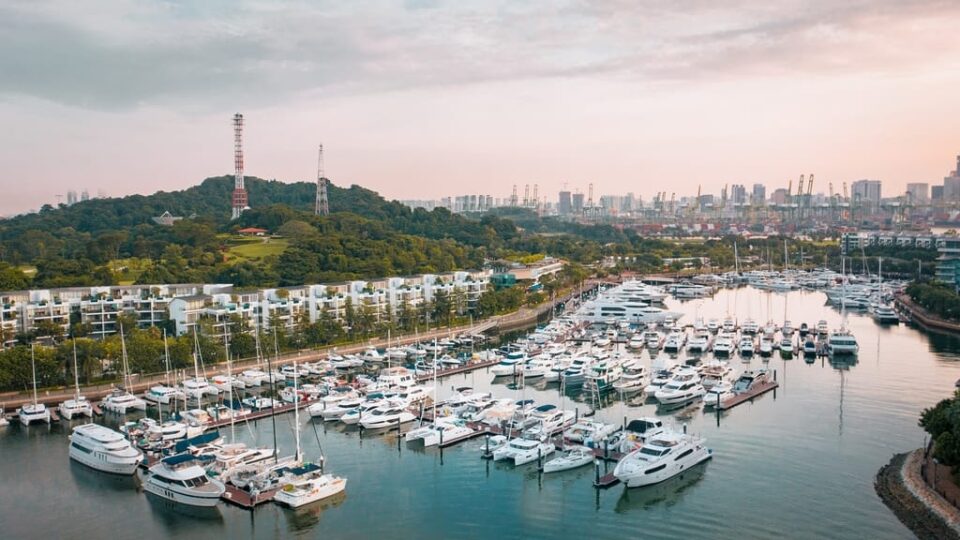
Living on a Boat in Florida – Best Liveaboard Marinas, Costs and Tips
Many people would consider switching their land-based life for living aboard if they could wake up to the sound of waves lapping against the boat and seagulls fluttering overhead. The liveaboard life appeals to many people, sailors or not. Thousands of people have already abandoned the hustle and bustle of the city and chose the liveaboard life. If you’re already a Florida resident, you’re probably a big fan of the weather, sea, and boats. You may have contemplated relocating to a boat because you are charmed with the idea of spending all of your time on the water.
In Florida, you can live aboard a boat, but you must follow certain laws and regulations. While it may appear to be a straightforward change of life, there are a variety of restrictions that apply to living aboard a boat. In this article, you’ll learn about living aboard a boat in Florida, the rules that govern this lifestyle, and any obstacles you might experience. So, keep reading!
Information about Living Aboard in Florida
Florida is a wonderful place to call home. There’s so much to do, so much to see, and so many job options. Florida has a reputation for being a strange state, but it is just that: a reputation. In fact, Florida is a very safe state with rigorous rules and a high level of transparency. Florida is an open book, so if that appeals to you, that may be enough of a reason to relocate there. Consider this if you’re looking for a job as well.
Keep in mind that there is no income tax in Florida. If you earn $50,000 a year, you could lose anywhere from $5,000 to $15,000 in taxes each year. Getting a job there is like getting a raise right away. This is also something to keep in mind when calculating your marina slip budget. You’ll have a lot more disposable income, so you might be surprised at how much more you’ll have to spend on a high-end marina slip in a prime location.
Florida, or any other coastal area, appears to be an ideal spot for mooring your boat and living aboard. While this is a distinct possibility, there are numerous restrictions in place to safeguard both coastal marinas and boat owners. It’s crucial to keep in mind that not all boats are suitable for living on. The term “liveaboard vessel” refers to boats that are used to live on. When a boat is referred to as a liveaboard boat, it simply means that the owner chooses to make the vessel his permanent dwelling. Making your boat your home can be simple enough, but there are a few things to consider before making the step.
The decision to live on a boat is a major lifestyle change that should not be taken lightly. When you decide to live aboard a boat, you must first decide how long you want to stay. Some people choose to live aboard a boat only during the summer, while others wish to do so all year. If you live on the boat all year, you’ll probably have to give up your permanent house on the land. Because the boating lifestyle does not lend itself well to owning a lot of material goods, you will be giving up much of your possessions. Alternatively, you can store them when you give up your permanent house.
When you decide to make your boat your permanent home, you must consider how you will receive mail and other important items. Remember that a floating home usually lacks a physical address or mailbox. In addition, before you decide to leave up to your land life in favor of the open water, you should research the legal implications of your decision. While living aboard your boat may not appear to be a problem, there are laws that must be followed or you may be fined. Also, while living aboard a boat may seem like a dream come true, you must consider safety concerns before making your decision.
In terms of keeping trespassers at bay and withstand harsh weather, a boat is not as secure as a house. To protect your safety while living on a boat, make sure you have a plan in place to ensure you can deal with severe weather. This will not only protect you, but it will also most likely safeguard your boat, which is now your home.
>>Also Read: All You Need to Know About The Liveaboard Life
Best Liveaboard Marinas in Florida
Liveaboard marinas can be wonderful communities full of nice people. However, finding one that is appropriate for you and your needs requires some searching. Note that liveaboards are not permitted in all marinas. It’s sometimes due to their government authorization prohibiting permanent residents from boarding boats in the marina. This is becoming an increasingly common occurrence across the United States. If you still have a job that requires you to go to an office or factory every day, you’ll need to find a location close to your workplace. On the other hand, if you are actually retired and have the freedom to live wherever you want, your marina options may be more limited.
If you prefer peace and quiet, you should look for a marina in a quiet location. On the other hand, if you prefer parties and a vibrant boating community there are many marinas in Florida that can offer this. Keep in mind that some marinas can be extremely safe to live in. Look for facilities that include security gates at each pier and a nighttime watchman. If you choose to use your boat’s head and shower, the size, and quality of the marina restrooms won’t be that important. However, if you want to keep your holding tank empty and have endless hot water in your showers, look for a marina with a restroom.
Unless you have a very large boat, a marina with a clean, modern laundromat with working machines is what you should look for. Moreover, modern pedestals and finger piers are also options in some Florida marinas. These will include electricity, water, and cable television. You can also enter your boat from the side with a finger pier. If you don’t have one, you’ll have to clamber aboard the bow or stern, depending on which is closest to the main dock. You can consider a lockbox affixed to the dock adjacent to the pedestal a pleasant extra if the marina provides one.

>>Also Read: Living on a Boat in Texas: What you Need to Know
List of the Best Liveaboard Marinas in Florida
Finding the perfect marina for you will be determined by a number of factors. These are the duration of your liveaboard life, the length and type of boat, the location, and your needs. The location is crucial, just as it is when purchasing a home. Note that the marinas are organized by location first, then by quality. The better the marina, the higher it appears on the list. Of course, it is up to you to choose which marina is ideal for you. For example, if your job is in Miami or if you want a job there, then you should find a marina in Miami.
Keep in mind that it’s much easier to find something in South Florida than it is in the north. When it comes to the north, you’ll quickly find that your alternatives are very limited. In North Central Florida, for example, the Sea Hag Marina in Steinhatchee is the only marina in the region. The south, on the other hand, has roughly 20 options. But, there is nothing wrong with living in the north; nonetheless, it does not provide as many options as the south.
So, Here’s the List of the Best Liveaboard Marinas in Florida:
North West Florida
- Bay Point Marina in Panama City Beach
- Panama City Marina in Panama City
North East Florida
- Fernandina Harbor Marina in Fernandina Beach
- Ortega Villa Yacht Club Marina in Jacksonville
- Mandarin Holiday Marina in Jacksonville
North Central Florida
- Sea Hag Marina in Steinhatchee
Central Florida
- Astor Bridge Marina in Astor
- Green Cove Marina in Green Cove Springs
- Sanford Boat Works and Marina in Sanford
- Monroe Harbour Marina in Sanford
Central East Florida
- Fort Pierce City Marina in Fort Pierce
- Eau Gallie Yacht Basin in Melbourne
- Halifax Harbor Marina in Daytona Beach
- Melbourne Harbor Marina in Melbourne
- Vero Beach Municipal Marina Vero Beach
- New Smyrna City Marina in New Smyrna Beach
- Titusville Municipal Marina in Titusville
- Harbortown Marina in Fort Pierce
- Harbortown Marina in Merrit Island
Central West Florida
- Blind Pass Marina in Saint Pete Beach
- Harborage Marina in Saint Petersburg
- Longboat Key Club Moorings in Bradenton
- Saint Petersburg Municipal Marina in Saint Pete
- Pasadena Marina in Saint Petersburg
- Gulfport Municipal Marina in Gulfport
- Riviera Dunes Marina in Palmetto
- Twin Dolphin Marina in Bradenton
- Regatta Pointe Marina in Bradenton
South East Florida
- Dinner Key Marina in Coconut Grove Miami
- Hollywood Marina in Hollywood
- Miami Beach Marina in Miami Beach
- Harbour Town Marina in Dania
- Lauderdale Marine Center in Fort Lauderdale
- Marina Bay Resort in Fort Lauderdale
- Boot Key Harbour City Marina in Marathon
- Palm Harbour Marina in West Palm Beach
- Royale Palm Yacht Basin in Dania Beach
South West Florida
- Burnt Store Marina in Punta Gorda
- Marco Island Marina in Marco Island
- Old Cover Marina in Naples
- Port of the Islands Marina in Naples
- Marinatown Yacht Harbour in North Fort Myers
- Snook Bight Marina in Fort Myers Beach
- Legacy Harbour Marina in Fort Myers
- Calusa Island Marina in Goodland
Liveaboard Life in Florida
In Florida, the liveaboard life can be either pleasant or to be avoided. This will depend mostly on your preferences and character. One of the most important aspects of Florida is that it’s quite hot, which is fantastic. Florida is also incredibly humid, so you will probably need a dehumidifier. Note that a large part of Florida is swampland, which, combined with the humid air, creates the ideal environment for mosquitos and other insects. On the other hand, if you live near the city’s coast, you’ll notice that there are significantly fewer insects. Furthermore, depending on where you live in Florida, you might find the party culture to be annoying. For instance, Miami is a wild, party place for wealthy people. If this isn’t an issue for you, that’s fantastic! Perhaps you are young, inebriated, and wealthy.
If, on the other hand, you want to avoid this way of life, then you have to find another area to liveaboard in Florida. If you want to escape this type of nightlife, it’s best to stay in Tampa Bay instead of Miami Beach. Tampa, contrary to popular belief, is a much more laid-back city. The weather is mostly pleasant and there is nothing to be concerned about on a daily basis. However, bugs are annoying, but they aren’t always a major issue. Storms, on the other hand, can be a major issue. Tropical storms, tornadoes, hurricanes, twisters, and cyclones occur often in Florida. For this reason, many people chose to live in safer locations than Florida. So, it’s possible that you’ll have to drop anchor and sail to safer waters.
If everything said above has made you desire to live in Florida even more, then it’s time to decide where you want to live. Choosing a marina is less of a commitment than renting an apartment because leases are typically shorter and more flexible. However, this usually comes with a cost. By signing a longer lease, you will be able to get a much better bargain. As a result, it’s critical to do your best to choose the ideal marina for you the first time. In the long term, it could save you a small fortune.
>>Also Read: Best Sailboats to Live On
Costs of Living Aboard in Florida
Marinas in Florida are not cheap. Florida is a year-round vacation spot and a popular starting point for boaters heading to the Bahamas or the Caribbean. Furthermore, it’s a favorite winter destination for boaters from all over the country who don’t want to deal with winterizing their boats. When looking for a marina, it’s crucial to know how long you want to stay. Your rate will be lower if you can commit for a longer period of time. Many marinas charge a transitory fee on a daily, weekly, or monthly basis, with discounts for longer stays. Annual slip holders, on the other hand, benefit from the best rates.
In Florida, monthly slips for a 40-foot sailboat can cost anything from $800 to well over $2,000 per month. You’ll almost certainly pay twice as much in popular vacation cities like Miami Beach or Key West. So do your research, look for private docks to rent, and investigate every marina using satellite pictures. It’s more difficult to get information about marinas that only service long-term residents. A nice place to start is WaterwayGuide.com, which has marina listings. Their ads include some basic pricing information as well as information on whether or not liveaboards are permitted.
If done correctly, living aboard can be a cost-effective way of life. If you know your way around your boat, conducting your own maintenance and repairs will save you money. And, note that heating or cooling your boat will be significantly less expensive than doing so in an apartment. Moreover, your boat might not even have an engine in some circumstances. This eliminates one of the most significant costs of owning or managing a boat. Lastly, some people are quite content to stay in the marina and never leave. They call a towboat if they need to move. Houseboats are popular among these people.
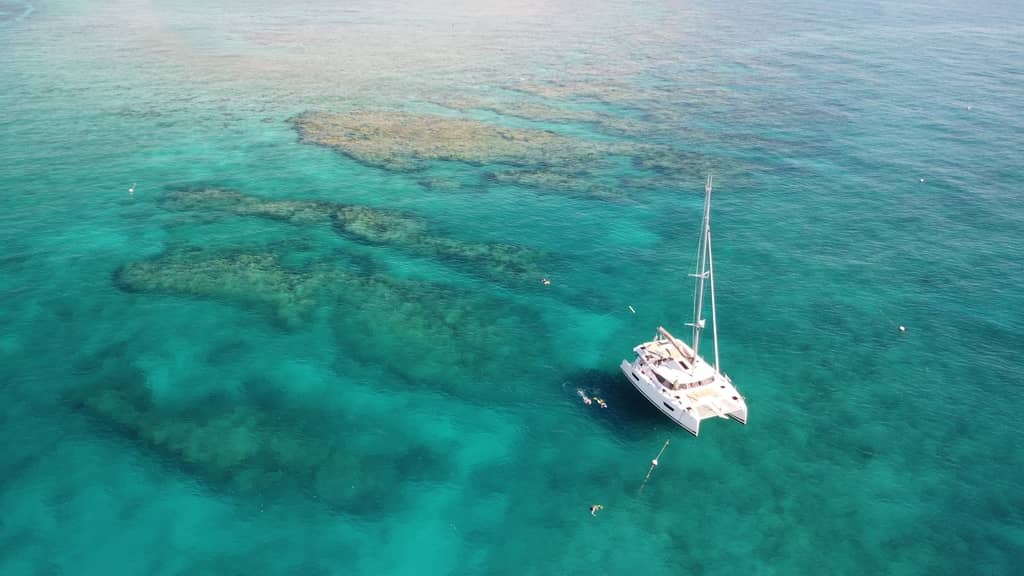
>>Also Read: How Much Does It Cost To Live On a Boat
Things to Keep in Mind before Choosing the Liveaboard Life in Florida
First and foremost, a harsh reality: Florida is one of the least welcoming states for liveaboard boaters. This is because the cost of a slip is high, and just a few marinas allow individuals to live on their boats. When you add in the constant flux of regulations on where liveaboard boaters can stay and anchor, you will feel totally confused.
Note that slips fill up quickly during the hectic winter season. Cruisers are known to plan their winter vacations months in advance. So don’t be surprised if you have to try a few marinas before finding the ideal for your needs. When you factor in the difficulty of finding a location that permits you to live onboard, keep in mind that you will have to do a lot of research beforehand. You should, of course, go to the marina before showing up or making a reservation.
Even the word “liveaboard” might raise a red flag for many dockmasters when asking about slips. Every marina dockmaster dreads the idea of a boat that is no longer seaworthy and is being used as nothing more than a cheap floating hotel. Which is also a recipe for an unattractive and environmentally disastrous situation. These boats have tarnished the term to the point where every marina interaction feels like walking on thin ice. Before agreeing to lease you a slip, more savvy dockmasters may want photos of your boat and confirmation of insurance. Don’t be surprised if you feel as if you’re being interviewed for the position—you are.
It’s almost always easier for a dockmaster to simply say, “No, we don’t allow liveaboards,” than putting out a cohesive and fair plan to allow only “good” liveaboards. Dockmasters aren’t the only ones who impose restrictions on slip holders. Living aboard a boat is prohibited in many Florida communities. Moving around with your boat is a way to prevent all these from happening. Every marina has a favorite type of liveaboard boater: the cruiser. You may sometimes get quarterly dockage rates if you stay for one, two, or even three months at a time, and you are more or less free of the hassles associated with the Florida “liveaboard” cliché.
Bear in mind that in popular anchorages throughout Florida, many communities install mooring fields. The problem of derelict and abandoned vessels at anchor is one element contributing to the trend. Cleaning up the sunk or beached vessels following storms has become a state-wide issue. So, the state can use mooring fields to set legal restrictions on where you can anchor. Moorings are a tempting choice because they save a lot of money over dock space. Some mooring sites offer shuttle services and are highly accommodating to liveaboards. While they like to reserve the majority of the moorings for passing boats, they usually have a more appealing month-to-month cost. And, if you want to anchor, there are still lots of options.
Hurricane Season in Florida
The marina’s location and storm policies are also important factors to consider when looking for a marina. Don’t think you’ll be fine if you leave your boat in the slip. Even if the insurance provider does not demand it, every Floridian should have an emergency plan in place before time. A few marinas have built-in “hurricane holes” where you will be able to leave your boat safely. It should have heavy-duty pilings atop floating docks and be sheltered from all directions from winds and tides. Even still, if a powerful storm makes landfall nearby, there’s a good possibility that it will destroy a lot. This is because the state of Florida is flat, and storms can be severe.
Some marinas with less protection may have an evacuation policy. To put it another way, they’ll inform you that you have to leave your boat at their marina in case of emergency. Keep in mind that this will happen with three days’ warning or less. Preparing a boat for a storm may entail transporting it hundreds of miles or removing it from the sea. So, it’s important to prepare ahead of time and be aware of what you’re going to do in case of a storm or hurricane .
>>Also Read: Living on a Boat in California: What you Need to Know
Living on a Boat in Florida – The Bottom Line
As you can see, liveaboard life in Florida can be amazing if you play your cards right. Hopefully, one of the marinas in Florida will cover your needs. However, it’s difficult to give a definitive answer for the best marina in Florida. Every marina has its own set of regulations and restrictions. In addition, what may be ideal for you may not be ideal for someone else. It all depends on your budget, needs, and on your boat. Of course, you’re in luck if you work from home and have the freedom to live wherever you like.
Keep in mind that some of the marinas in the north are far less expensive and quieter than marinas in South Florida. They provide a much slower pace of living. On the other hand, they don’t provide as many chances for jobs or recreation. On South Beach, there is more to do than in the north. Remember that if water and electricity aren’t included in the lease, you’ll need to receive a quote before deciding on a location to live in. It may appear to be less expensive at first, but once all the other costs are factored in, it becomes significantly more costly.
I hope that this article has helped you find out whether or not you want to liveaboard in Florida. It is totally feasible and it can also be cheap if you choose the right marina and location. I wish you all luck with your research!
Peter is the editor of Better Sailing. He has sailed for countless hours and has maintained his own boats and sailboats for years. After years of trial and error, he decided to start this website to share the knowledge.
Related Posts

Sailing with Friends: Tie Knots, Navigate the Seas and Create Unforgettable Memories

Best Spearfishing Spots in Miami

Best Boating Destinations in the Florida Keys

Best Boat Generators
- Buyer's Guide
- Destinations
- Maintenance
- Sailing Info
Hit enter to search or ESC to close.
No boat? 5 best places to catch a snook from land on the Treasure Coast

Here are five tips, spots and baits to catch the Treasure Coast's most popular game fish.
Sebastian Inlet State Park: Fish from 2 jetties, catwalks and T Dock. Live croaker or mojarra.
Barber Bridge Catwalk: On Vero Beach's lagoon. Live mullet. Fish shadow line at night.
Fort Pierce Inlet Jetty: Cast a live shrimp during incoming tide.
Jensen Beach Causeway: Fish outgoing tide after dark with live bunker. Cast to bridge fenders.
Roosevelt Bridge: Use 1-ounce chartreuse flare hawk jig. Cast up-current.
Ed Killer is an outdoors writer for TCPalm. Email him at [email protected].
You Can Help Migrating Fish Traverse a Dutch Canal By Ringing This Digital ‘Doorbell’
The live stream from the Netherlands, which lets viewers notify a boat lock operator when fish need to be let through, has become a popular pastime for people around the world
Aaron Boorstein
Staff Contributor
:focal(484x277:485x278)/https://tf-cmsv2-smithsonianmag-media.s3.amazonaws.com/filer_public/c4/39/c4393379-7fd1-498f-8d71-db87f633768b/screenshot_2024-04-11_at_120403_pm.png)
In 2020, ecologist Mark van Heukelum was strolling through Utrecht in the Netherlands, when he noticed that fish had congregated in a canal on one side of a 200-year-old boat lock, writes the New York Times ’ Callie Holtermann. Since boats do not usually travel through the city’s canals in the spring, the lock hadn’t been opened, and the creatures were trapped behind it.
“In the early spring, when the water gets warmer, some fish species migrate to shallower water, and they swim right through the center of Utrecht looking for a place to spawn and reproduce,” ecologist Anne Nijs tells BBC Wildlife ’s Melissa Hobson.
But the lock cuts off the animals’ progress—and waiting near it puts fish in a life-threatening position. When fish are stuck in the canal, predators like grebes and cormorants can more easily snatch them.
To help fish migrate safely during the canal’s quiet season, Nijs and van Heukelum came up with an innovative solution: the fish doorbell (or de Visdeurbel in Dutch). Launched in spring 2021, the webpage features a live stream from an underwater camera, allowing viewers worldwide to check for fish waiting at the closed lock—then, they click a pink button on the site when the animals appear on screen.
Each time a user “rings” the doorbell, the service snaps a picture of the fish and sends it to a team of ecologists. After enough fish are waiting, they notify the lock’s operator that the gate should be opened.
Nijs and van Heukelum worked with Utrecht’s government and local water authorities to establish the doorbell strategy.
“We live in a country which is partly below sea level. And we build a lot of dams and dykes and locks, which is great, because it keeps our feet dry. But at the same time, we create many, many obstacles for fish,” van Heukelum tells NPR’s Weekend Edition Saturday .

Now in its fourth year of operation, the doorbell usually runs between March and late June . With predators more active during the daytime, the website recommends visiting the live stream at night to spot fish swimming in the safety of darkness.
When the doorbell first launched on March 29, 2021, many Utrecht residents thought it was an April Fools’ joke. But now, it has become widely popular. This year, the fish doorbell has had roughly 1.2 million unique users since March 1, and its viewers have rung the doorbell more than 40,000 times.
“Some people are obsessed by it, and we receive a lot of fan mail,” Nijs tells BBC Wildlife .
While tuning in from the website is ideal, as that is the only place viewers can click the doorbell, the stream is also available on YouTube. The website can only host about 950 streamers at once, so any additional viewers get directed to the YouTube video.
Wildlife live streams, from cheetah births to beluga whale migrations , are often popular online for their educational and entertainment value—and the fish doorbell is no different.
“Somebody who had been very depressed and anxious reached out to me and said that the fish doorbell was the only thing that … could make her feel calm and distract her from difficult thoughts,” Nijs tells Scientific American ’s Riis Williams. “It really is so special for people to knowingly watch something with 900 other people around the world at the same time.”
Watching animals online can lead people to care more for wildlife, according to a 2018 study published in the Journal of Ecotourism . A pair of researchers investigated whether viewing live streams of brown bears at Alaska’s Katmai National Park and Preserve yielded positive environmental sentiment. They wrote that “the ability of online viewing to generate a positive emotional connection to bears was observed.”
With the doorbell in particular, people around the world can have a direct impact on the wildlife they see in the live stream—which is a large part of its success, Lisa Brideau , a climate policy specialist in Canada, tells the New York Times . But with the live stream’s legion of existing users, she suggests that people look for other ways to help wildlife closer to home.
“The doorbell is covered,” she tells the publication. “Where else can we put this energy?”
Get the latest stories in your inbox every weekday.
Aaron Boorstein | READ MORE
Aaron Boorstein is an intern with Smithsonian magazine.
Crews rescue 4 from capsized boat off San Francisco coast
By nbc bay area staff • published april 14, 2024 • updated on april 14, 2024 at 2:08 pm.
Crews rescued four people from a capsized boat 3 miles off the coast of San Francisco’s Ocean Beach Sunday morning, according to firefighters.
The San Francisco Fire Department added that all four are reportedly stable, and will be evaluated by medics.
It’s unclear exactly when the boat capsized, but the department first reported it on social media at 9:34 a.m.

‘Glad you were there': Life-saving act in San Francisco turns strangers into friends

San Francisco business owner goes on hunger strike over new bike lane
Get a weekly recap of the latest San Francisco Bay Area housing news. Sign up for NBC Bay Area’s Housing Deconstructed newsletter.
The department carried out rescue operations in conjunction with the U.S. Coast Guard Pacific Area and the California Highway patrol.
The coast guard is expected to have more information about the boat and what led to it capsizing.
UPDATE @USCGPACAREA and @SFPD marine unit rescued four subjects from this incident 3 miles off the coast of San Franciso Bay. The four subjects will be taken to waiting Marin County EMS units for evaluation. All are reported to be stable. The @USCGPACAREA will have further… https://t.co/IERBaX7TBQ pic.twitter.com/5tZs7s65bl — SAN FRANCISCO FIRE DEPARTMENT MEDIA (@SFFDPIO) April 14, 2024
This article tagged under:
- Share full article
Advertisement
Supported by
3 Men Rescued from Pacific Island After Writing ‘Help’ With Palm Leaves
American rescuers found the lost sailors on a tiny uninhabited island in Micronesia with a damaged boat and the word spelled out on the beach.

By John Yoon
Three men who were stranded on a remote Pacific island for more than a week were rescued by the U.S. Coast Guard after spelling out “HELP” on a beach using palm leaves.
The lost men were found on Pikelot, an uninhabited island about 100 miles northwest of their home, alongside their damaged boat on Sunday by an American military aircraft, the U.S. Coast Guard Sector Guam said in a statement .
The men, who were experienced mariners in their 40s, set sail on March 31 from Polowat Atoll, an island that is part of the Federated States of Micronesia, in a 20-foot open skiff powered by an outboard motor. After their unintended delay, the Coast Guard said, the men had been safely returned home Tuesday evening.
The search began on Saturday when a woman sent out a distress call to the Coast Guard, reporting that her three uncles had not returned home after almost a week away. The Coast Guard embarked on the search with a U.S. Navy aircraft crew.
Pikelot is a tiny dot in the Pacific Ocean covered in palm trees and bushes, measuring less than 2,000 feet in length. The Micronesian island was part of a search area that the Coast Guard said spanned more than 100,000 square miles.
This week’s rescue was not the first from Pikelot involving huge letters spelled in the sand. In 2020, three other men whose boat ran out of fuel wrote “SOS” in the sand , allowing them to be spotted by American rescuers.
In this week’s search, a breakthrough came when a Navy reconnaissance aircraft that was dispatched from Okinawa, Japan, spotted the men from the air.
“In a remarkable testament to their will to be found, the mariners spelled out ‘HELP’ on the beach using palm leaves, a crucial factor in their discovery,” Lt. Chelsea Garcia, who coordinated the search and rescue mission on Sunday, said in the statement.
The aircraft crew deployed survival packages to help the men before the Coast Guard dropped them a radio a day later from a military aircraft sent from Hawaii, establishing a line of communication.
“They expressed a desire for assistance in returning to Polowat,” the Coast Guard said, adding that the men had said they were in good health and had access to food and water, but that their skiff had been damaged and its engine was not functional.
On Tuesday, a Coast Guard ship, the USCGC Oliver Henry, arrived at the island and picked up the men to bring them home.
“It’s incredibly rewarding to see the faces of those we’ve helped,” said Lt. Ray Cerrato, the commanding officer of the ship.
A similar rescue also took place in Micronesian waters in 2016 when three men whose boat was overturned swam two miles to reach a tiny island, on which they wrote “HELP” in the sand . The Coast Guard rescued them.
Two other people who went missing later that year were saved from a Micronesian island after writing “SOS ” in the sand.
John Yoon is a Times reporter based in Seoul who covers breaking and trending news. More about John Yoon

IMAGES
VIDEO
COMMENTS
Living on a sailboat full-time is a journey that encompasses the full spectrum of human experience, blending moments of sheer joy and beauty with times of challenge and adversity. It's a lifestyle that demands resilience, adaptability, and a willingness to embrace the unknown. While the romantic allure of sailing the high seas is undeniable ...
Essentials: Stowage, Comfort & Connectivity. When you move from a 2,000-square foot house to a 40-foot boat, all the closets are smaller, the cupboards are fewer and there's no two-car garage. In preparation, you'll need to de-clutter kitchen gadgets, tools, mementos and clothing. Keep winter clothes in off-boat storage and your business ...
The liveaboards in question are those that live at the marina. They keep their car and get their mail there. They don't have a physical house—their boat is their home, and they don't go anywhere on it. This type of living aboard is often problematic for marina owners because it changes the vibe of the marina.
Living on a sailboat is possible if you find the right boat, stay organized, manage maintenance and utilities effectively, make an income, and choose a suitable marina. Anyone who follows these steps can live a frugal and comfortable life on a sailboat. In this article, we'll cover all the major points and lifestyle adjustments necessary to ...
Cost of Living on a Boat in a Marina. Living on a boat in a marina involves understanding the costs tied to the slip fees and the expenses for day-to-day life afloat. You'll also navigate through budgeting, taxes, and insurance. Understanding Marina Fees and Rates. Marina costs vary depending on location, amenities, and the size of your slip.
Marinas tend to be a lot more sheltered than more open anchorages, so living in a marina means the boat moves around a lot less. But obviously it still moves a lot more than when you live in a house! Living in a marina comes with the benefit of unlimited water and electricity, just like in a house.
One parting thought: Living on a boat full time and traveling is like having three or four full-time jobs. Each requires 30-40 hours per week when you include labor, research, and thinking and planning. Boat ownership — basic maintenance and cleaning. Cruising full-time — destination and route planning, weather study.
Setting the Anchor: Drop the anchor, release enough rode, and slowly reverse the boat to firmly set the anchor in the seabed. Give it a strong tug to confirm that it is securely in place. 6. Docking: Practicing docking skills is essential to safely maneuver your boat into a slip or alongside a dock.
Important Things To Deliberate When Living On A Sailboat Full Time. 1. The Essentials. You may leave your 2,000 square foot house for a 40-foot boat. When it happens, expect that cupboards are fewer, closets are smaller, and you won't have as much space as before.
2. Necessary Space for Full-Time Boat Living. When you decide to embrace the full-time boat living lifestyle, you're not just choosing a unique way to live; you're also embracing a more minimalist and compact way of life. On a boat, space is at a premium, and every inch must be carefully considered and utilized to ensure comfort and ...
Liveaboard Marina Amenities. As mentioned, the primary difference in marinas is the location. The marina's quality in terms of its security amenities and services (and the people and boats) plays a role in pricing. In the best marinas, you'll find everything you need to enjoy a comfortable lifestyle on a boat.
Boat Life 101: How to Live on a Boat and Travel the World! (2024) Waves lap at the hull of the boat. Your feet are in the glassy water, a glass of rum in your hand, and a glorious sunset in front of you. Of course, the weather is perrrfect. Just another day in the life of living on a boat.
Hopefully you'll find that the pros far outweigh the cons. Pros such as privacy, freedom, and adventure top my sailboat living list. Some cons are cramped living space, having your home rock when the weather turns nasty, and small living space. There are many variables to consider when creating a list of pros and cons for living on a sailboat.
One philosophy in getting started living aboard a sailboat is to start small, start now. That doesn't mean you have to buy a major refit project of a sailboat. You can get started in a small 24 foot single cabin boat for less than $10,000 or a mid-size 36 foot sailboat (see video below) for less than $60,000. Or grab a 1980s fixer upper that ...
Overall each boat is designed differently and some have more storage then others. My sailboat is 38 feet long and has a moderate amount of storage for a boat its size, but I have also been on 36 foot boats with far more usable storage. The reality of living on a sailboat in a marina is you will have to downsize. Downsizing isn't really a bad ...
Watching the sunset every day is one of the best things about sailboat living. Then there's the sunrises and sunsets, and the endless starlit skies. The thunderstorms that you're suddenly a part of, when before you could hide inside brick walls. The constantly changing sea and sky, and the sun and wind.
You can get it cheaper but there are no recommended surveyors in Sicily so we made the decision to fly one in from the UK. That way there weren't any language barriers either. We were slightly unlucky that the marina the sailboat was in was such an expensive one to get a lift out, you can get lifted out for more like £200-£300 ($250 - $380 USD) in other boatyards.
The first cost to consider when living on a sailboat is the marina fees/slip fees. The marina costs for a sailboat are approximately $10 to $20 per foot per month. For example, a sailboat owner with a boat size of 30 feet will typically pay between $300 and $600 per month in slip fees to stay at a marina. A marina will charge a boat owner on a ...
Some people dream of completing a circumnavigation, while others stick to seasonal cruising. Whatever your goal, sailboats might not be the fastest way to travel, but they are certainly the most romantic. 4. Small Space Simple Living. On the one hand, boats and RVs are the mobile equivalents of the tiny house.
Seapath Marina and Yacht Club. Located in Wrightsville Beach in southeastern North Carolina, Seapath Marina is a premier transient stop that provides world-class floating docks including 190 slips and nearly 600 feet of face dock. This marina is strategically at the ICW and the all-weather inlet of Masonboro.
Although the idea of living on a boat might be freeing, it's anything but free. There are a ton of costs associated with the liveaboard life, which means you might spend just about as much as you would living in a traditional residence. Here's a breakdown of what you might expect to pay when you live on a boat:
Many marinas charge a transitory fee on a daily, weekly, or monthly basis, with discounts for longer stays. Annual slip holders, on the other hand, benefit from the best rates. In Florida, monthly slips for a 40-foot sailboat can cost anything from $800 to well over $2,000 per month.
Many readers have asked me about liveaboard boating in Belize. There is not an actual active, lively marina like you might see in Key West or other places in the Caribbean. We are technically living aboard at Robert's Grove, with shore power, the ability to fill up water tanks easily, and we have everything we need, so we are experiencing ...
CNN —. At least 20 severely decomposed bodies have been found in a boat off the coast of northeastern Brazil, officials say. The boat was found on the coast of Bragança, northeast of Pará, on ...
The homeless migrant who was busted joyriding on a historic FDNY fireboat and then swiping a sailboat for another leisurely ride was released without bail Friday — only to immediately try to climb aboard an even bigger ship in Manhattan, according to sources, who said immigration officials' hands are tied. Advertisement. Juan Hernandez, 22 ...
Here are five tips, spots and baits to catch the Treasure Coast's most popular game fish. Sebastian Inlet State Park: Fish from 2 jetties, catwalks and T Dock. Live croaker or mojarra. Barber ...
The live stream from the Netherlands, which lets viewers notify a boat lock operator when fish need to be let through, has become a popular pastime for people around the world.
Seen in 2022, a gamma-ray burst nicknamed the BOAT is believed to be the brightest explosion ever witnessed by humanity. But the James Webb Telescope's search for its origins has only thrown up ...
NBC Bay Area. Crews are working to rescue four people reportedly on or near a capsized boat around 3 miles off the coast of San Francisco's Ocean Beach, firefighters said Sunday morning. It's ...
April 11, 2024. Three men who were stranded on a remote Pacific island for more than a week were rescued by the U.S. Coast Guard after spelling out "HELP" on a beach using palm leaves. The ...